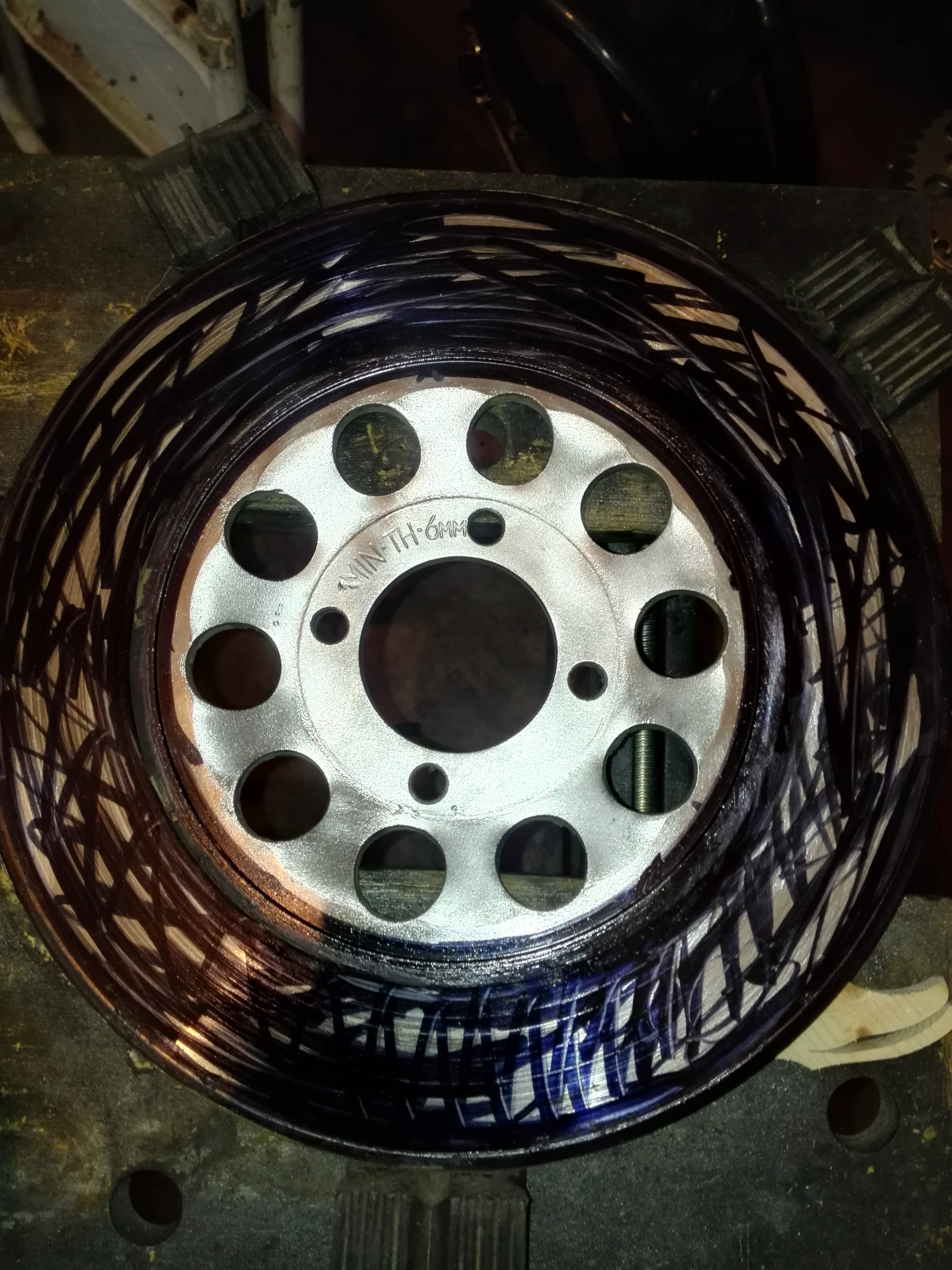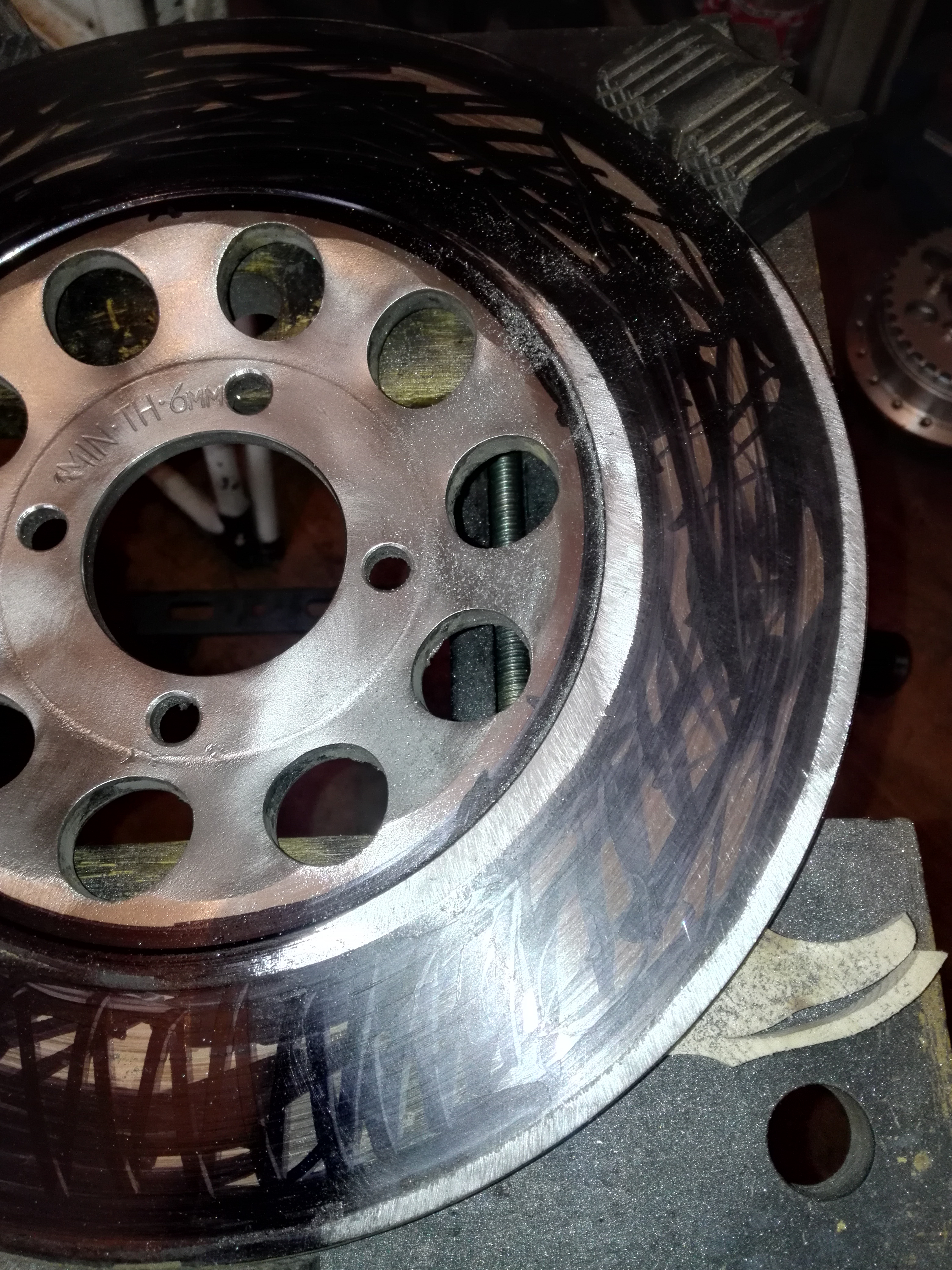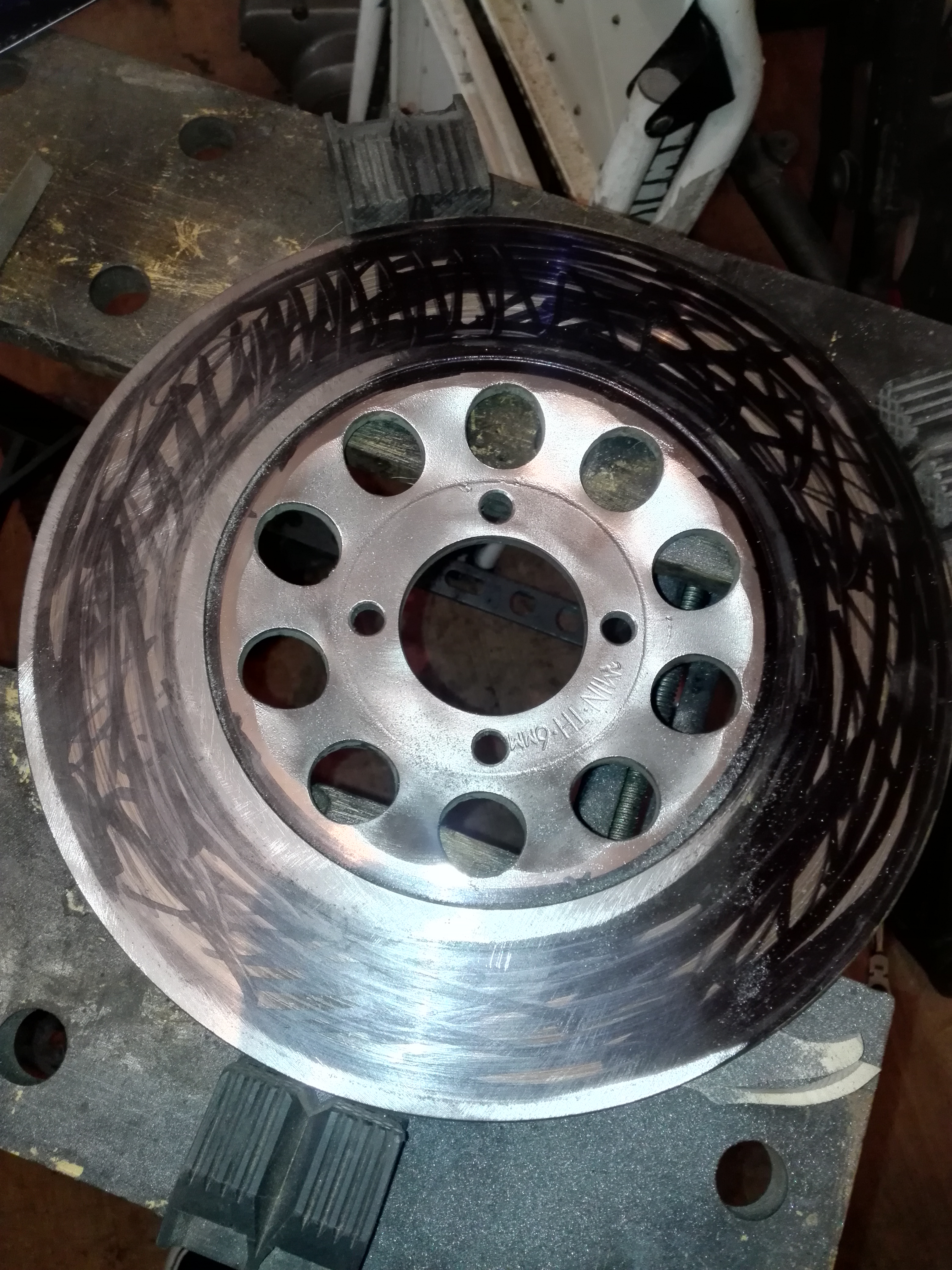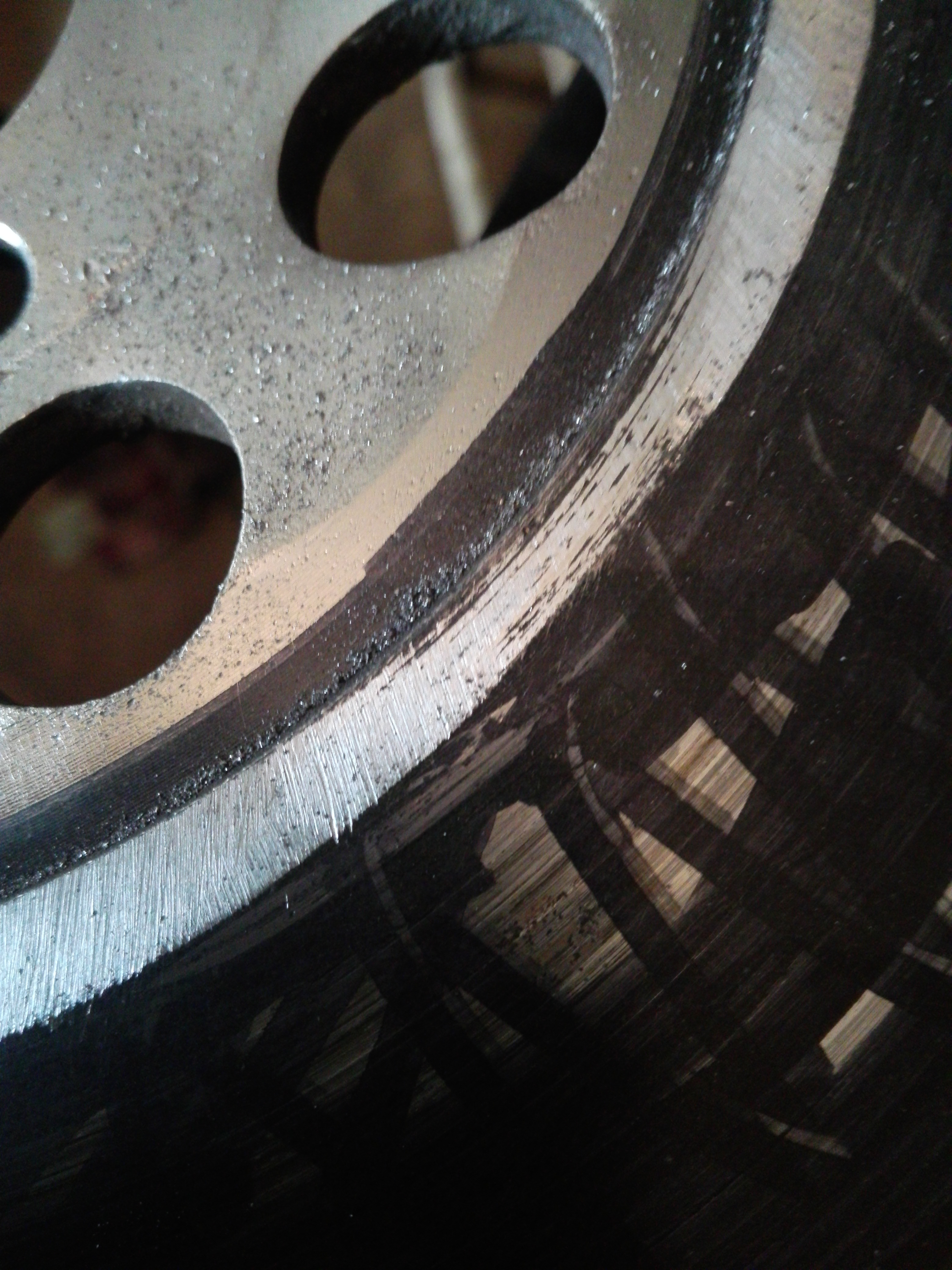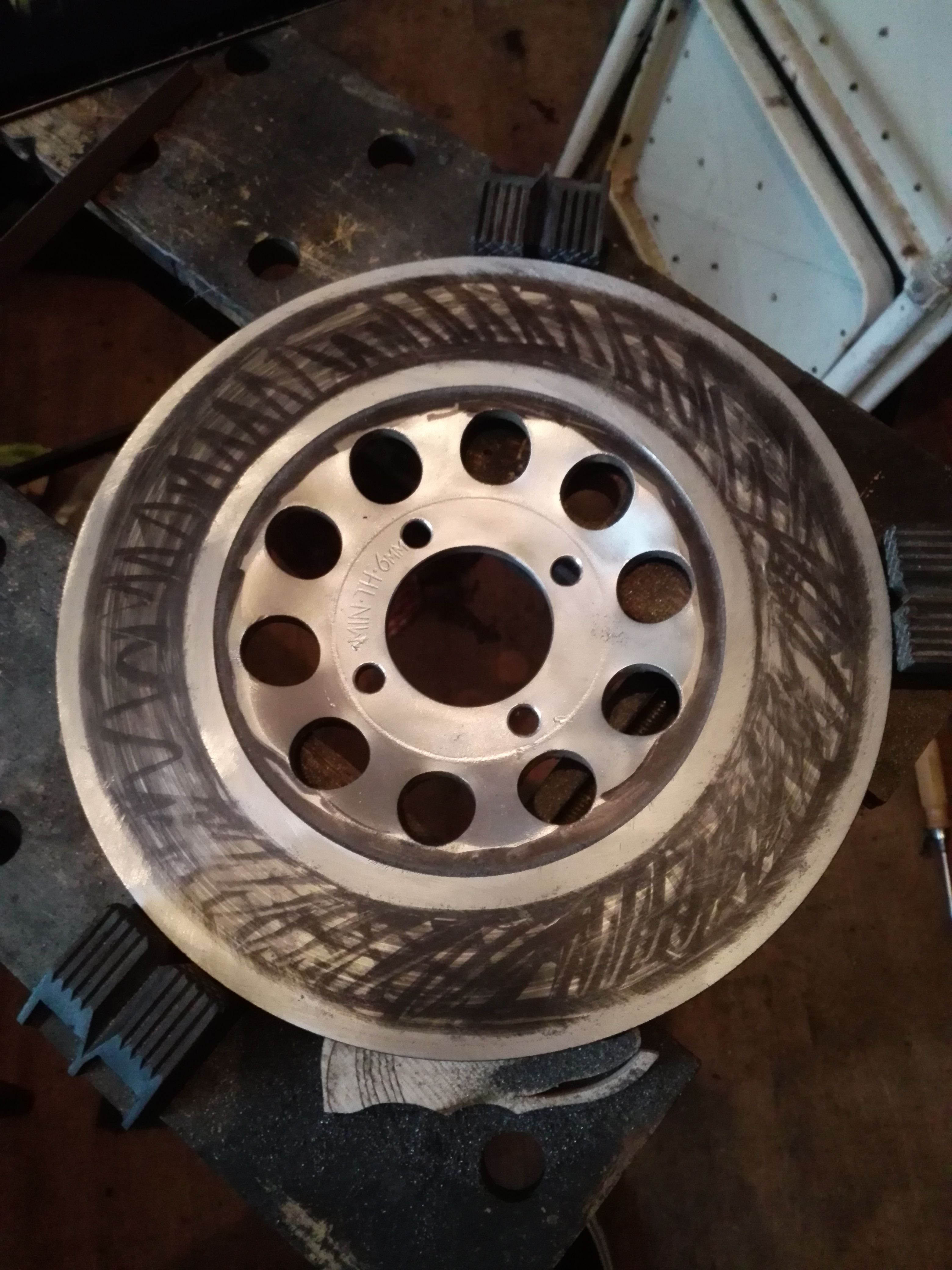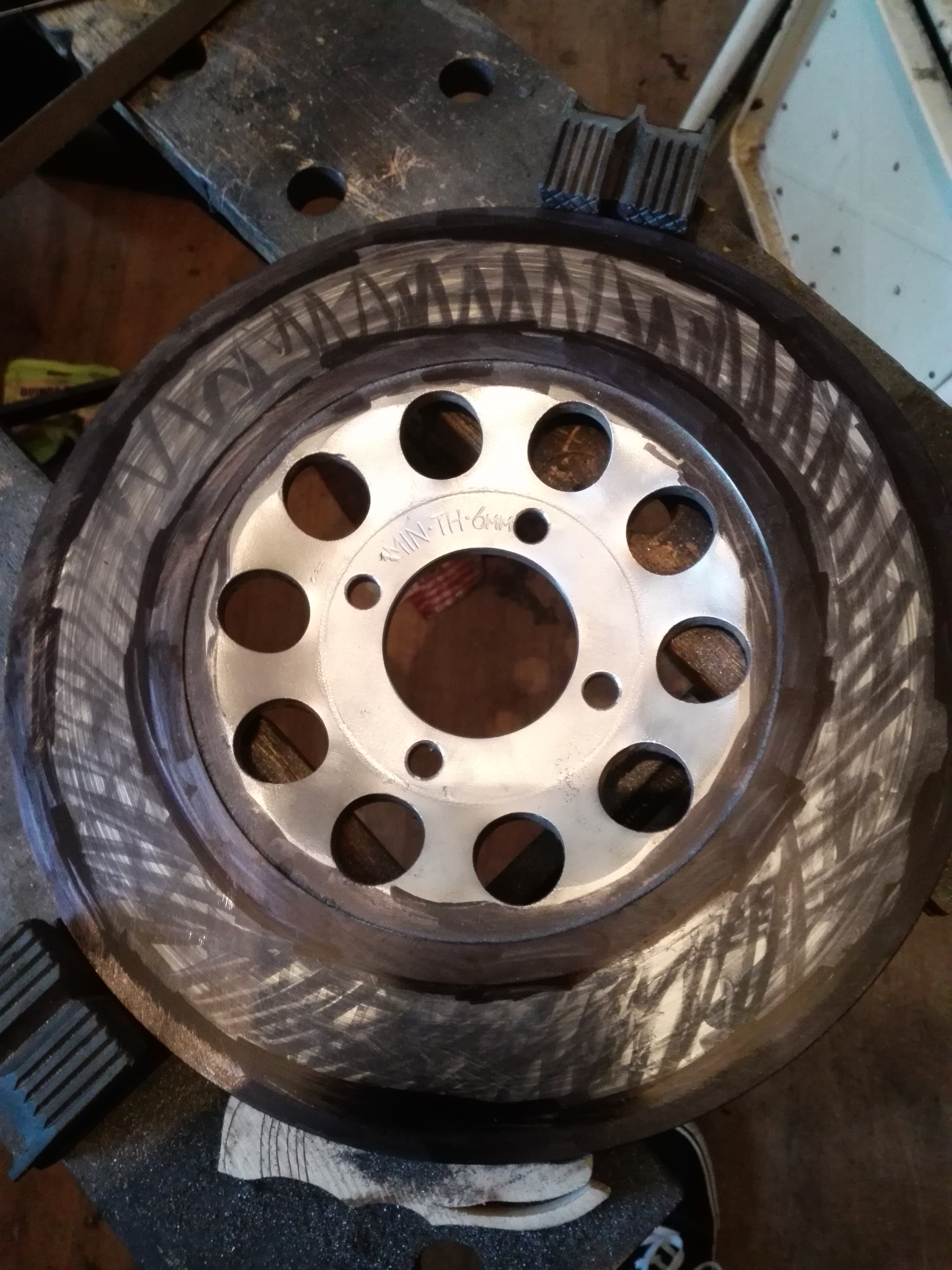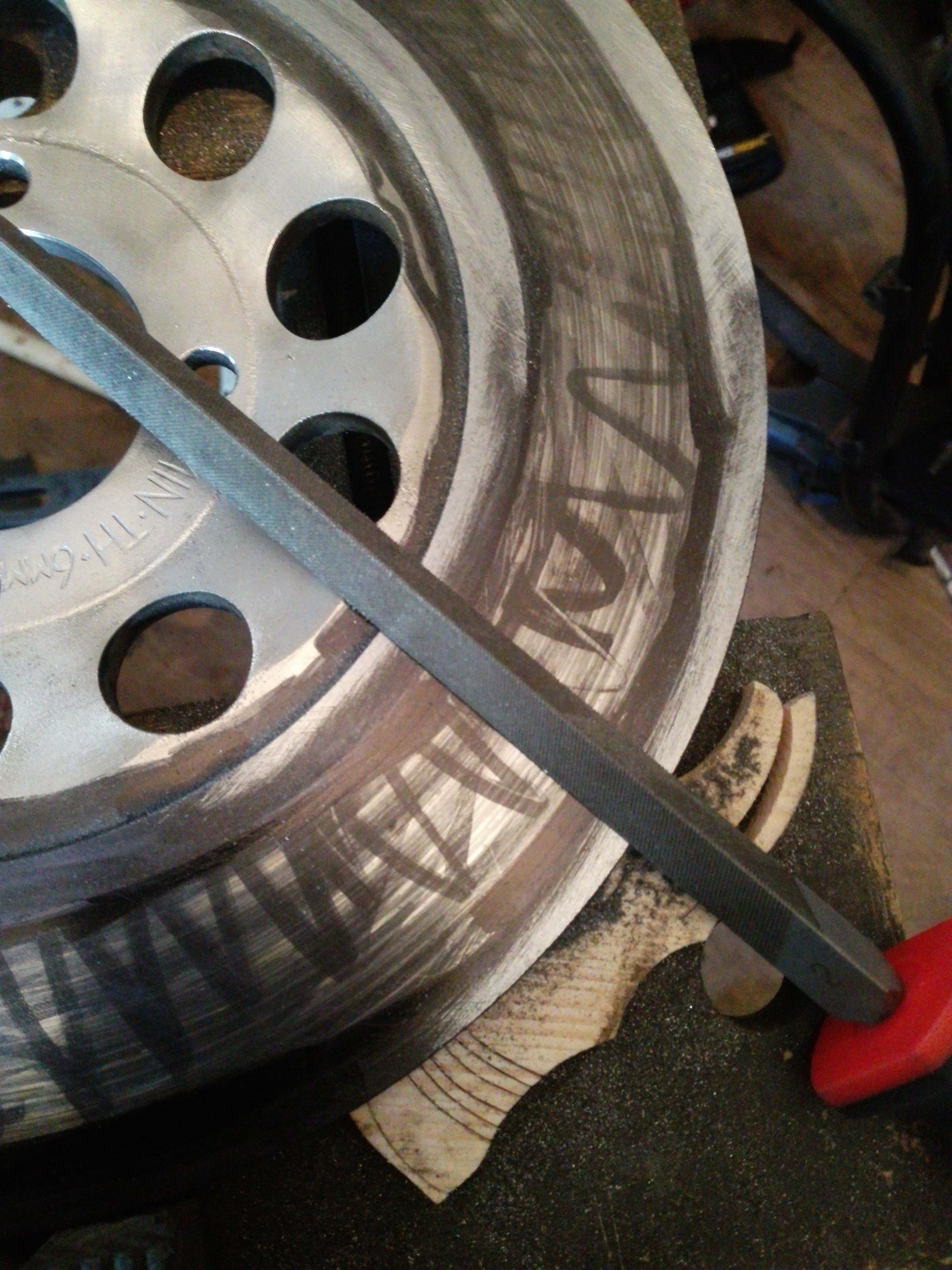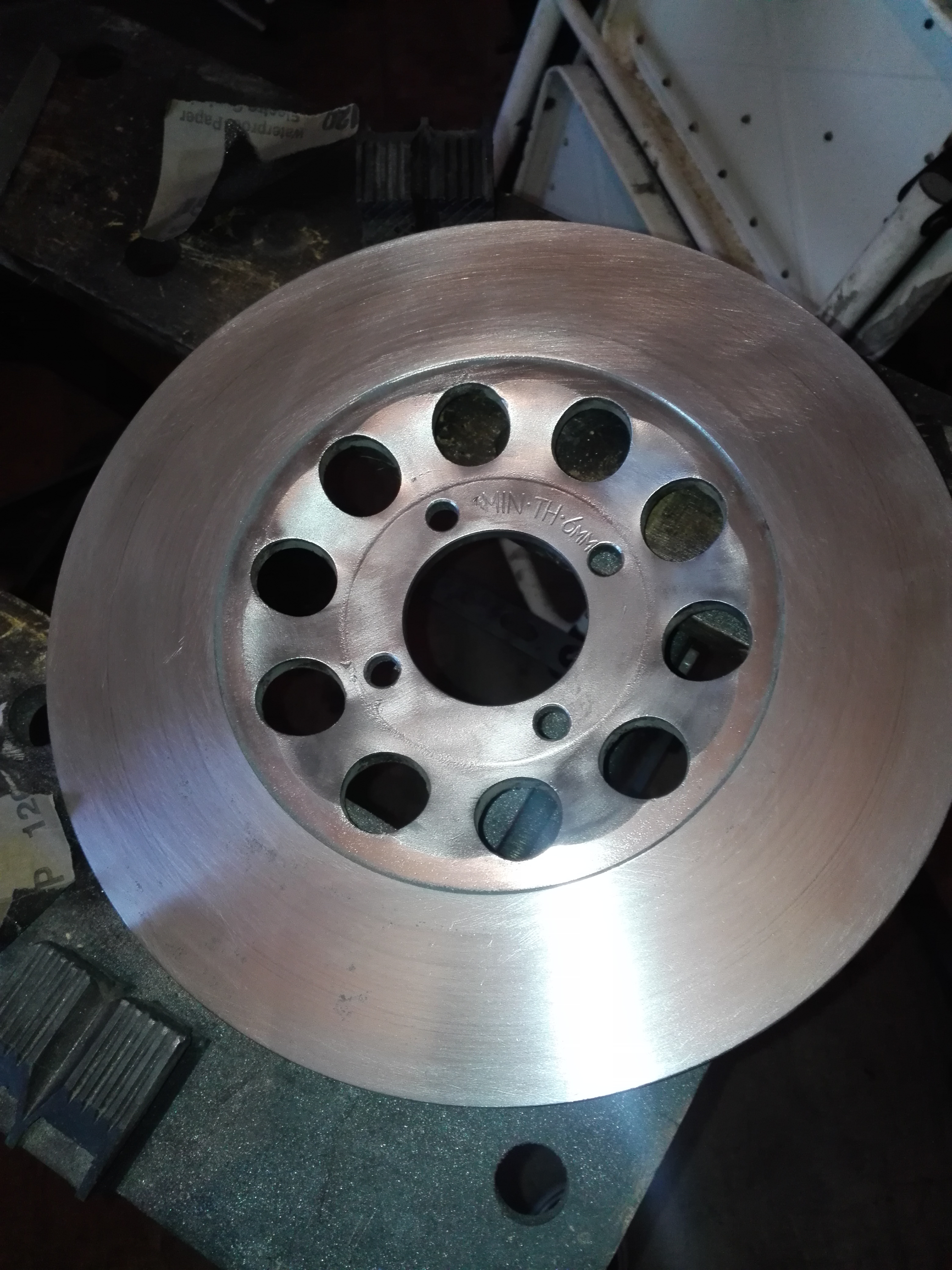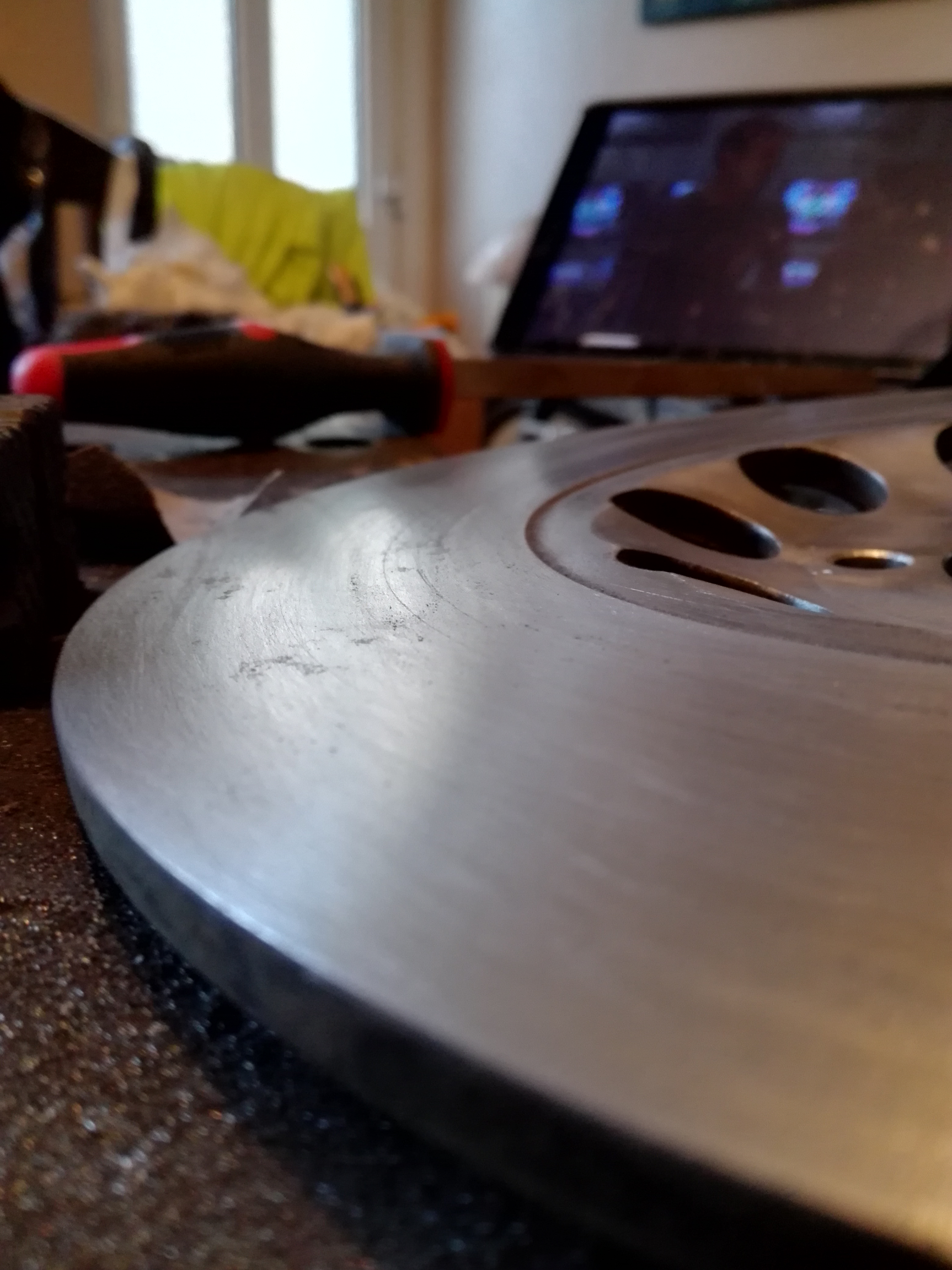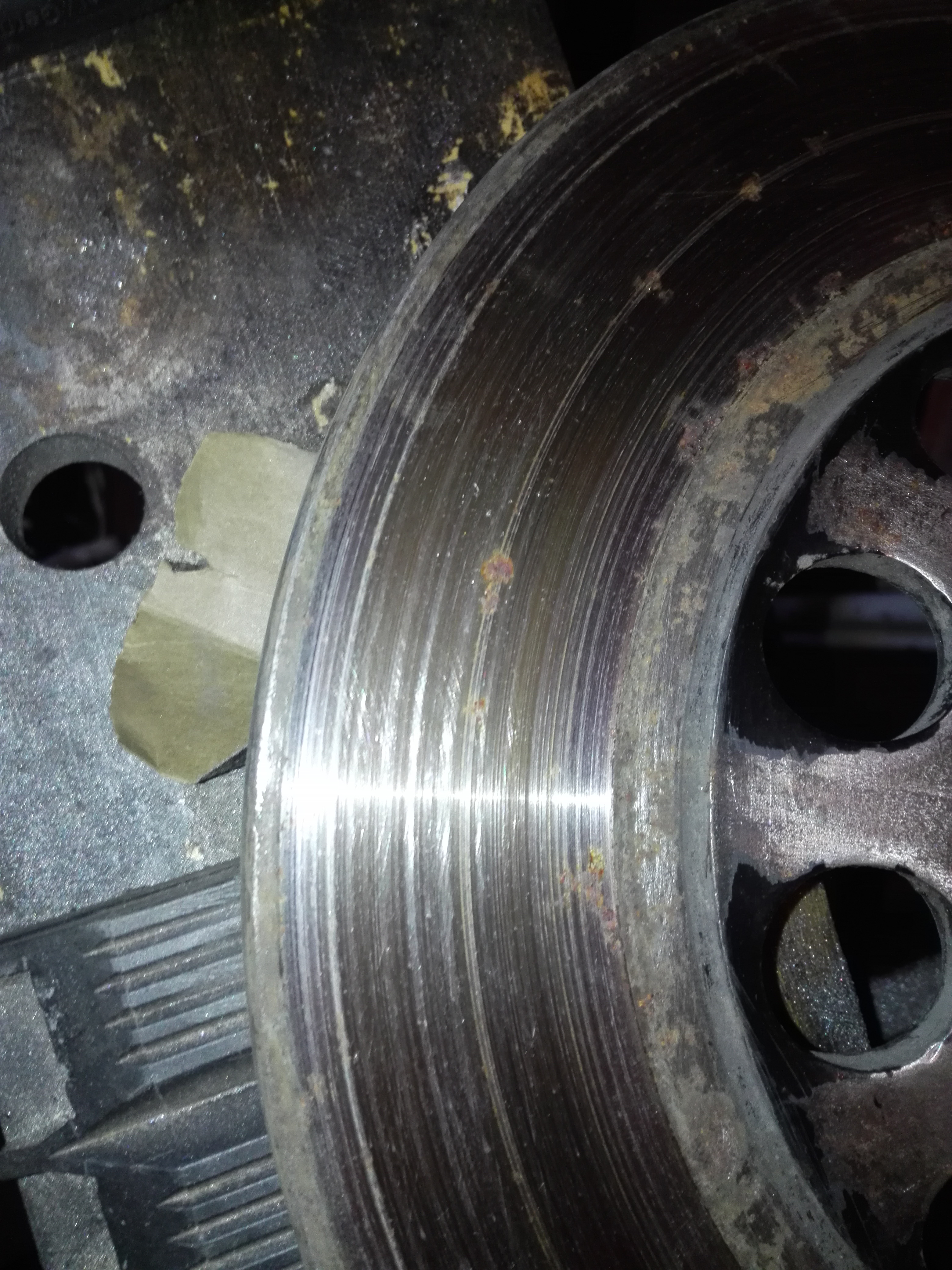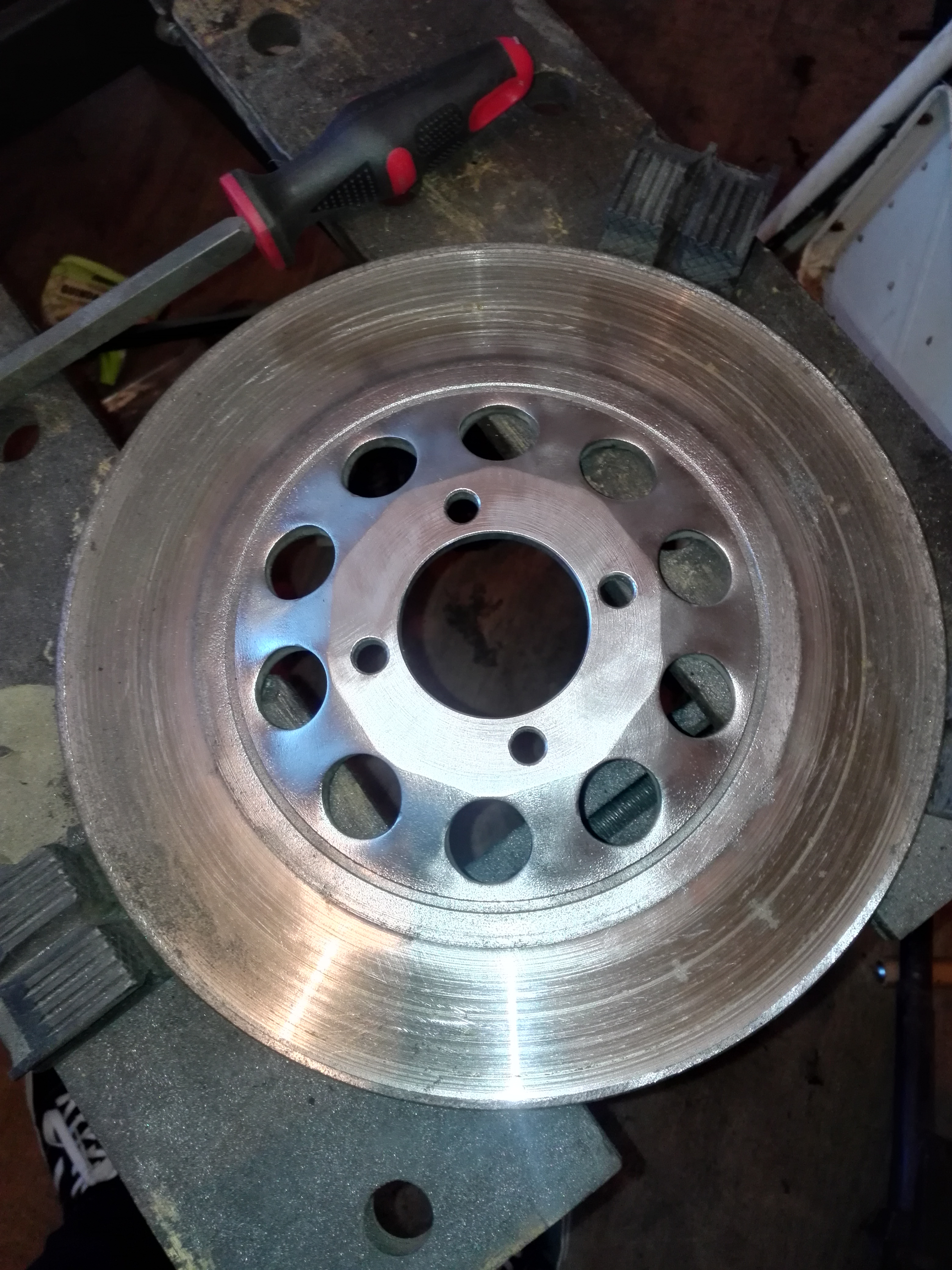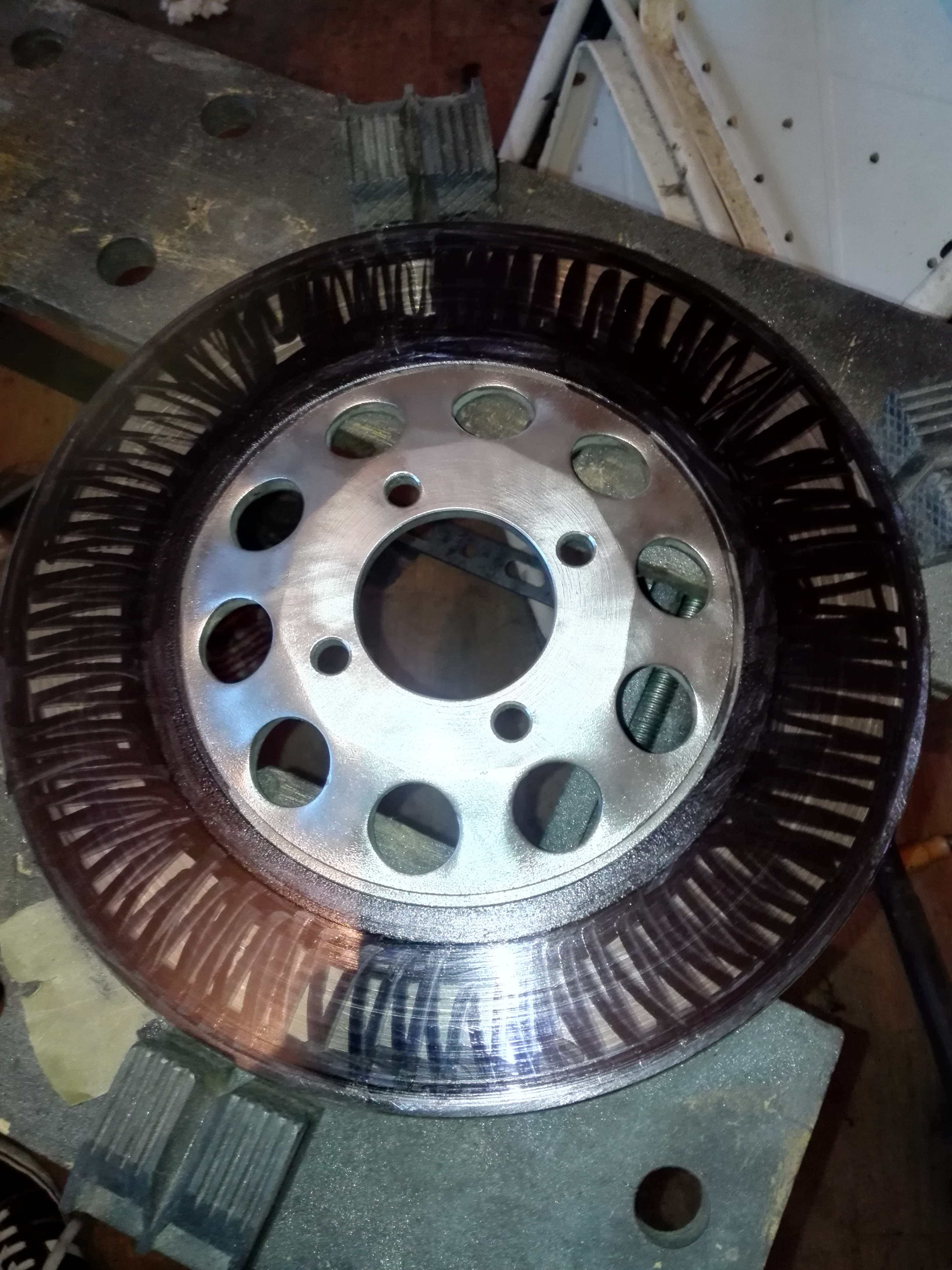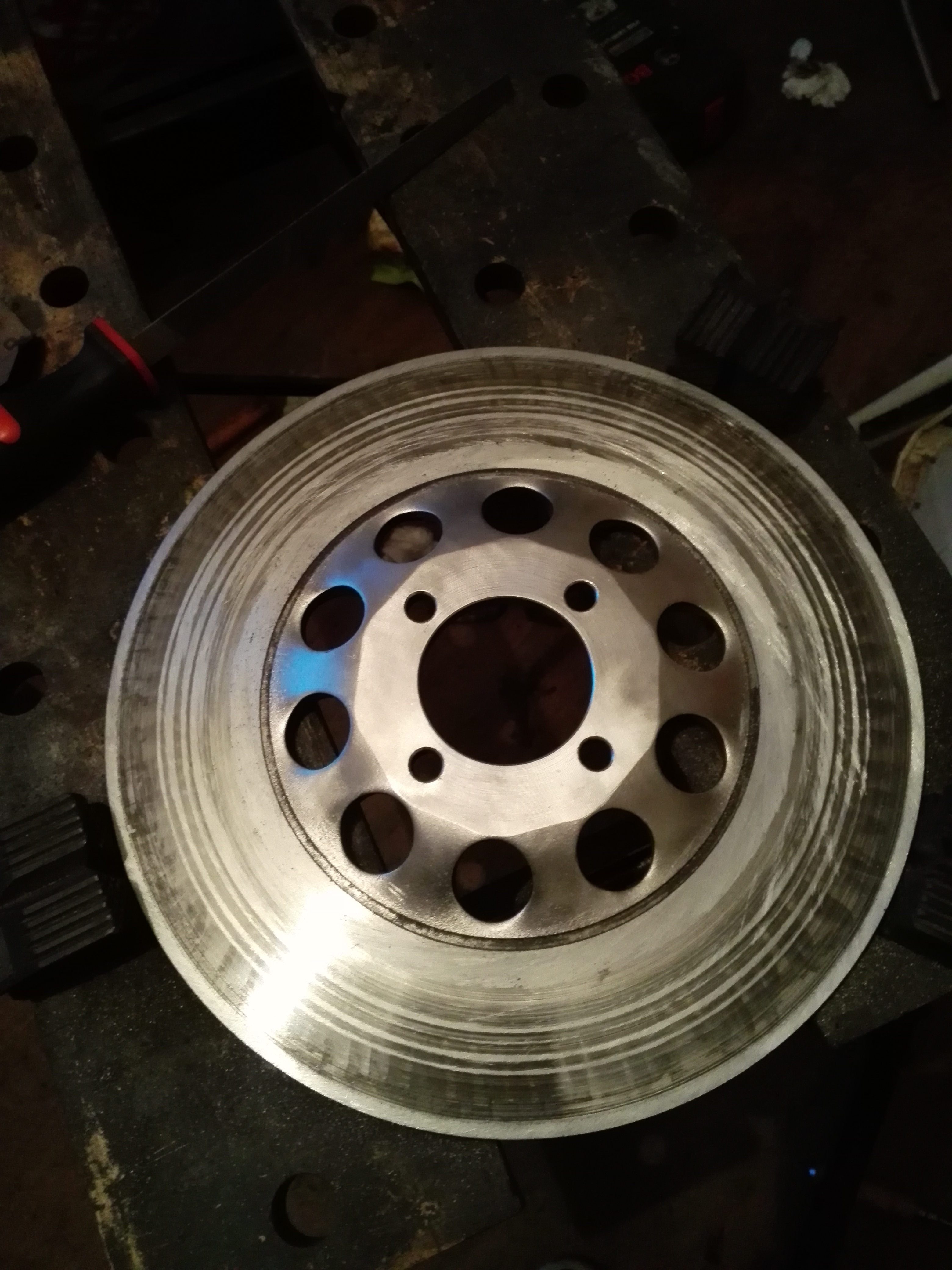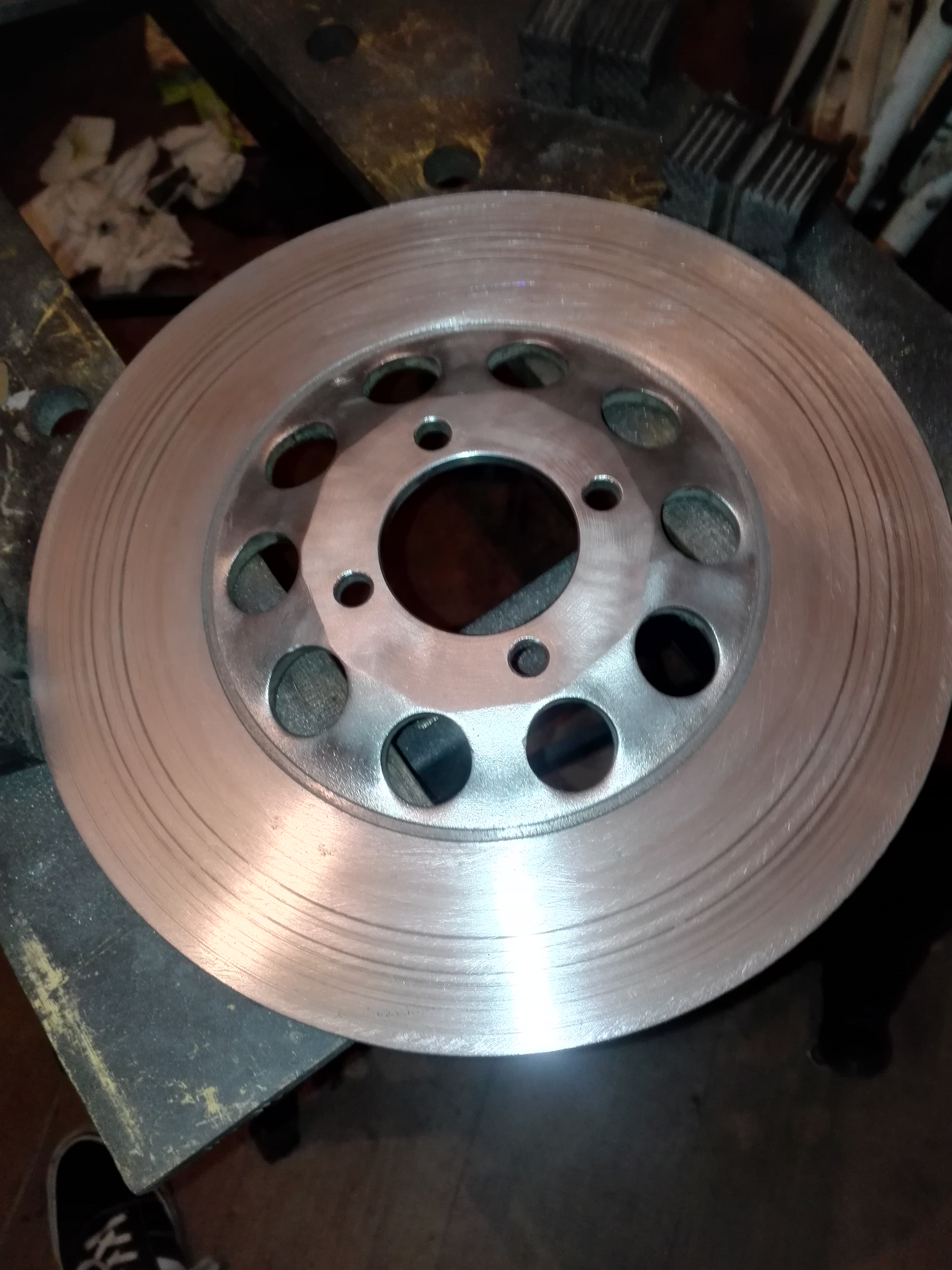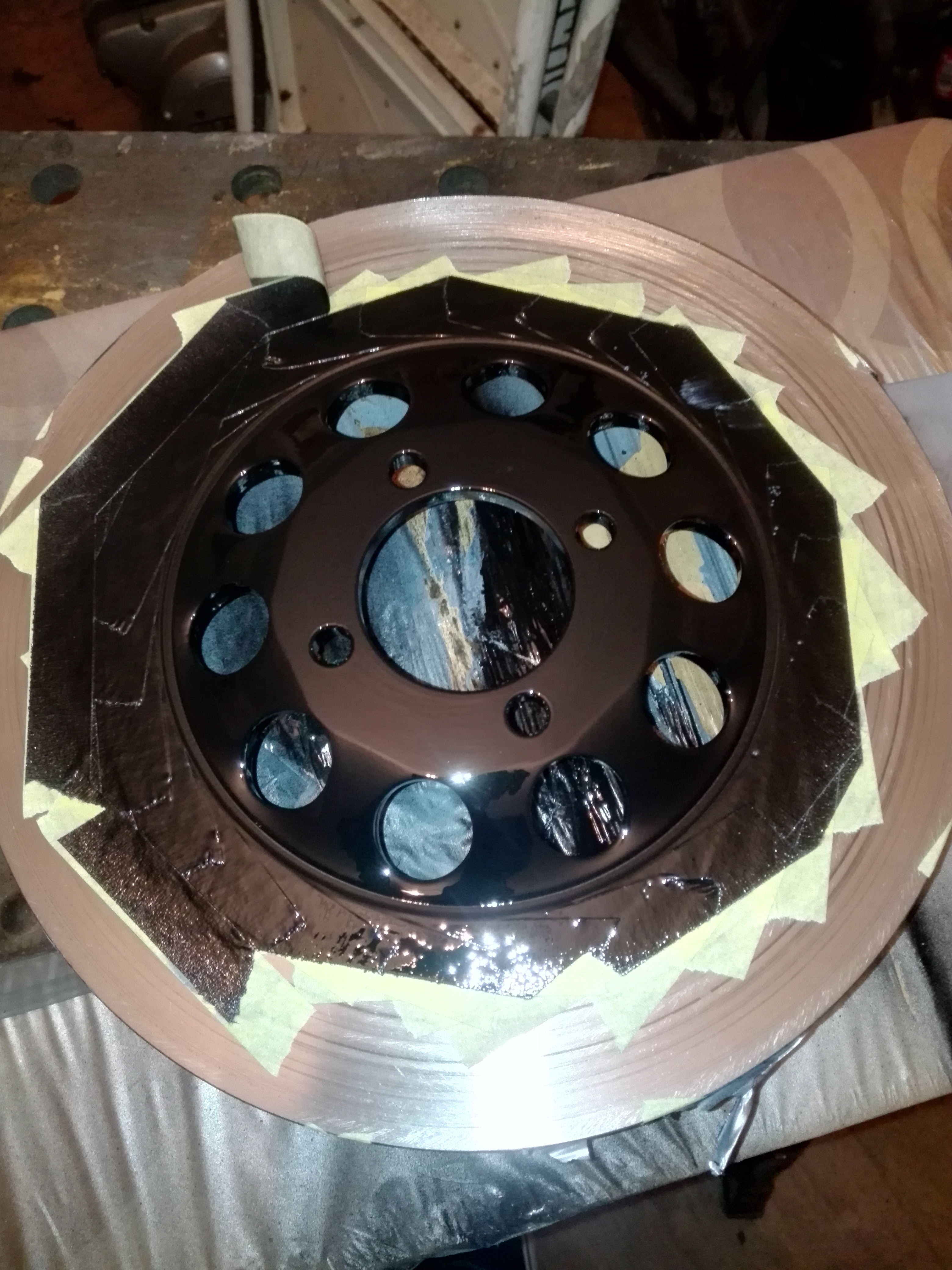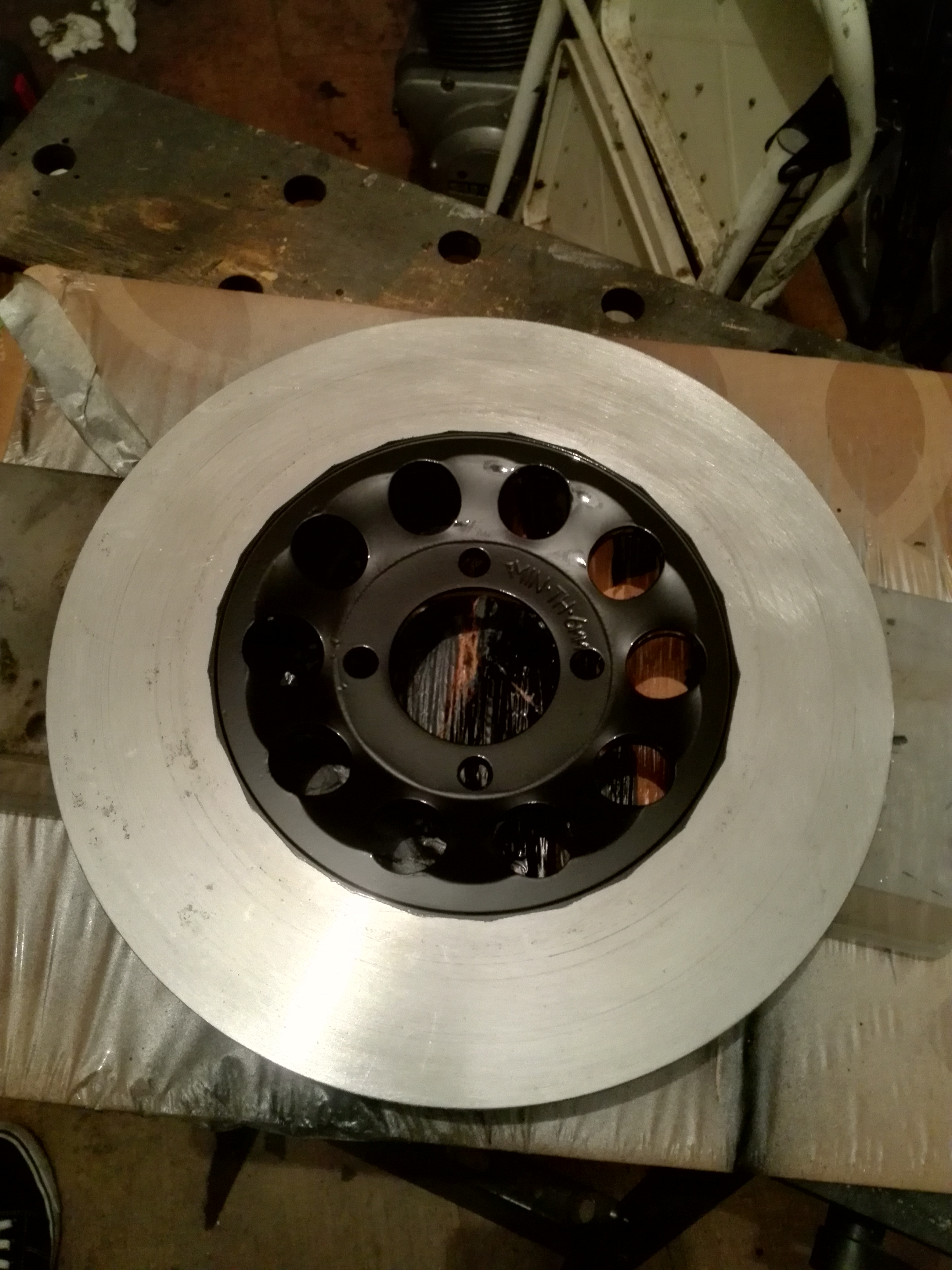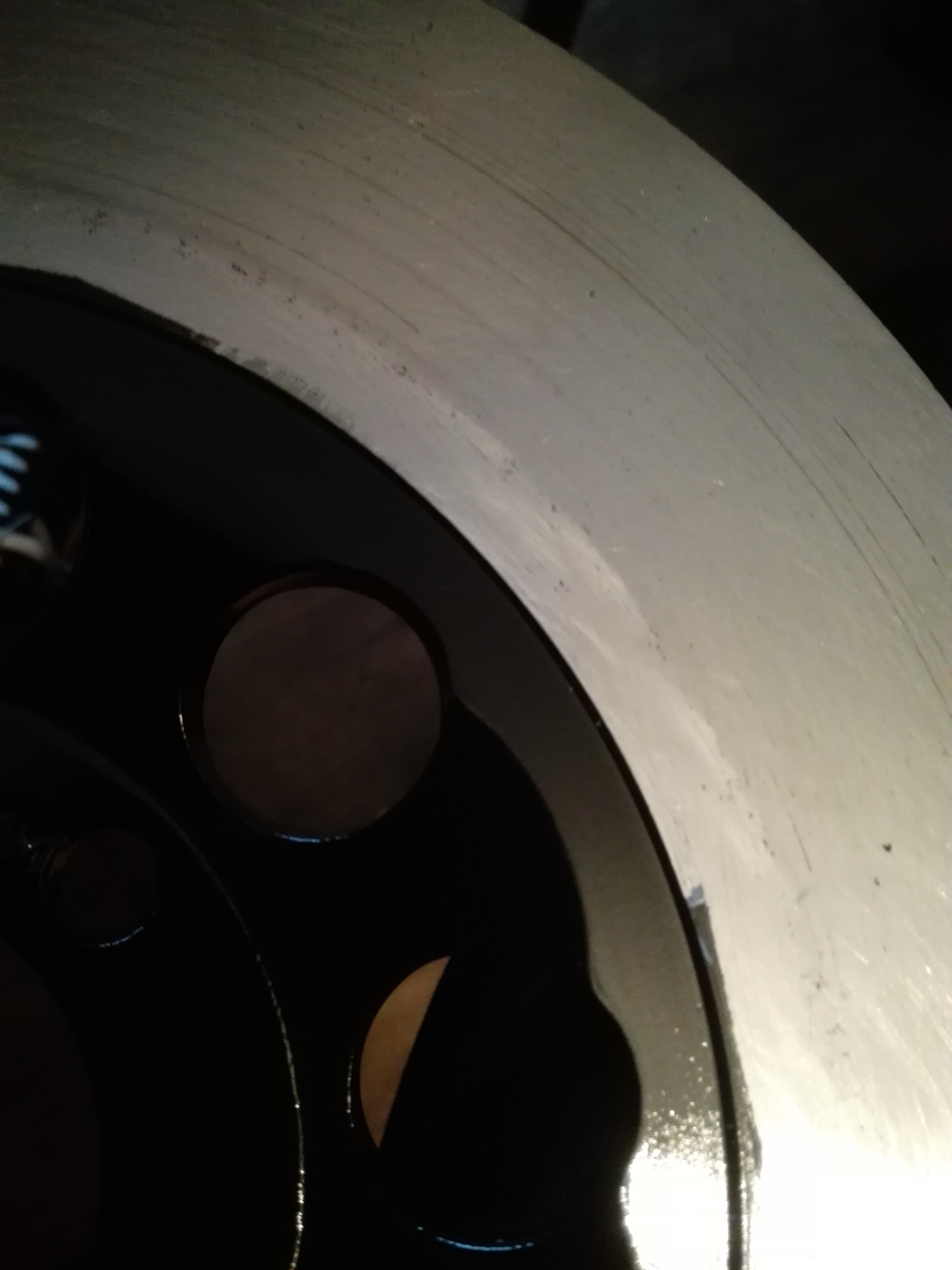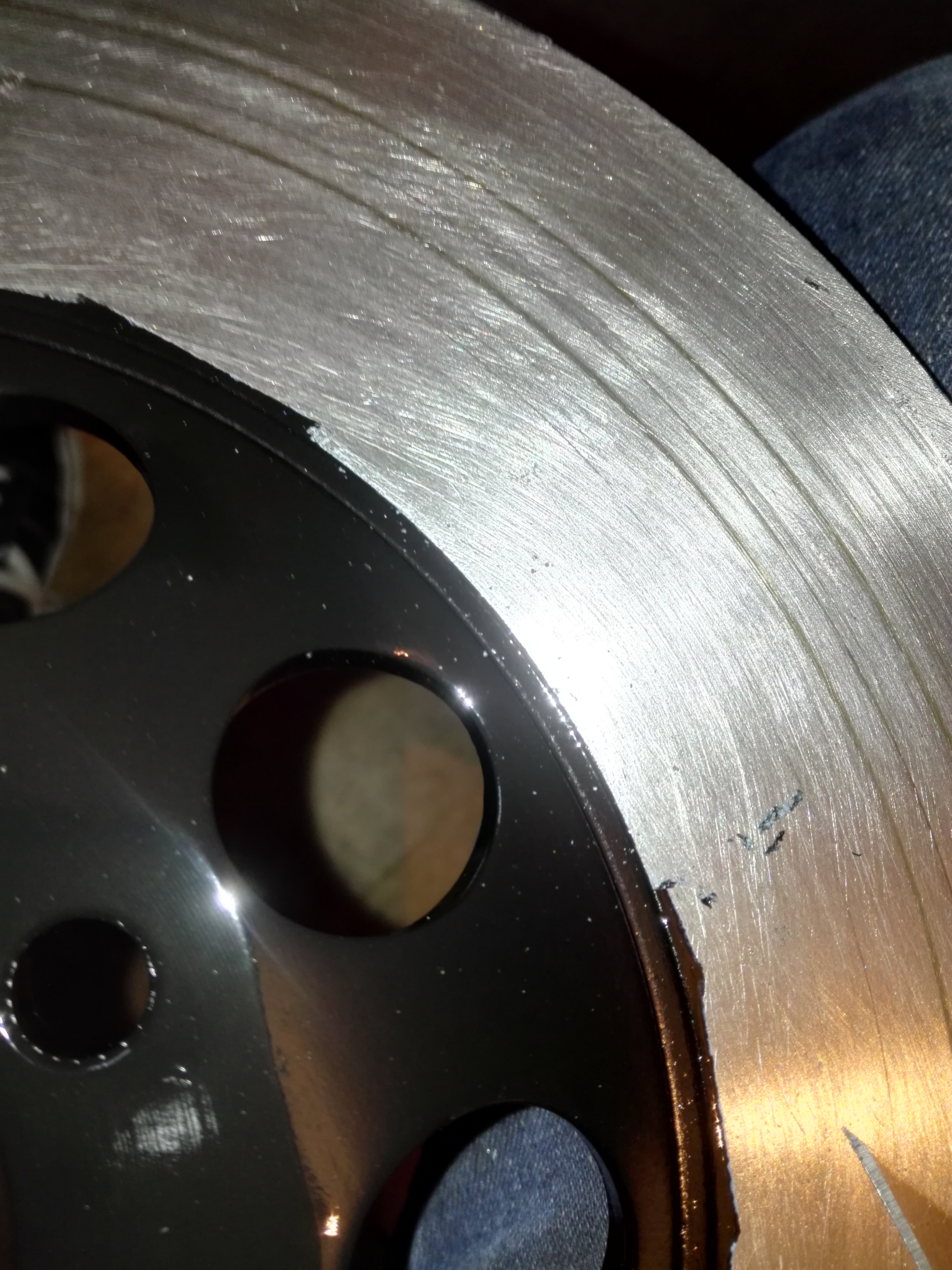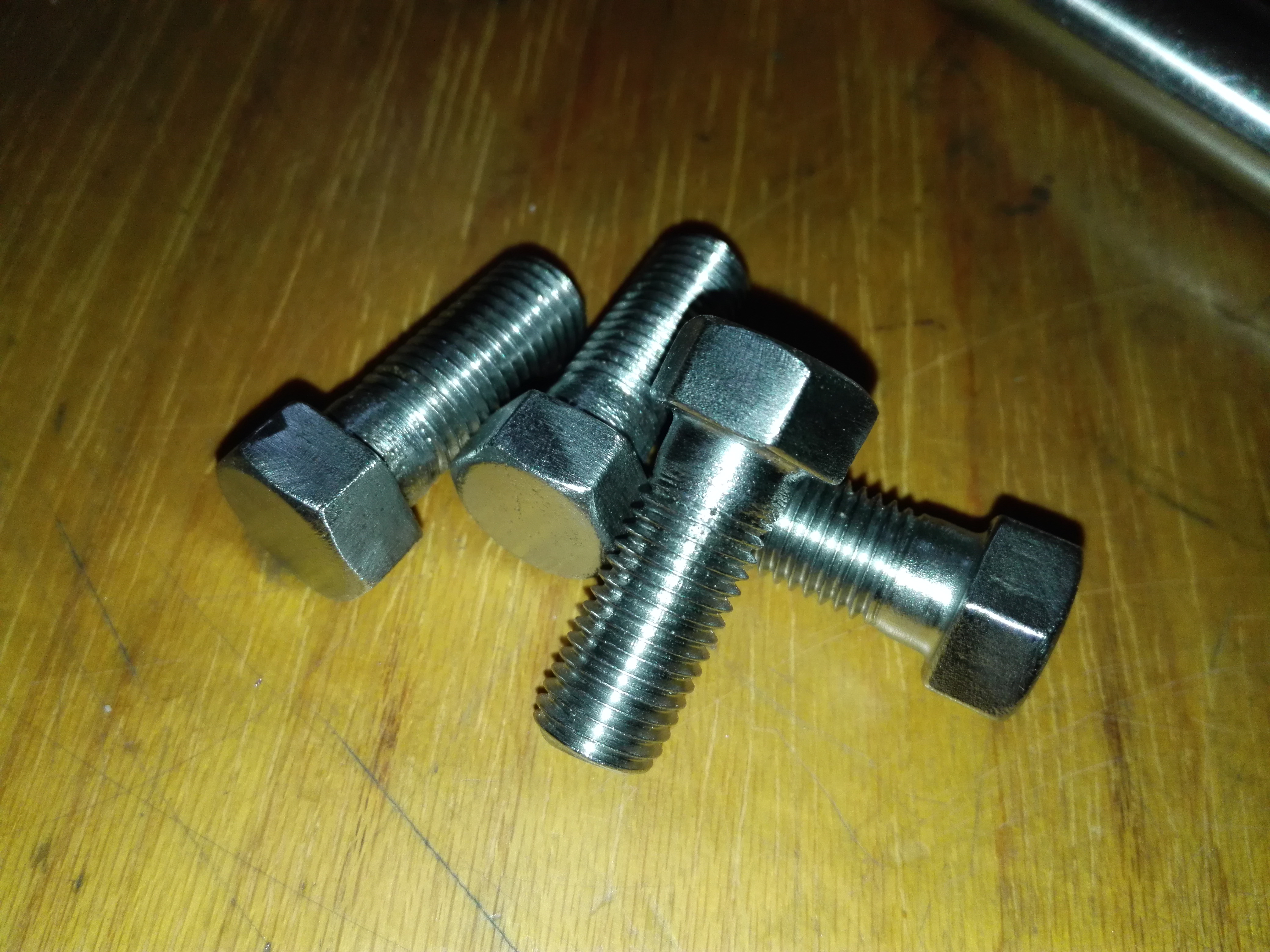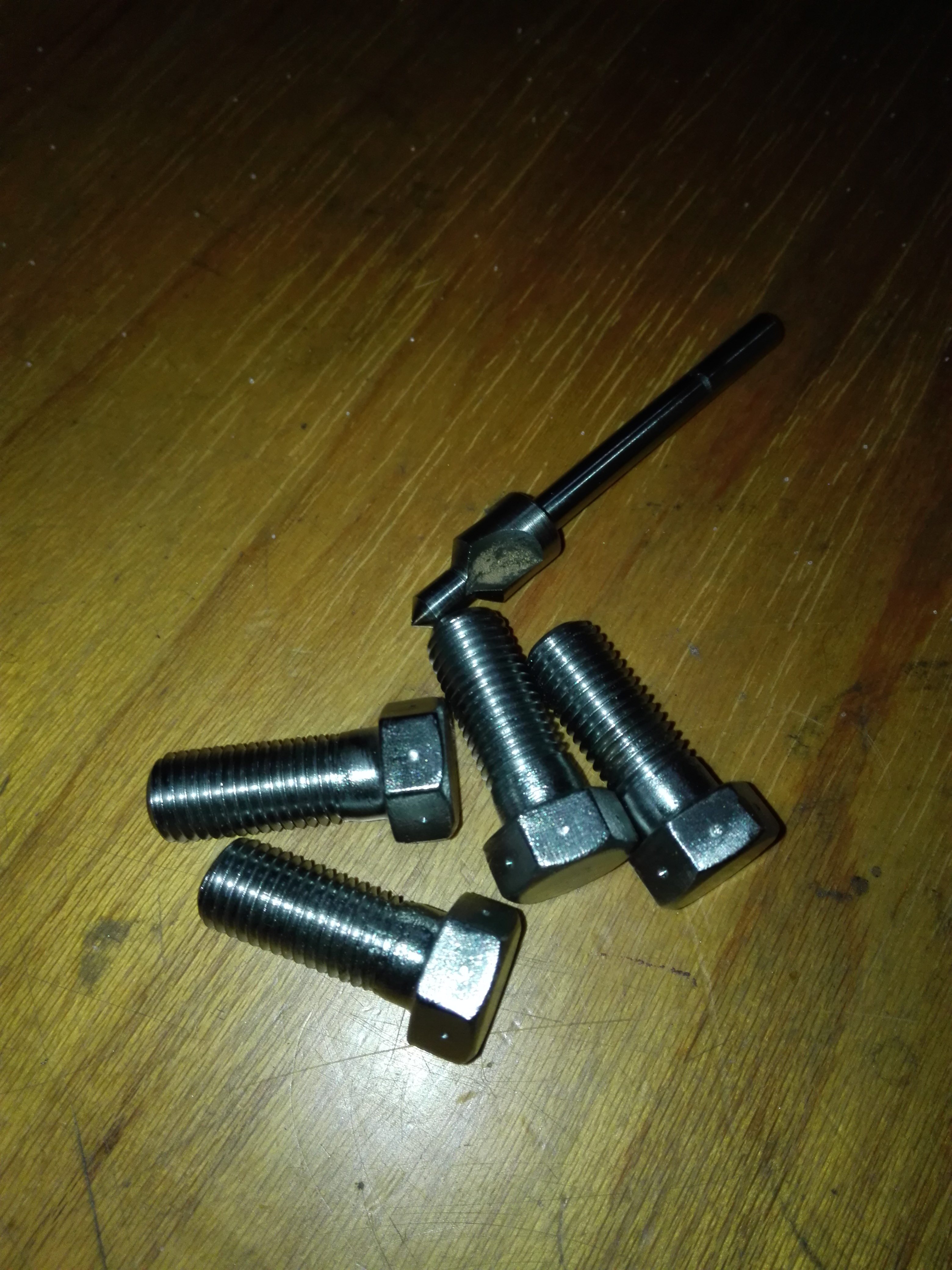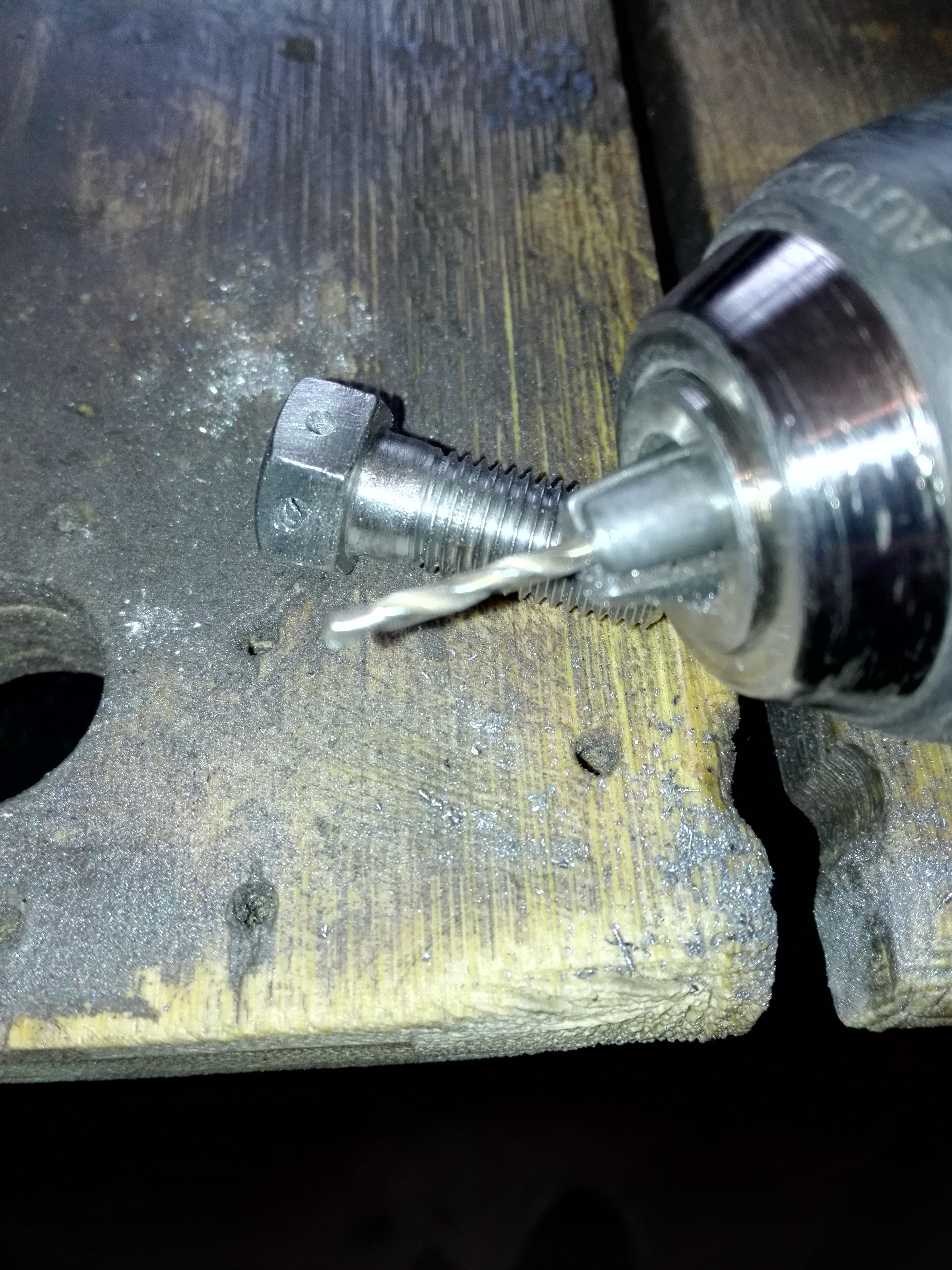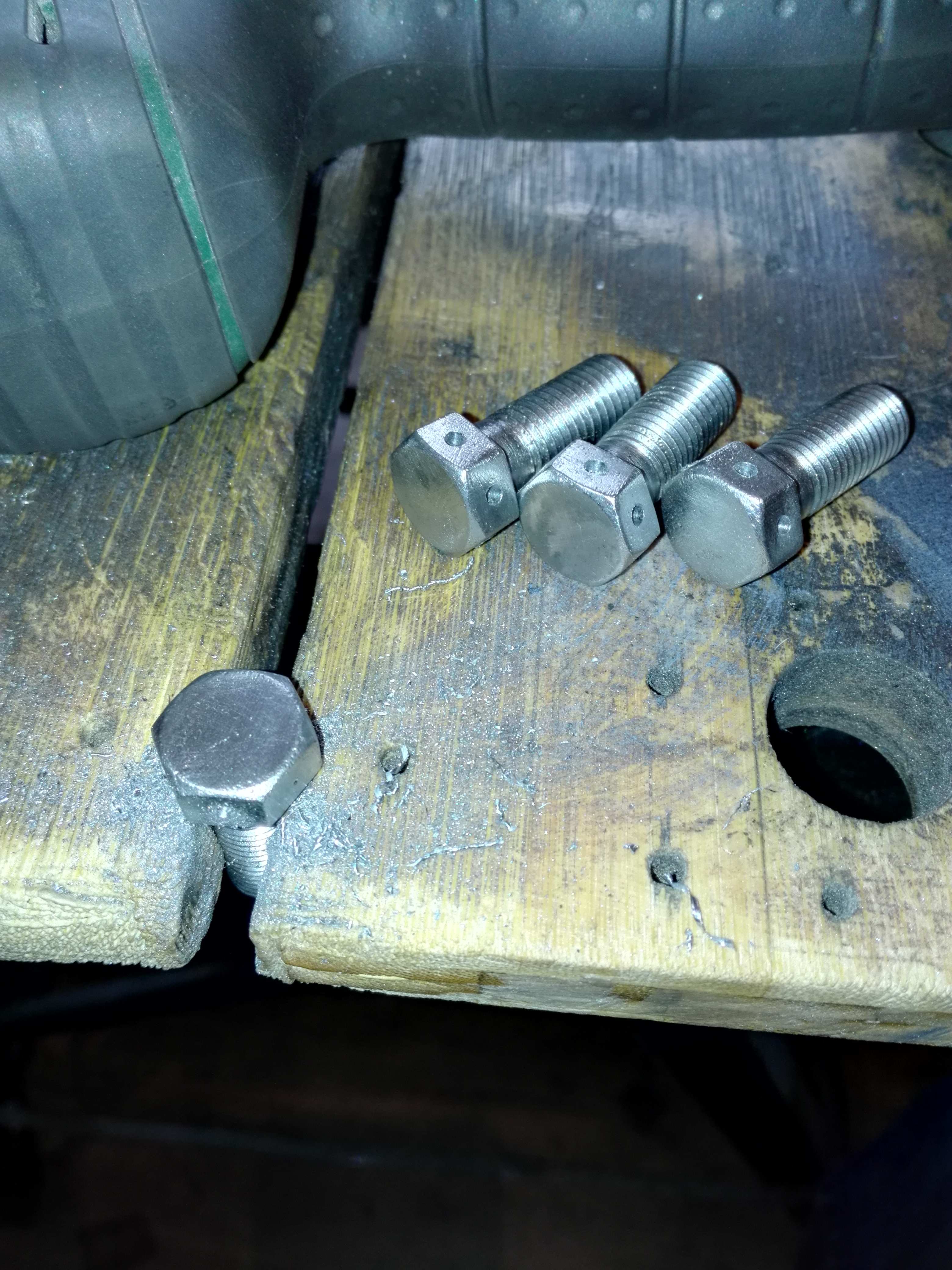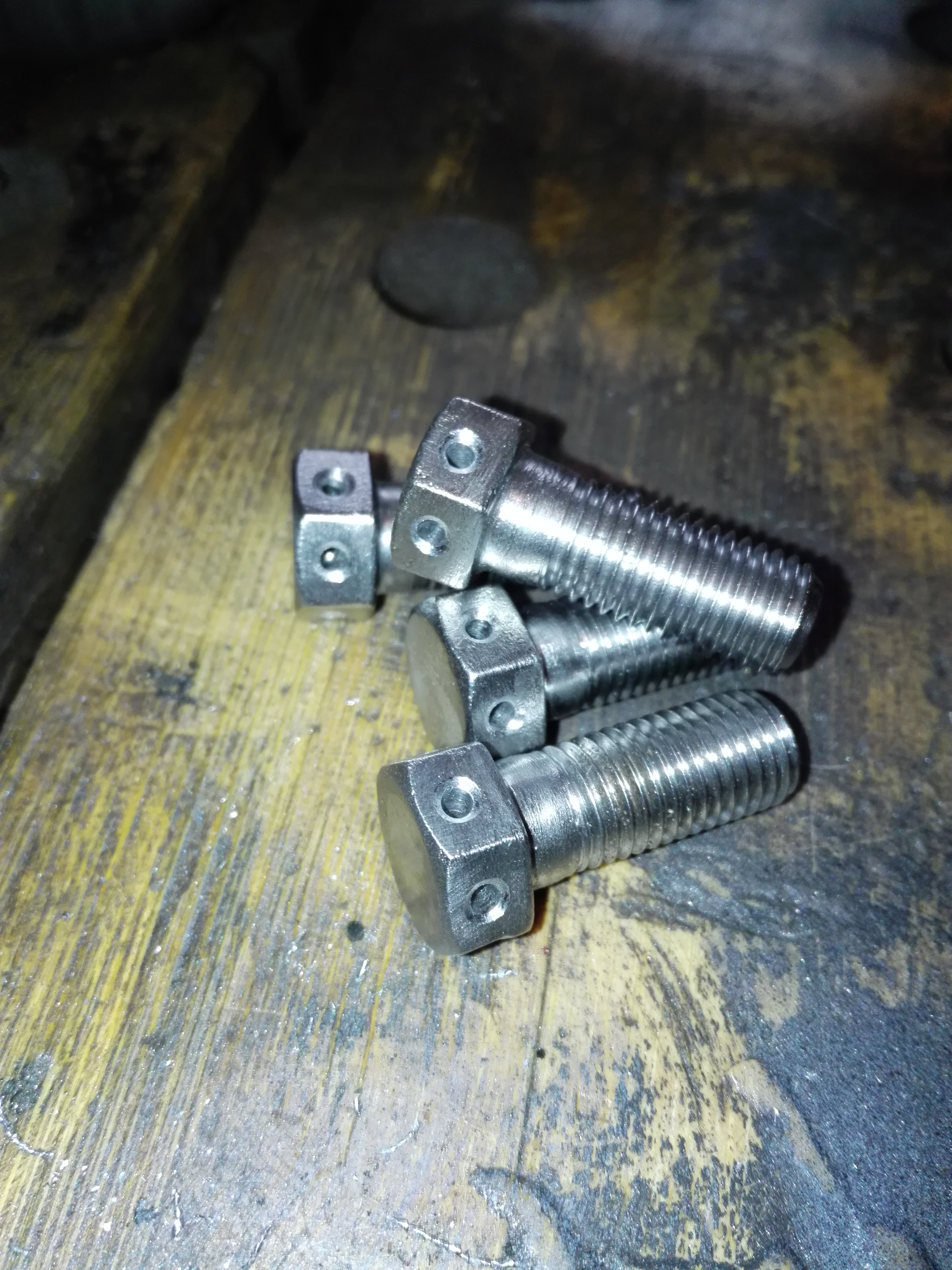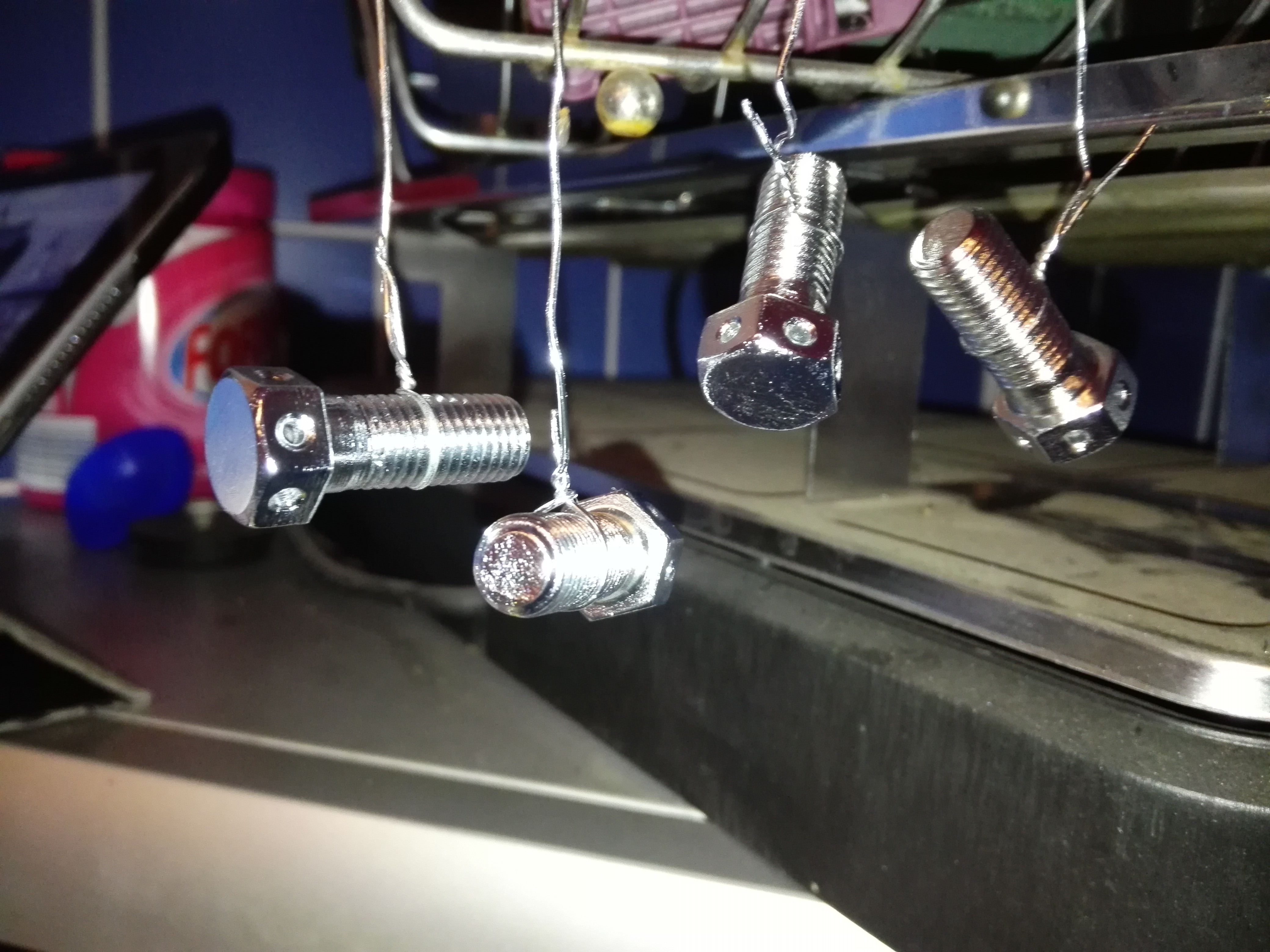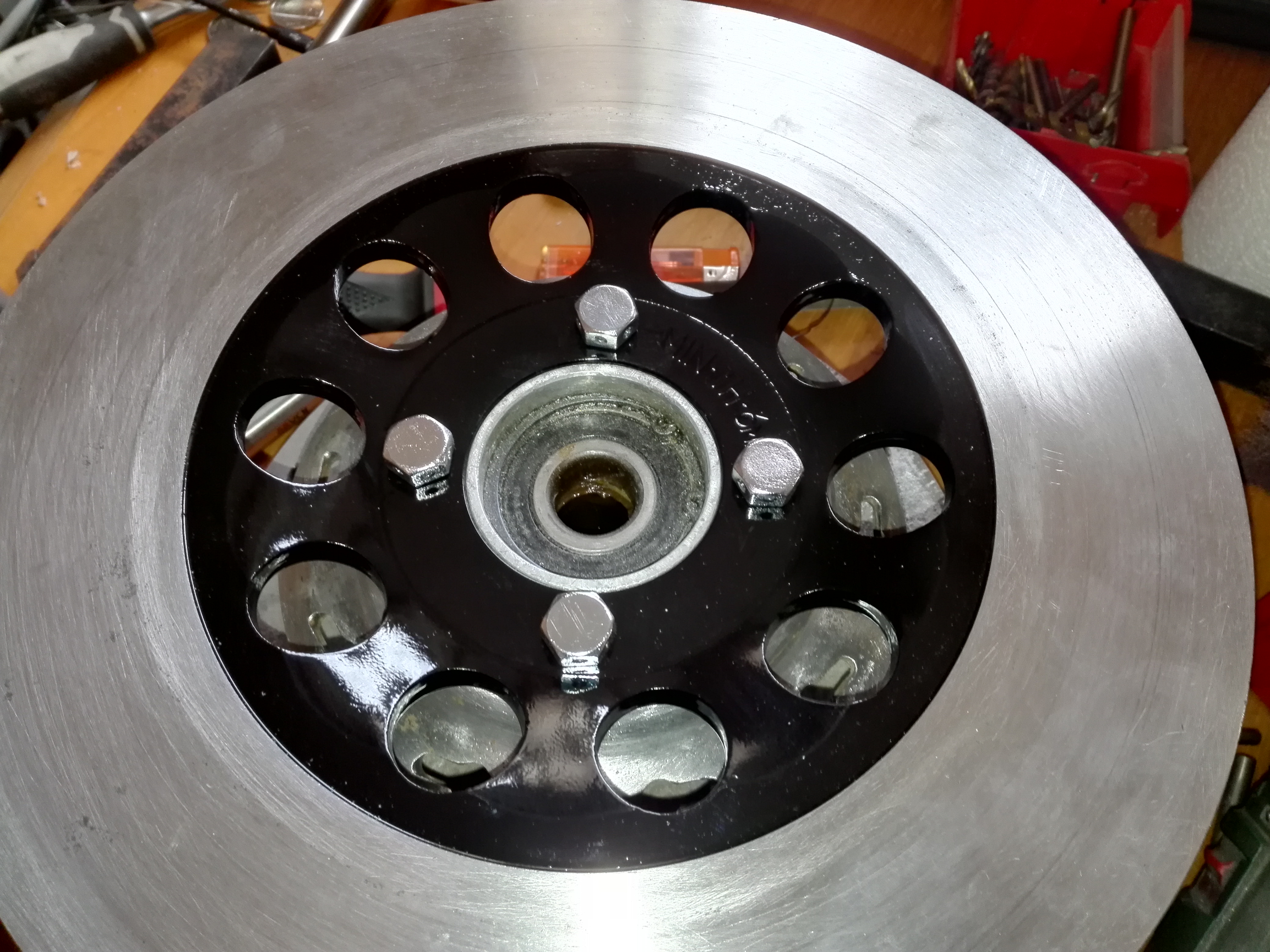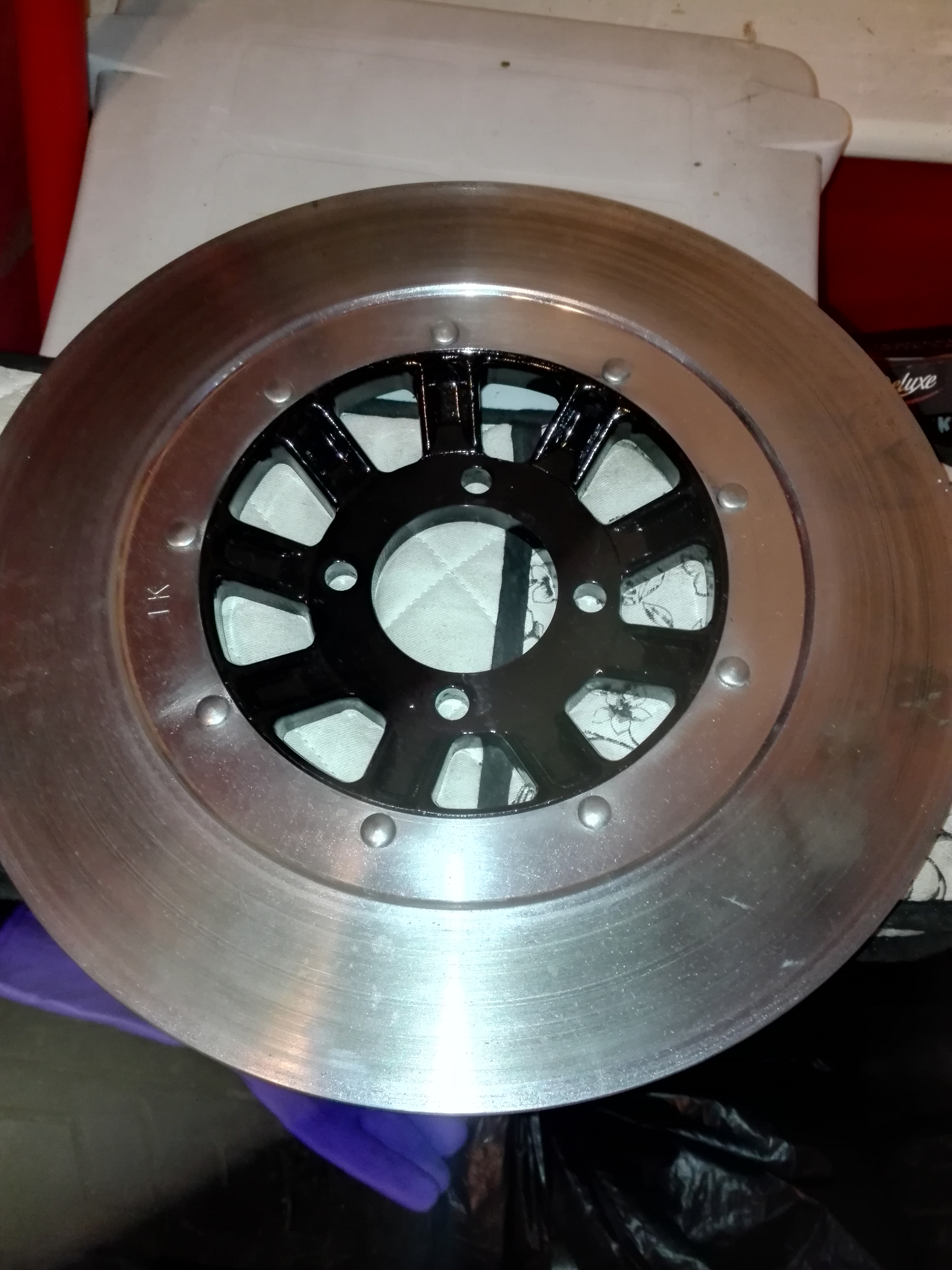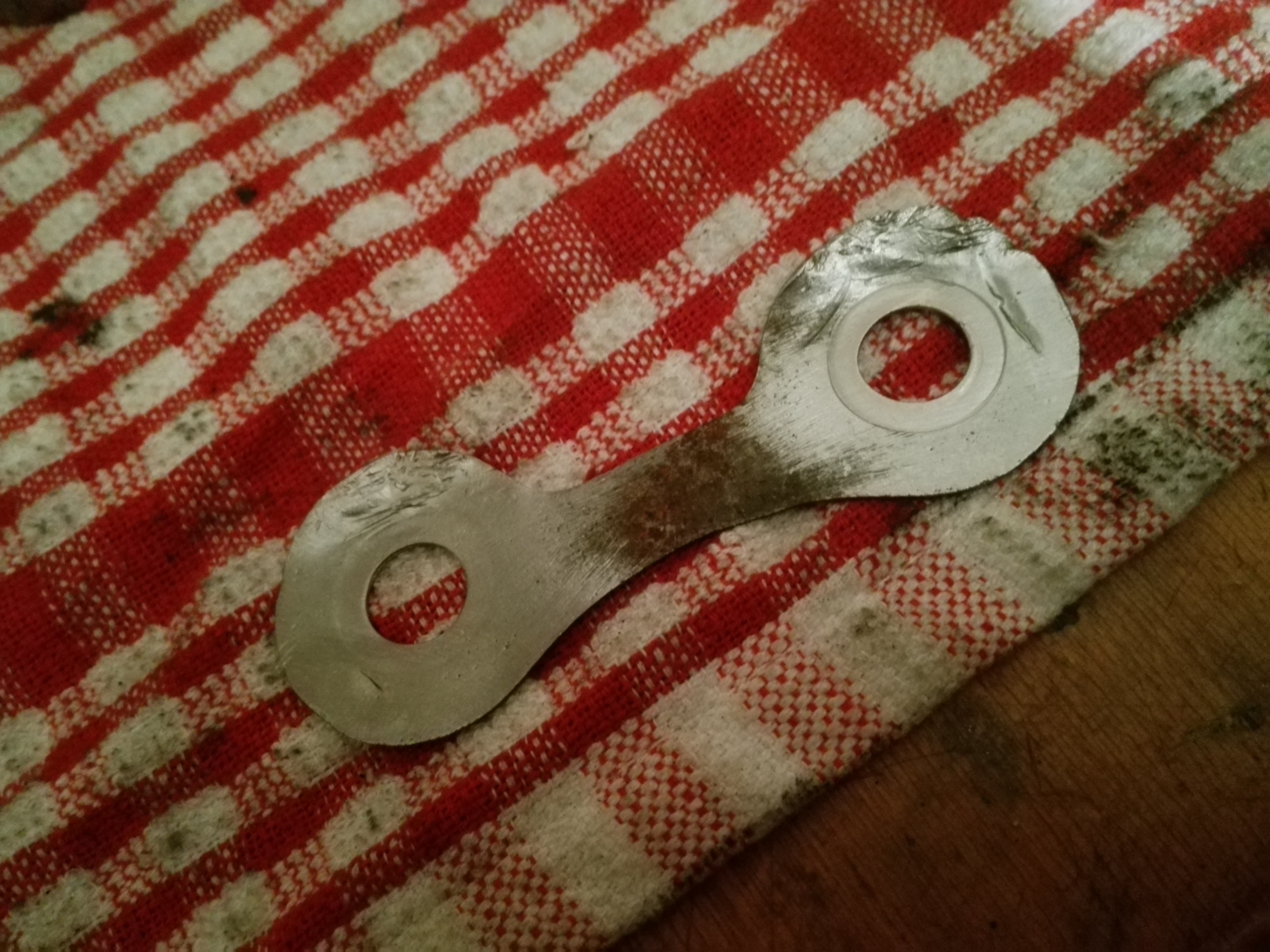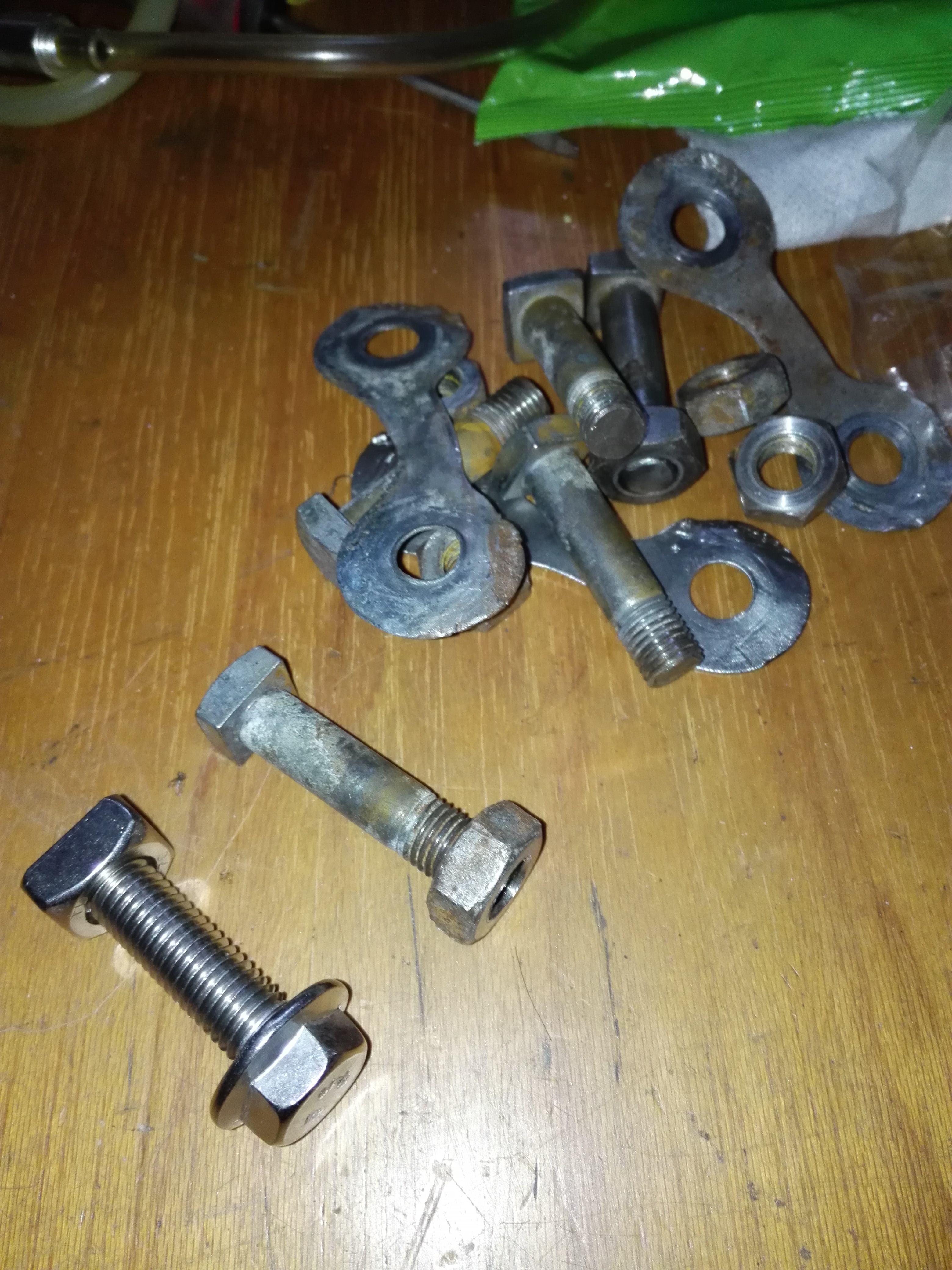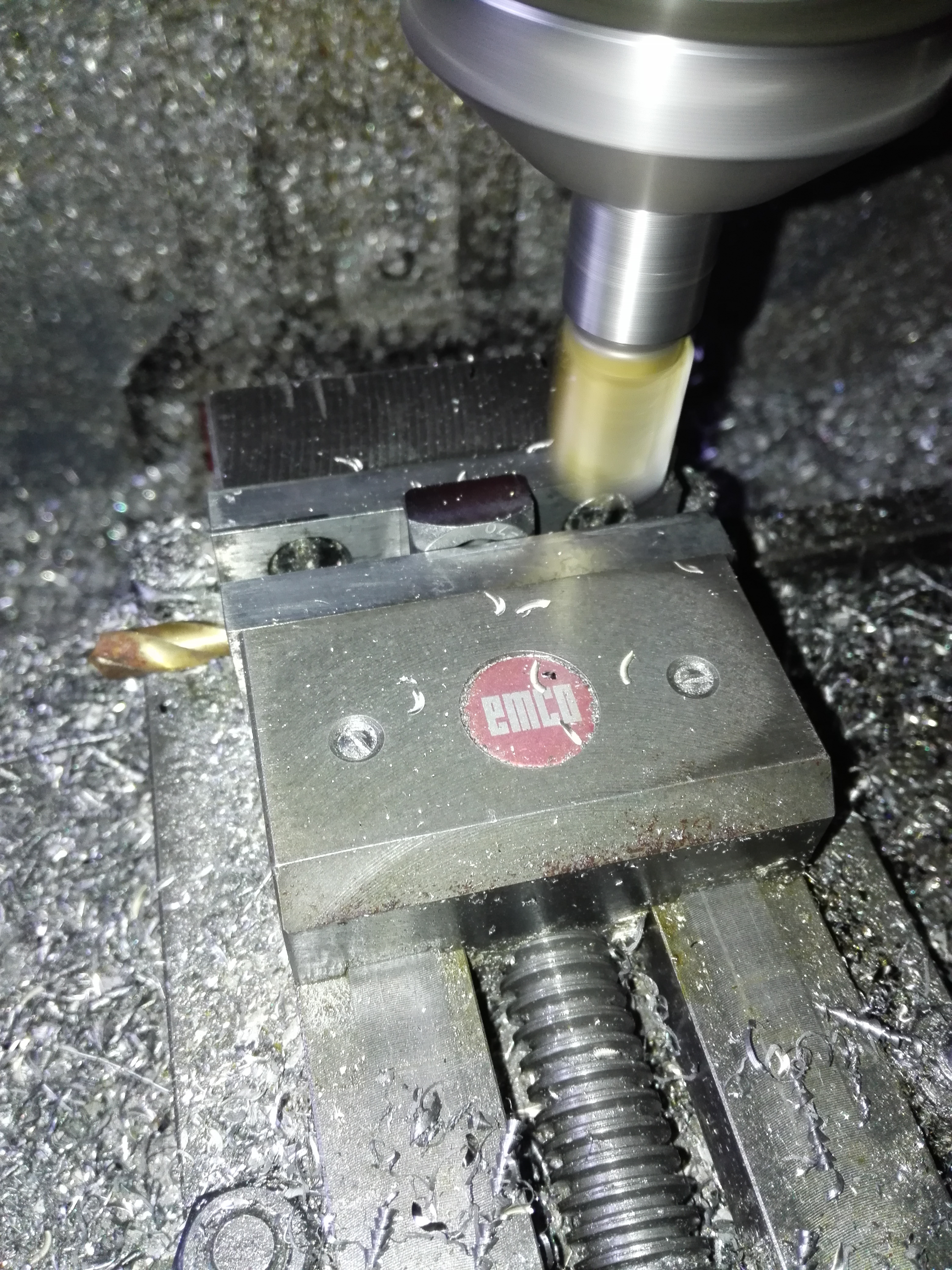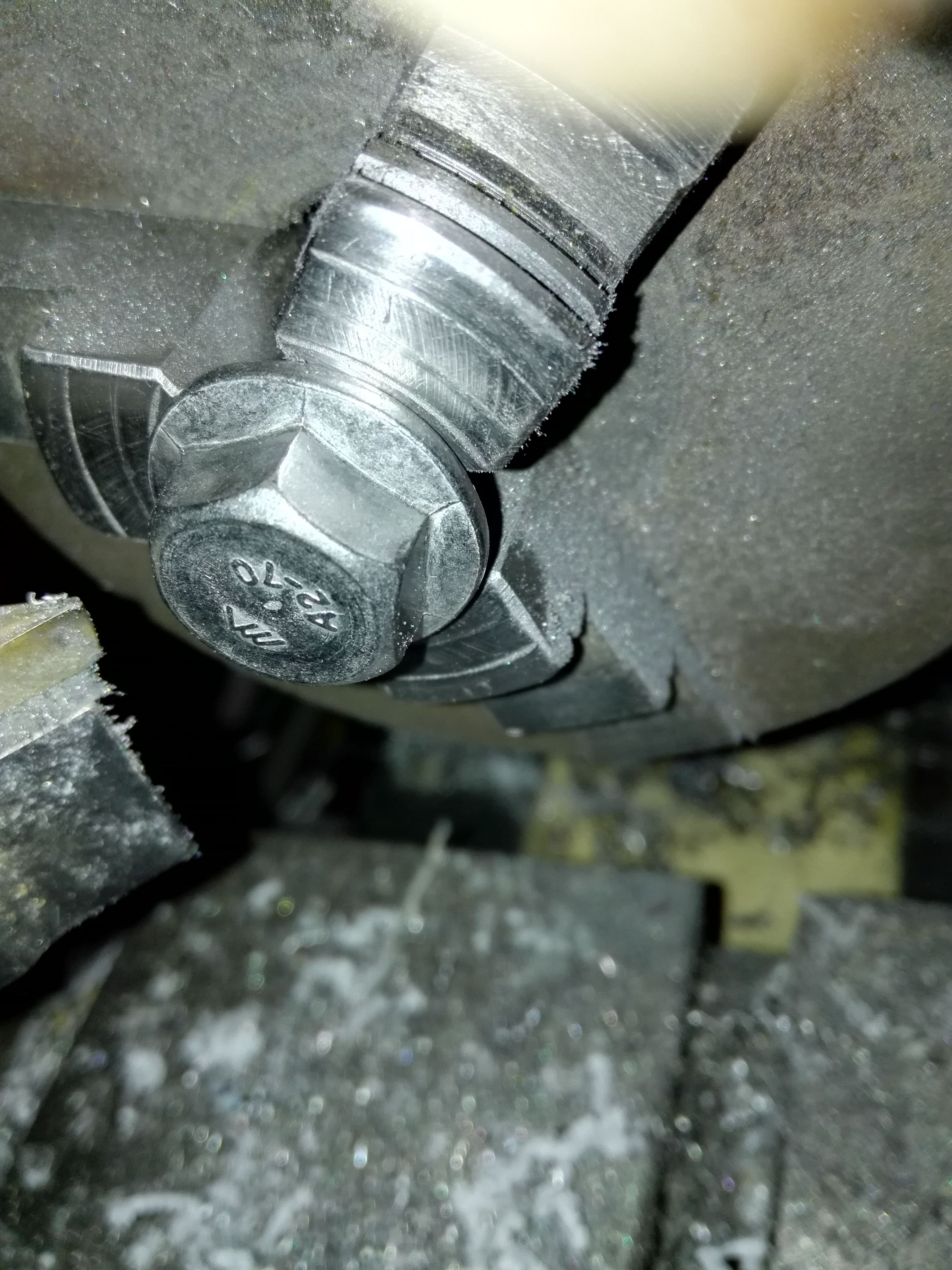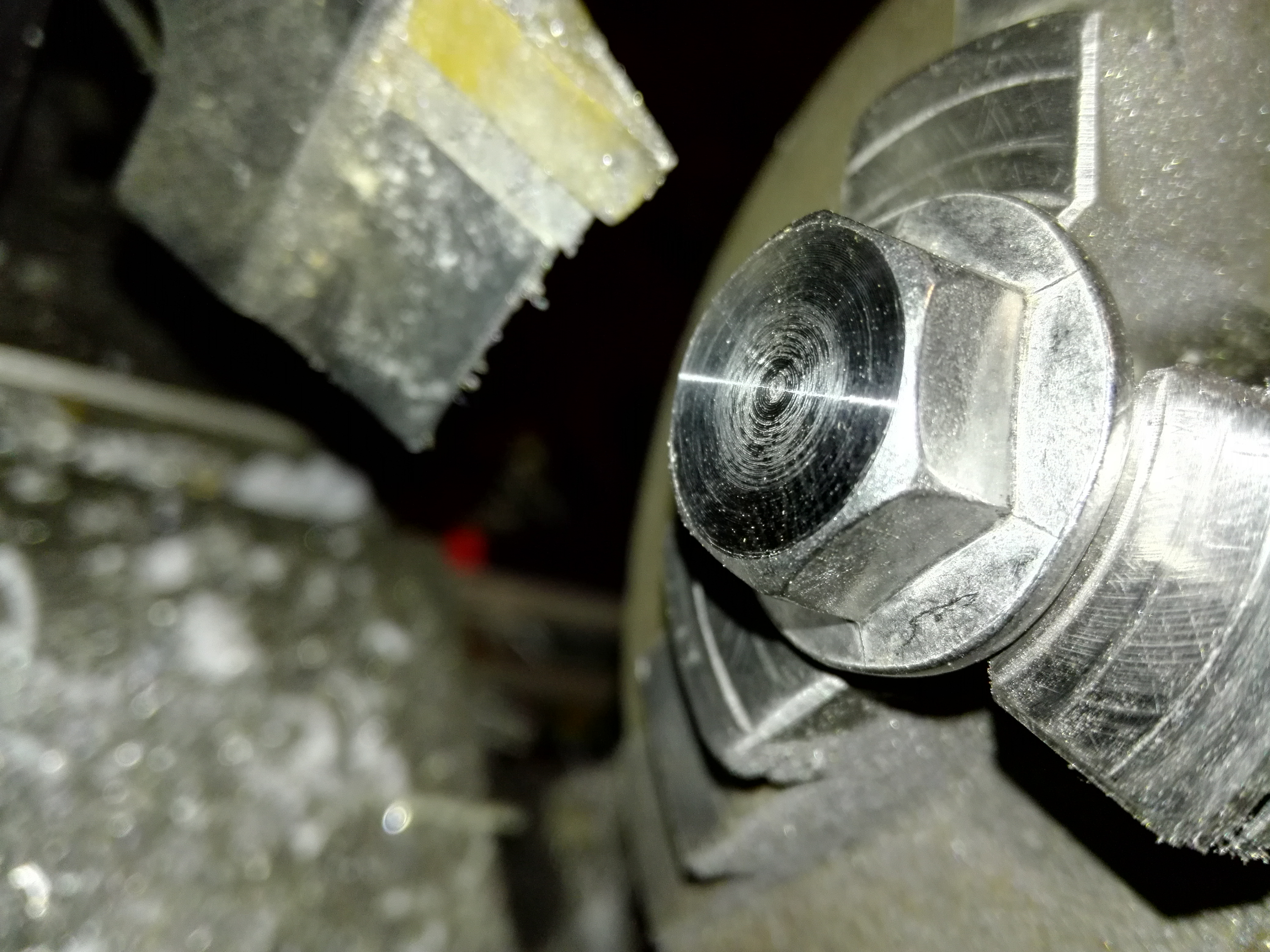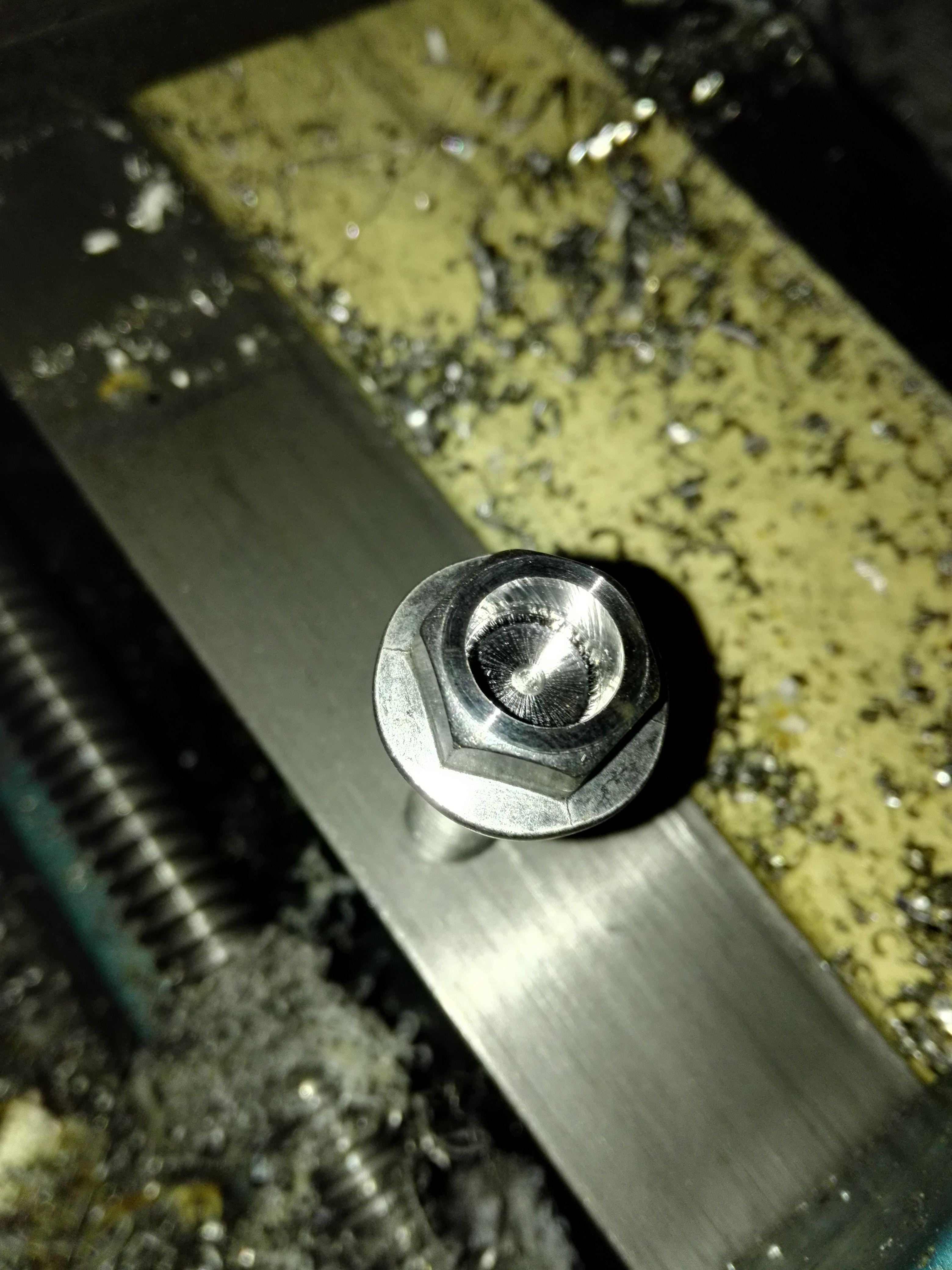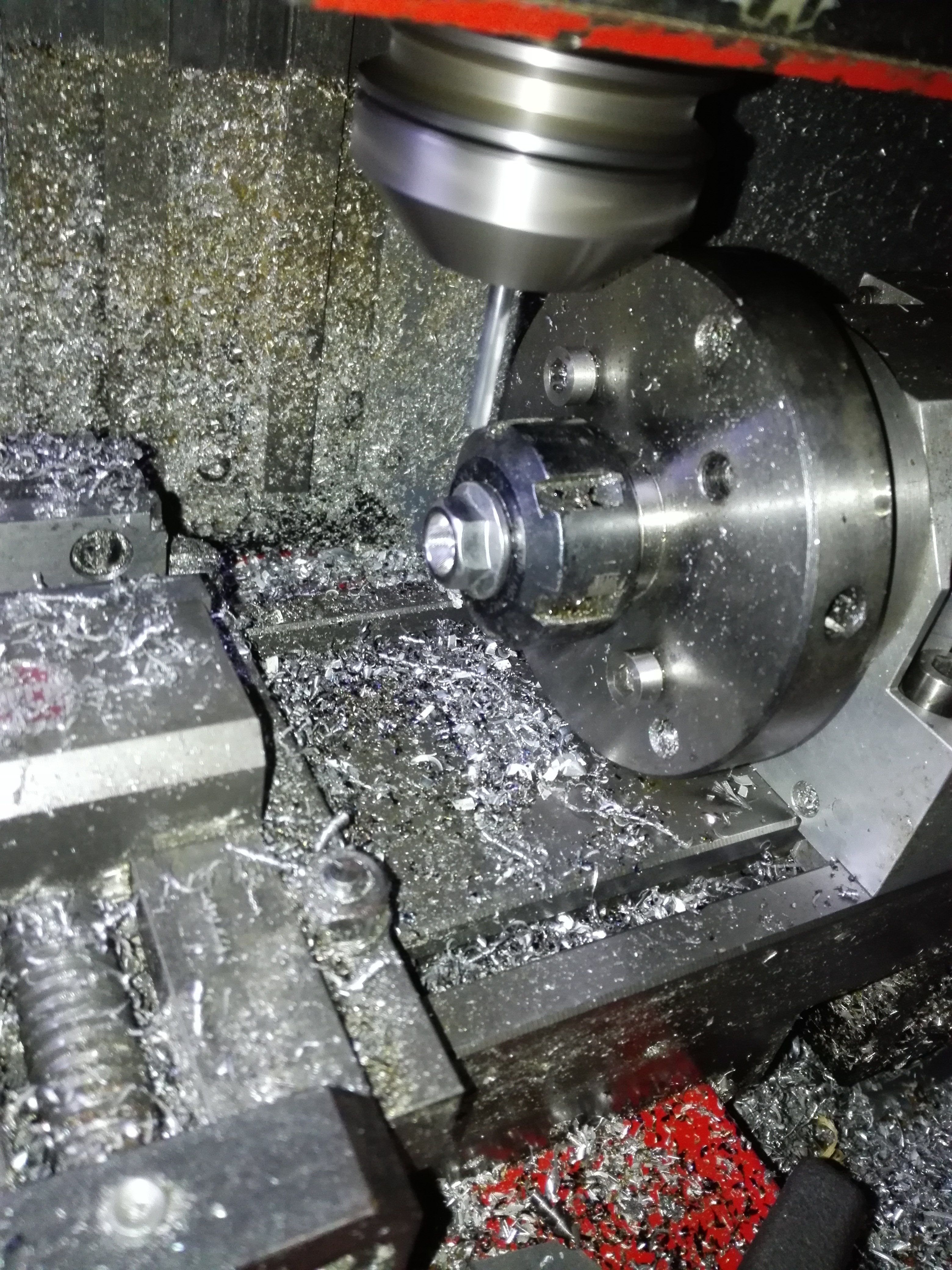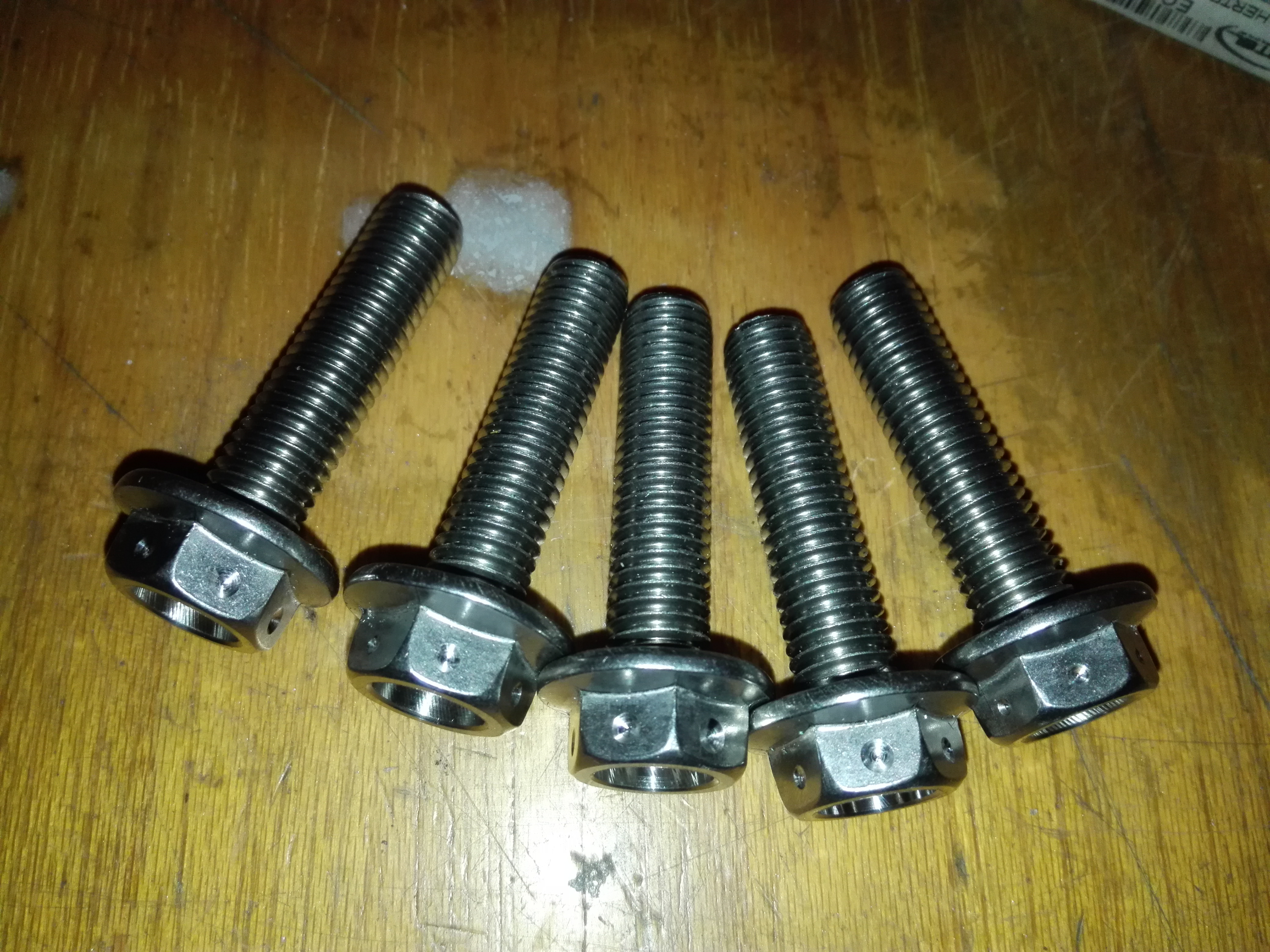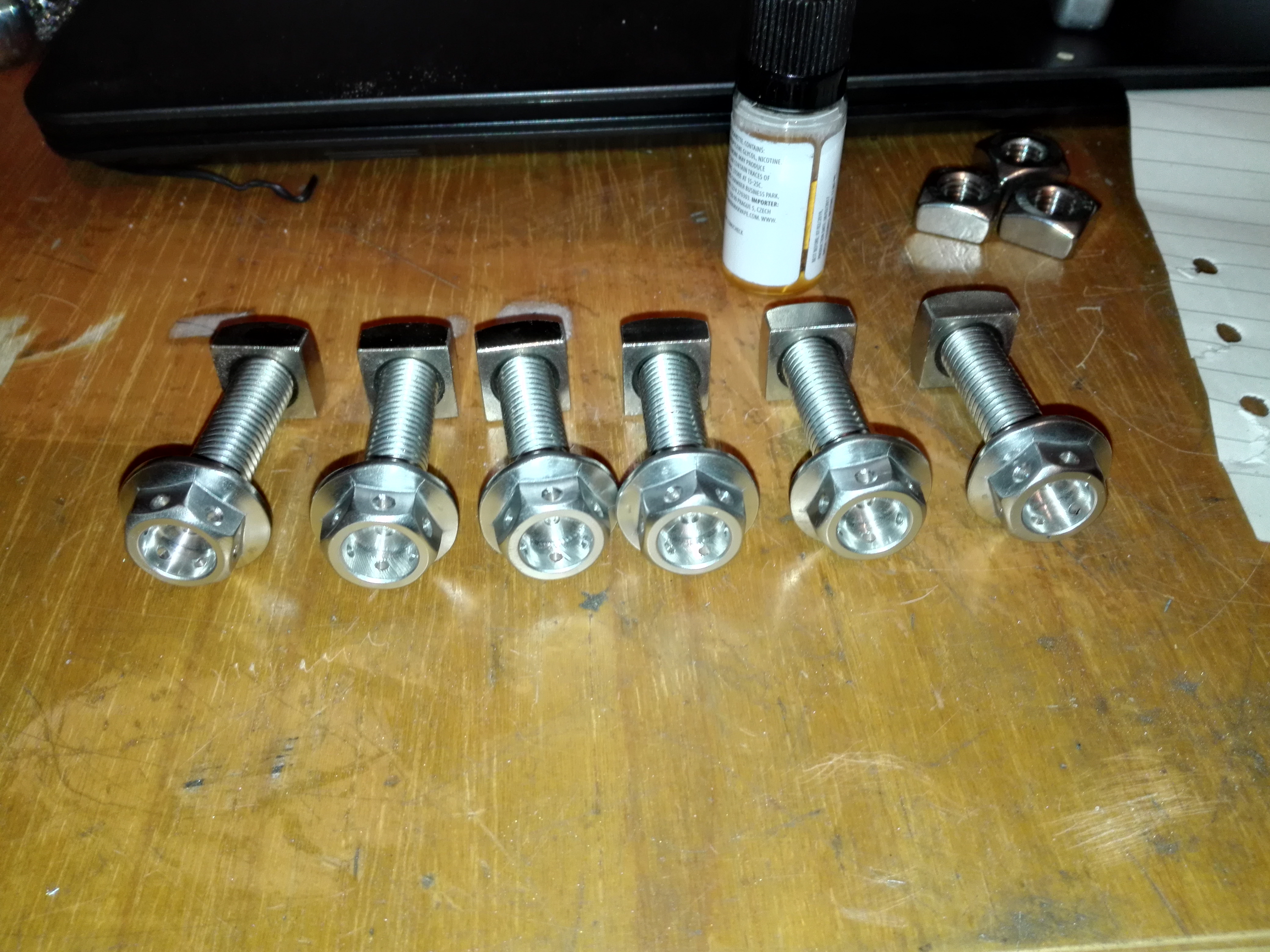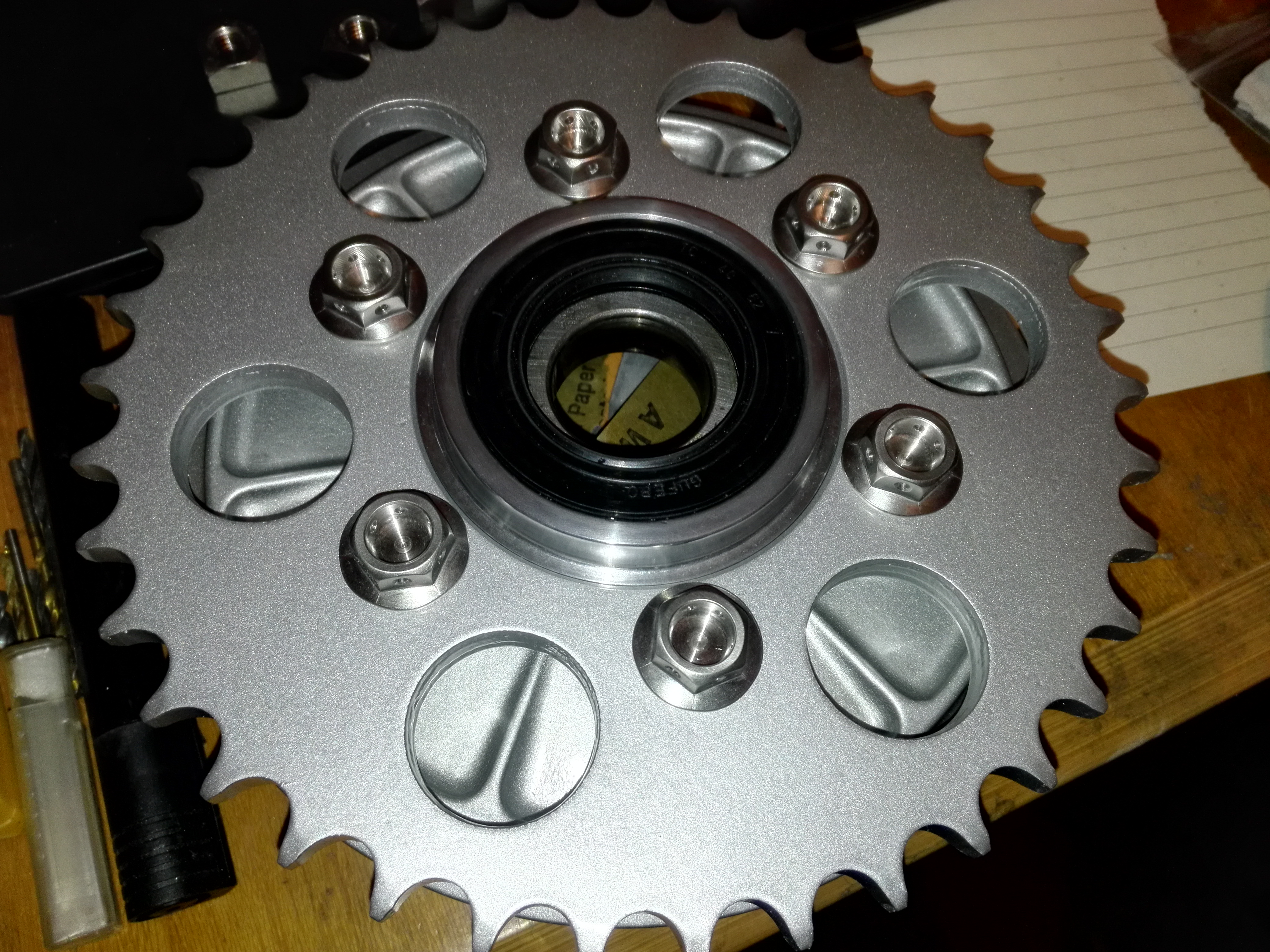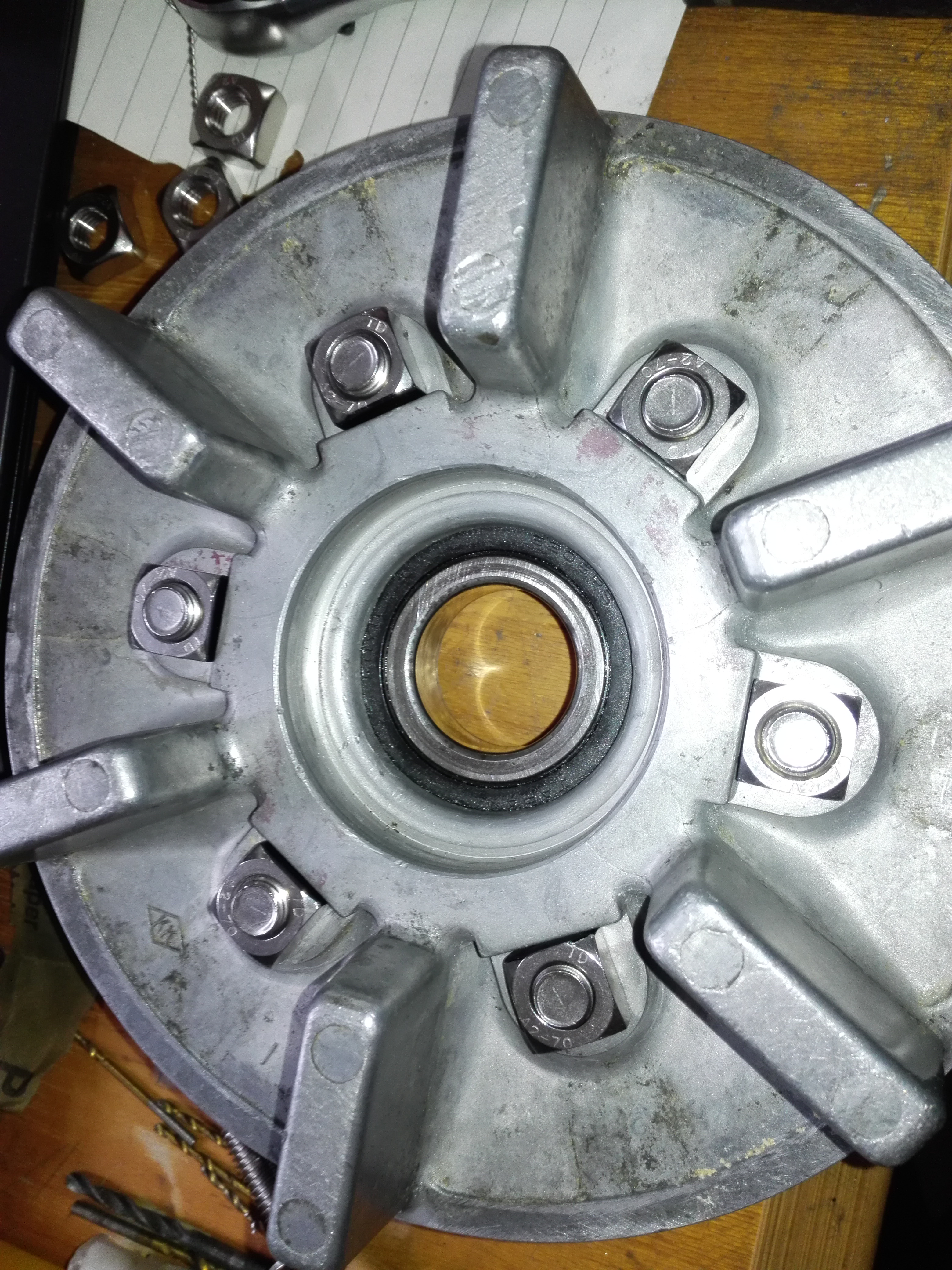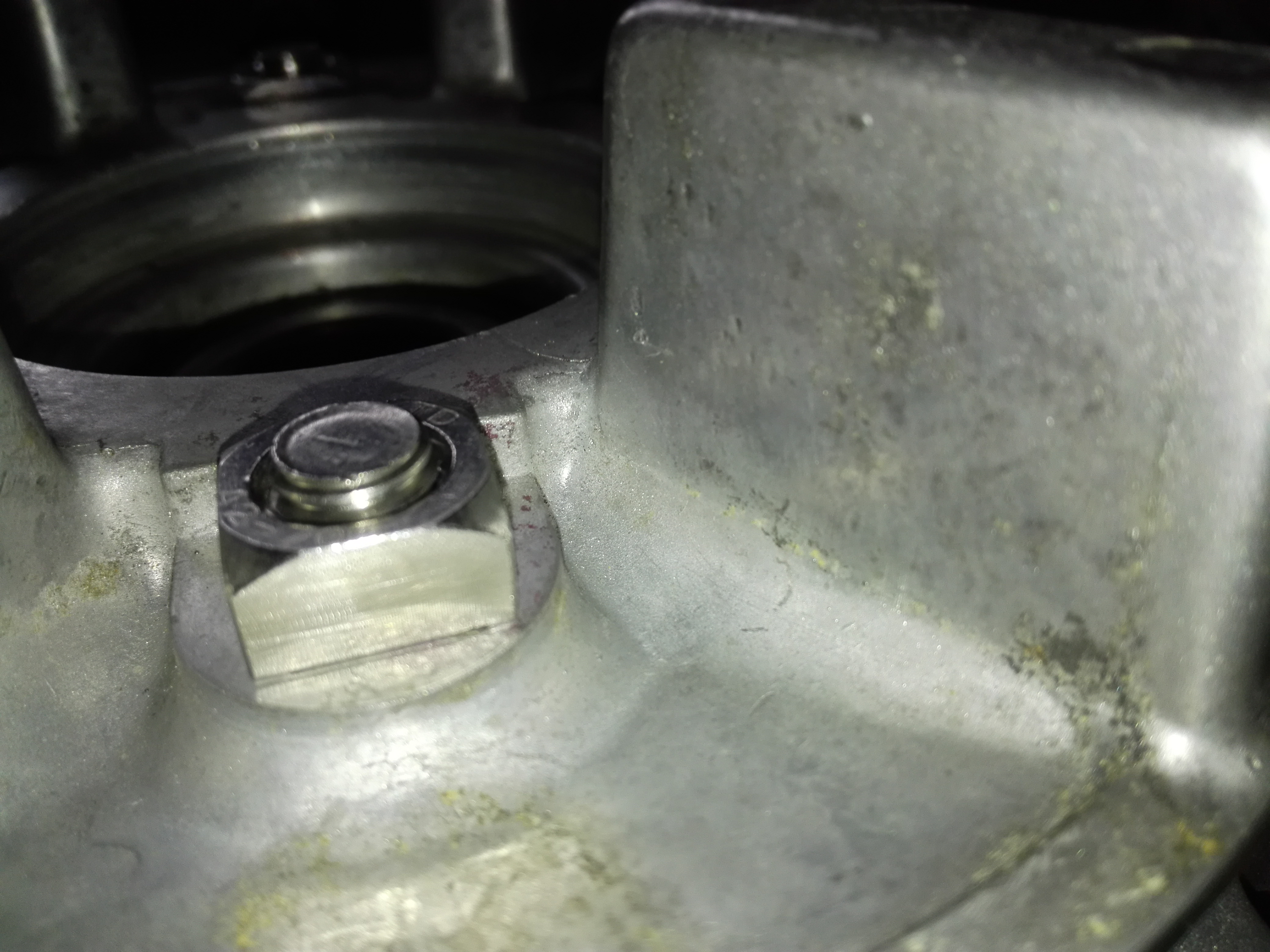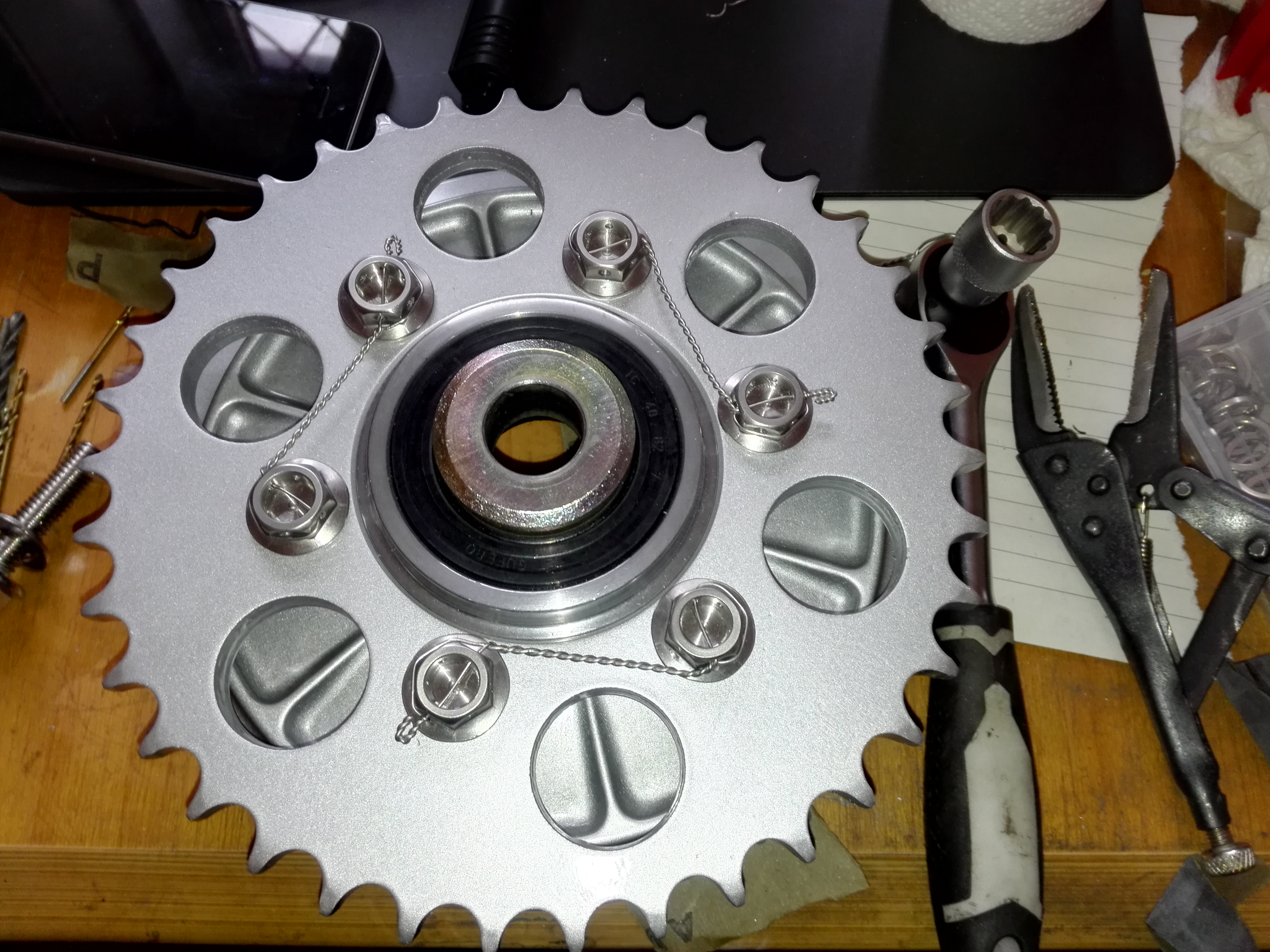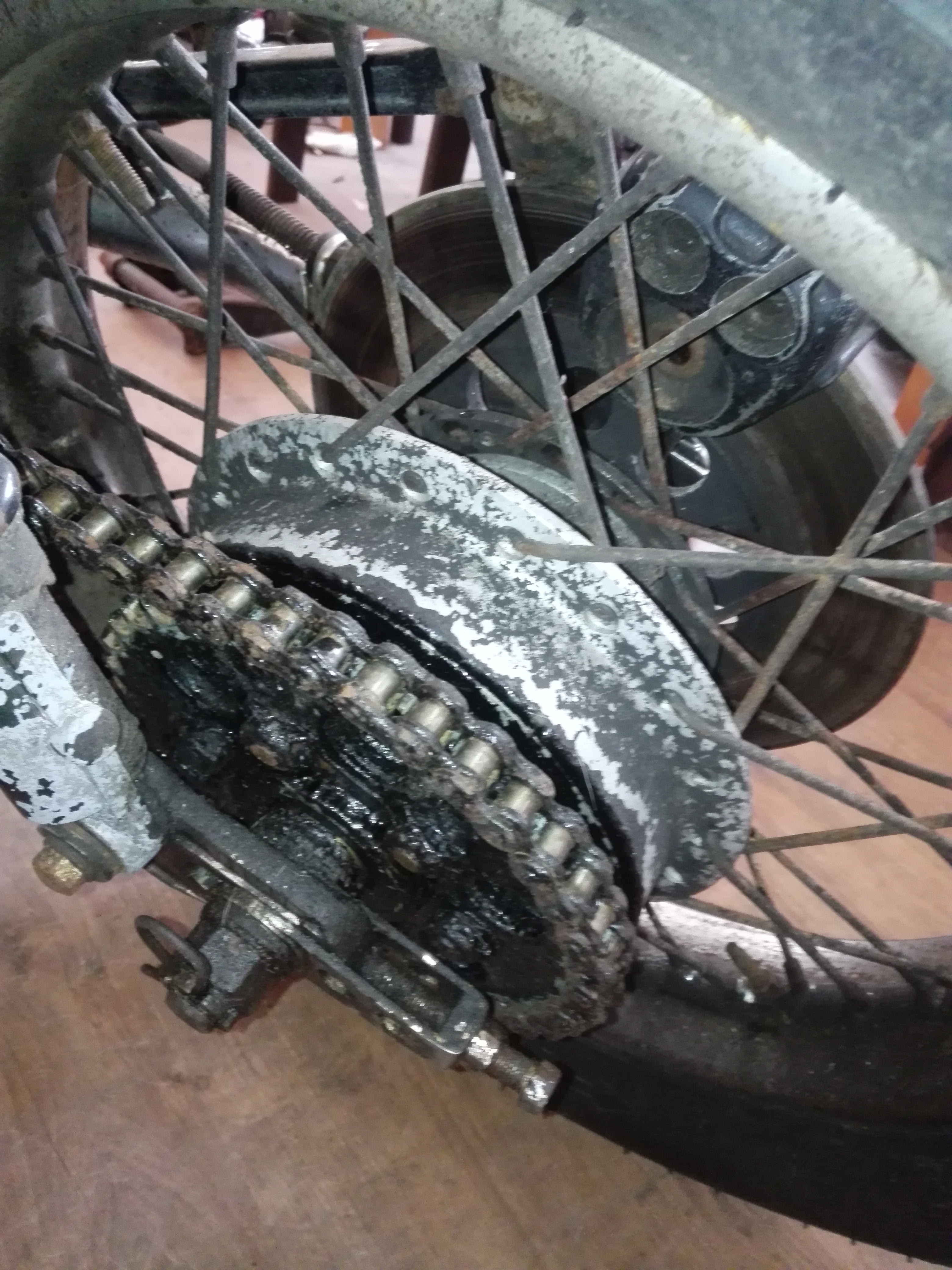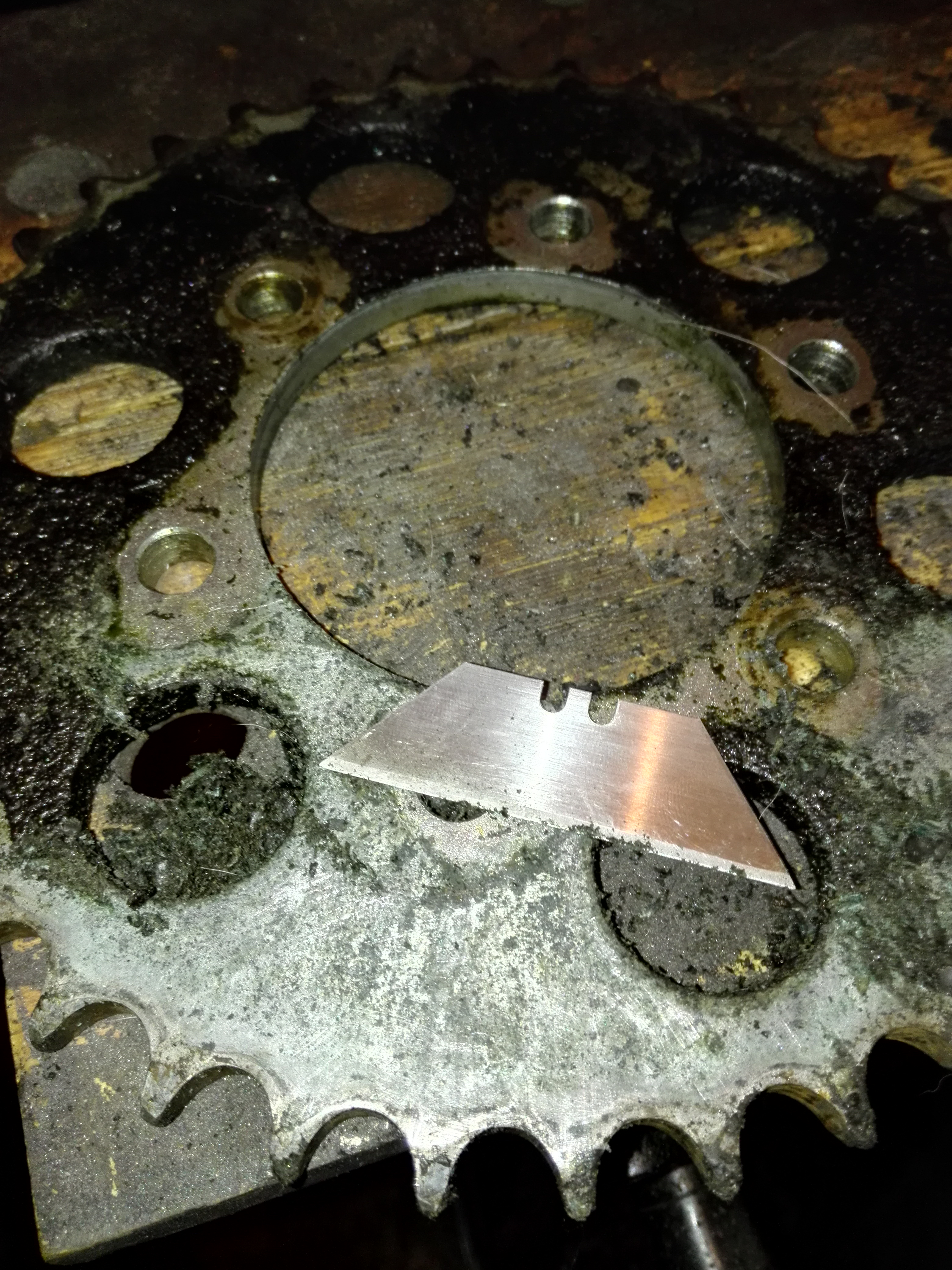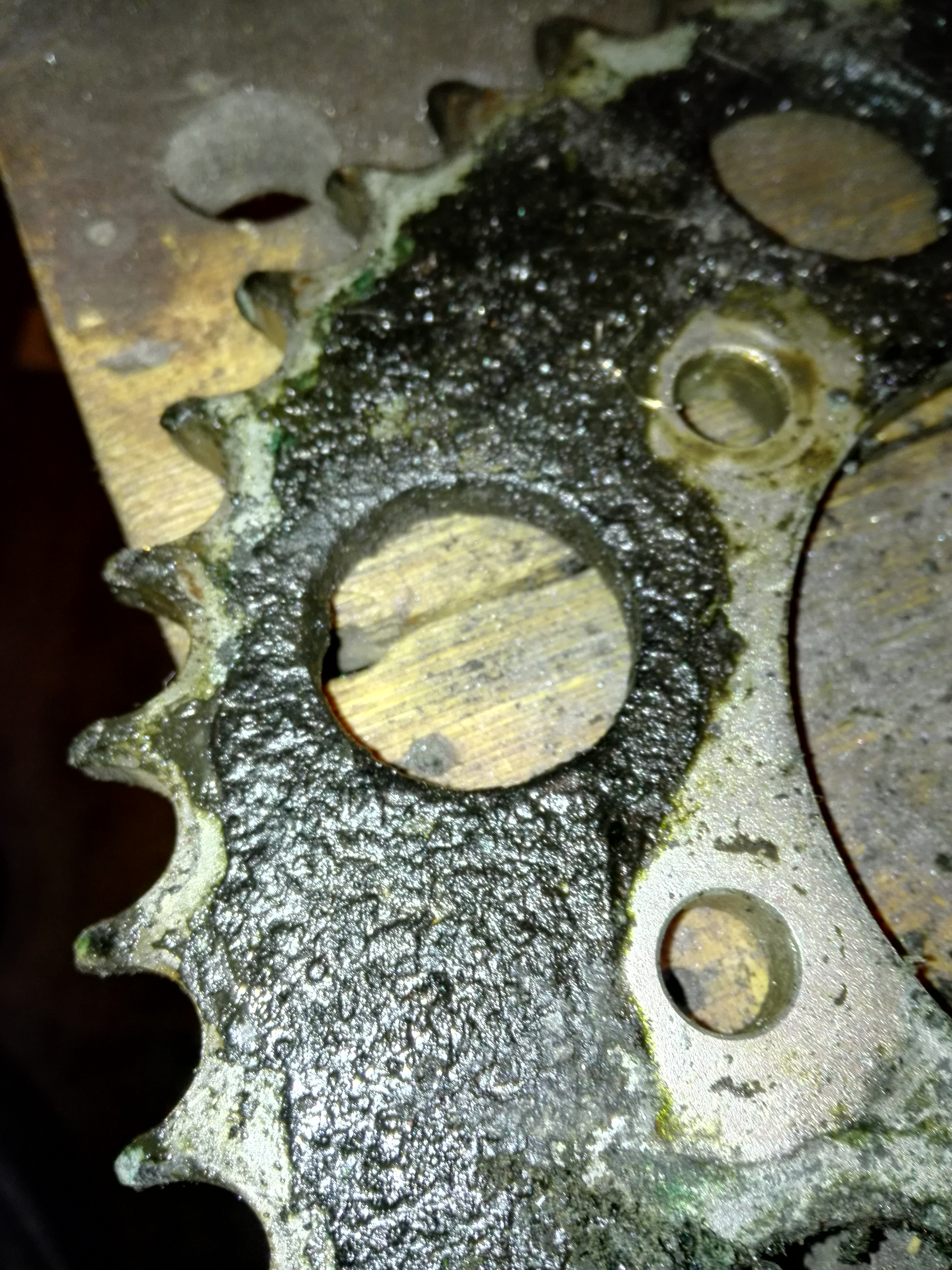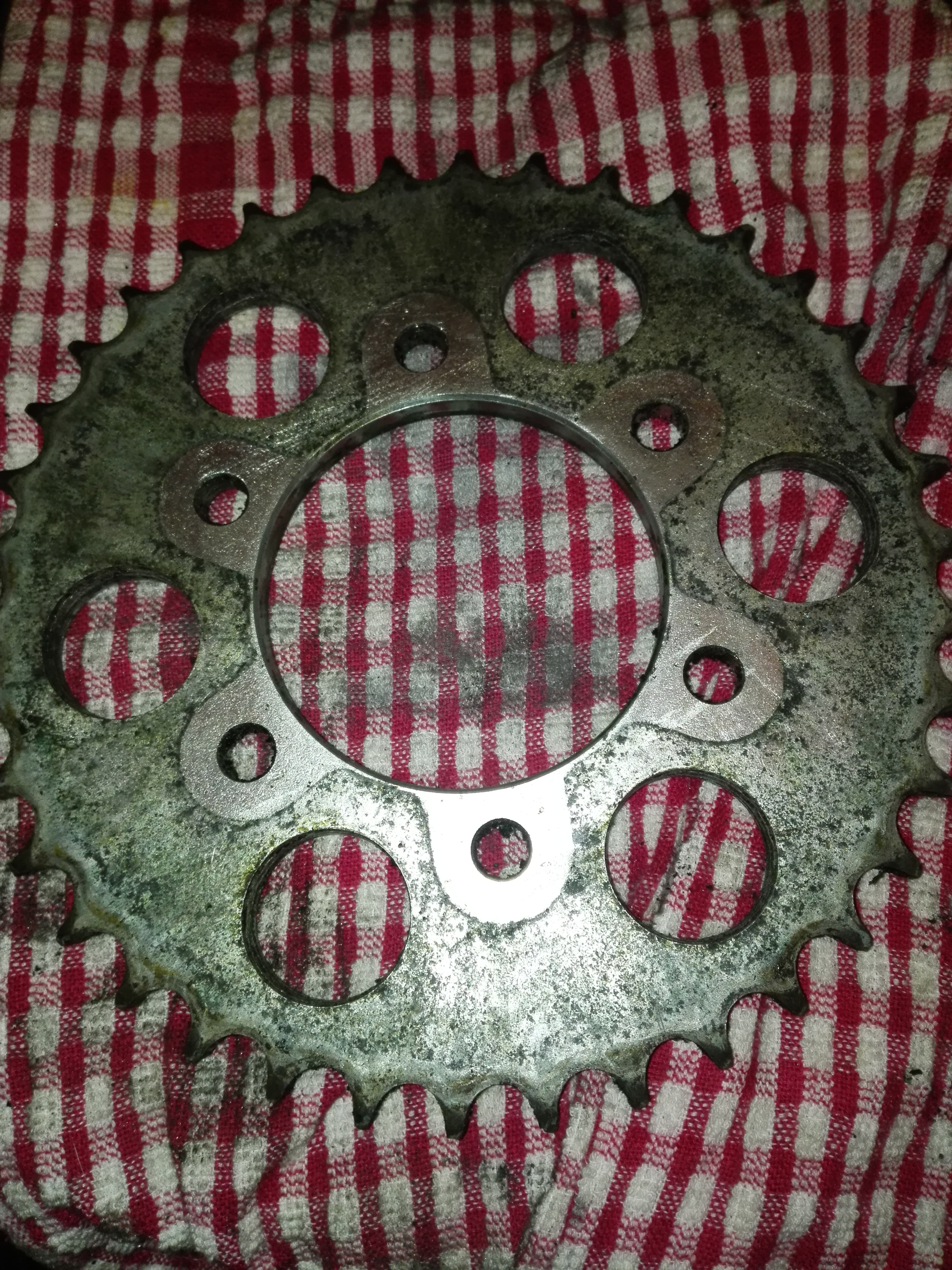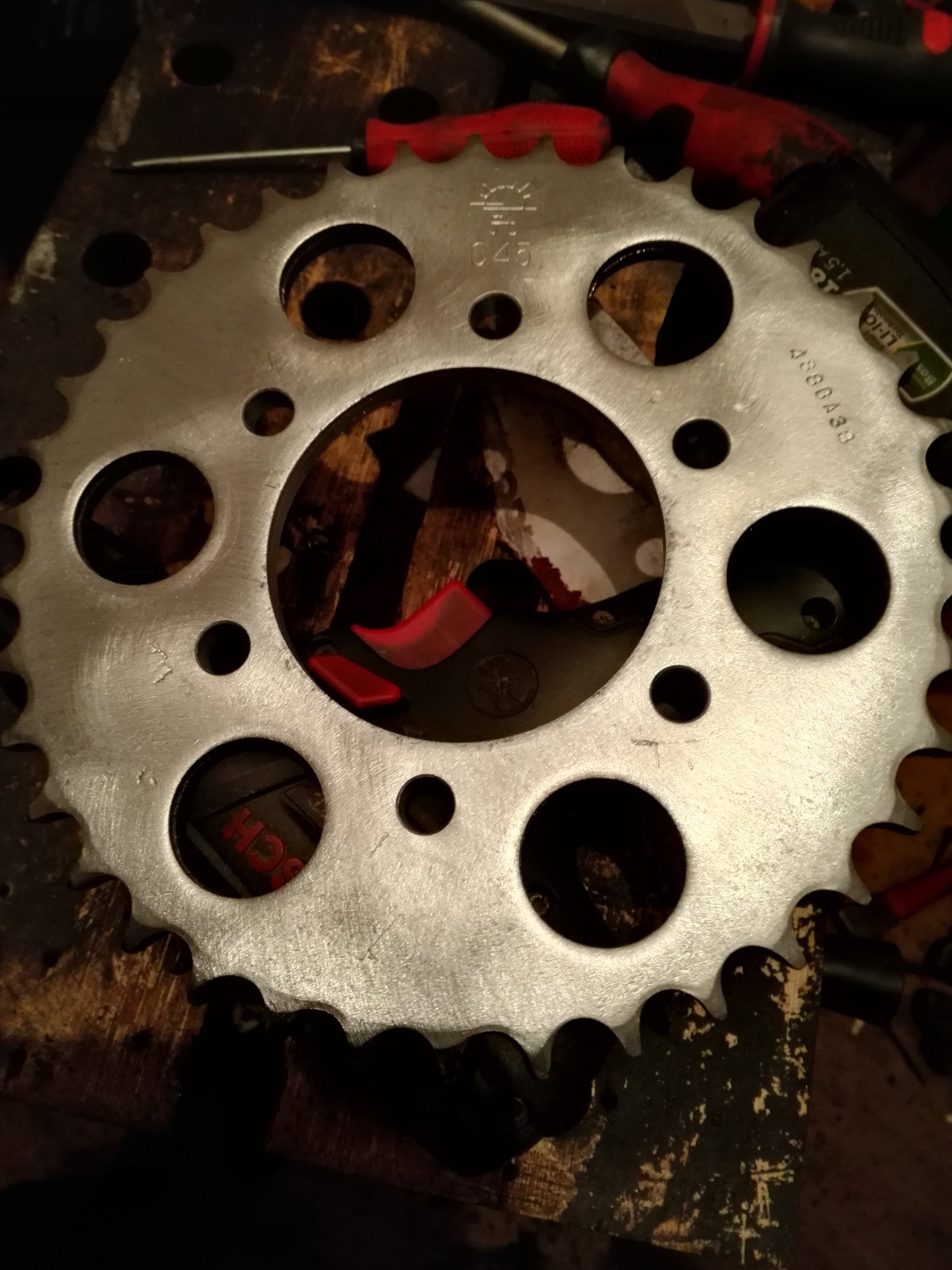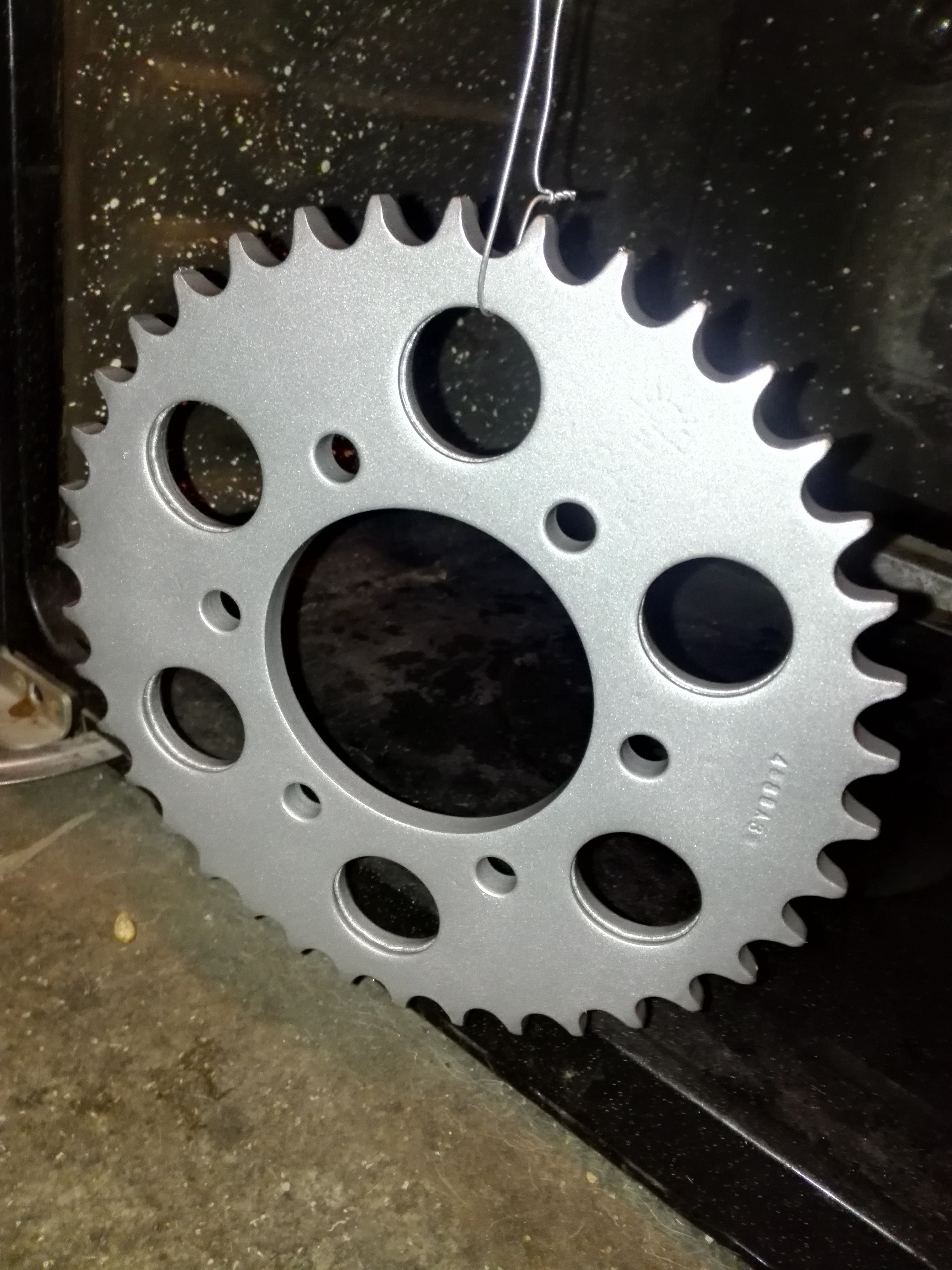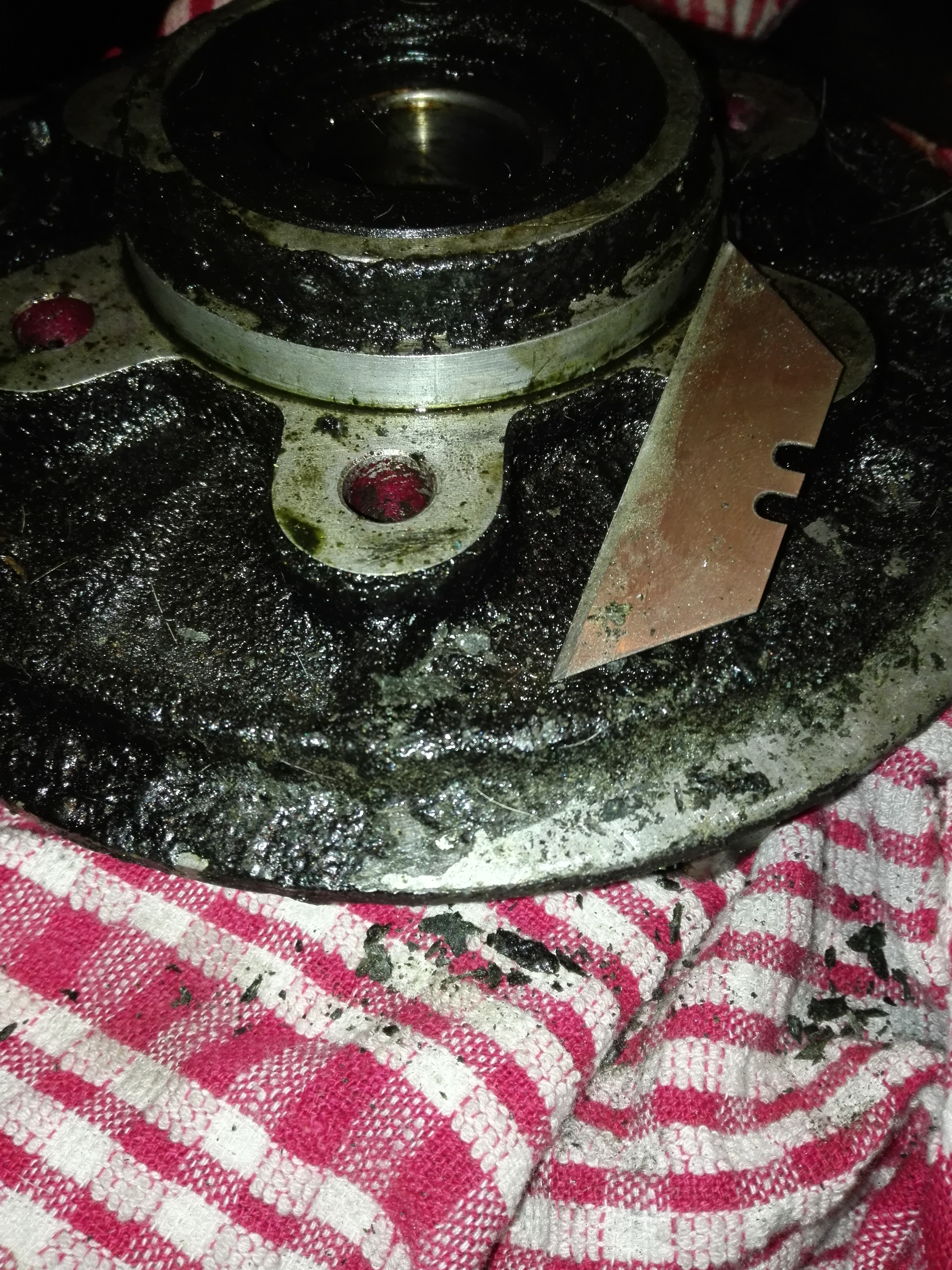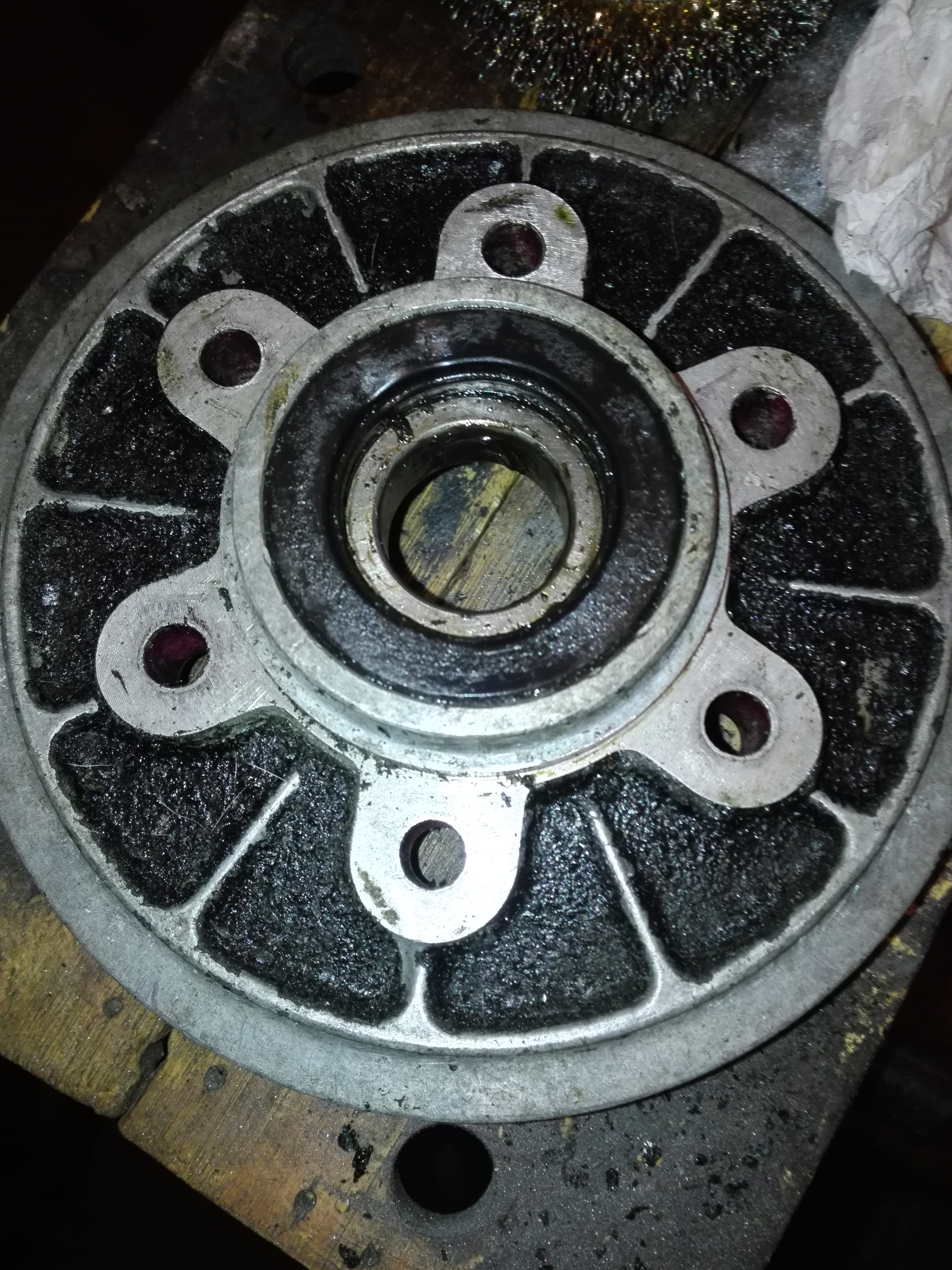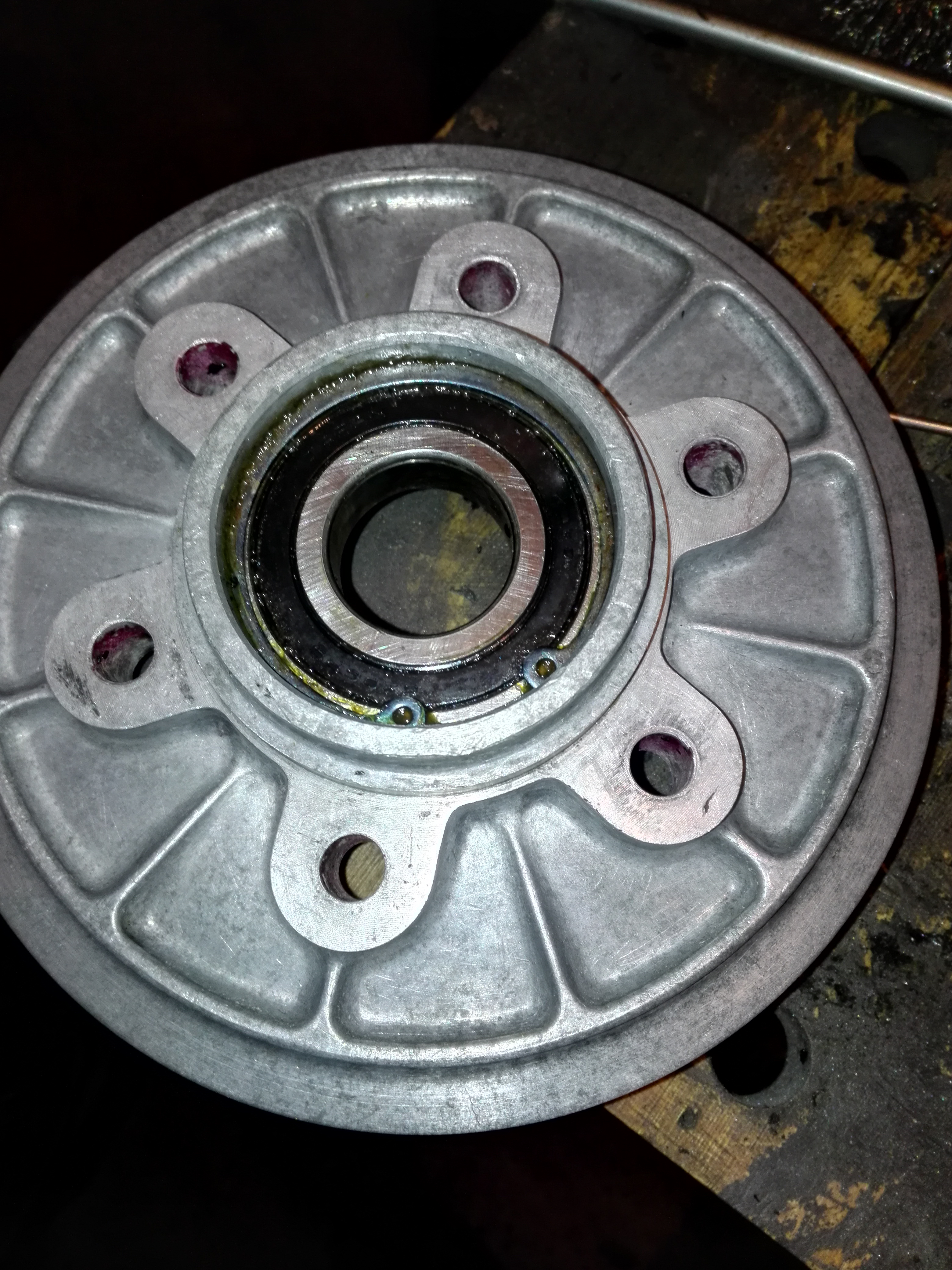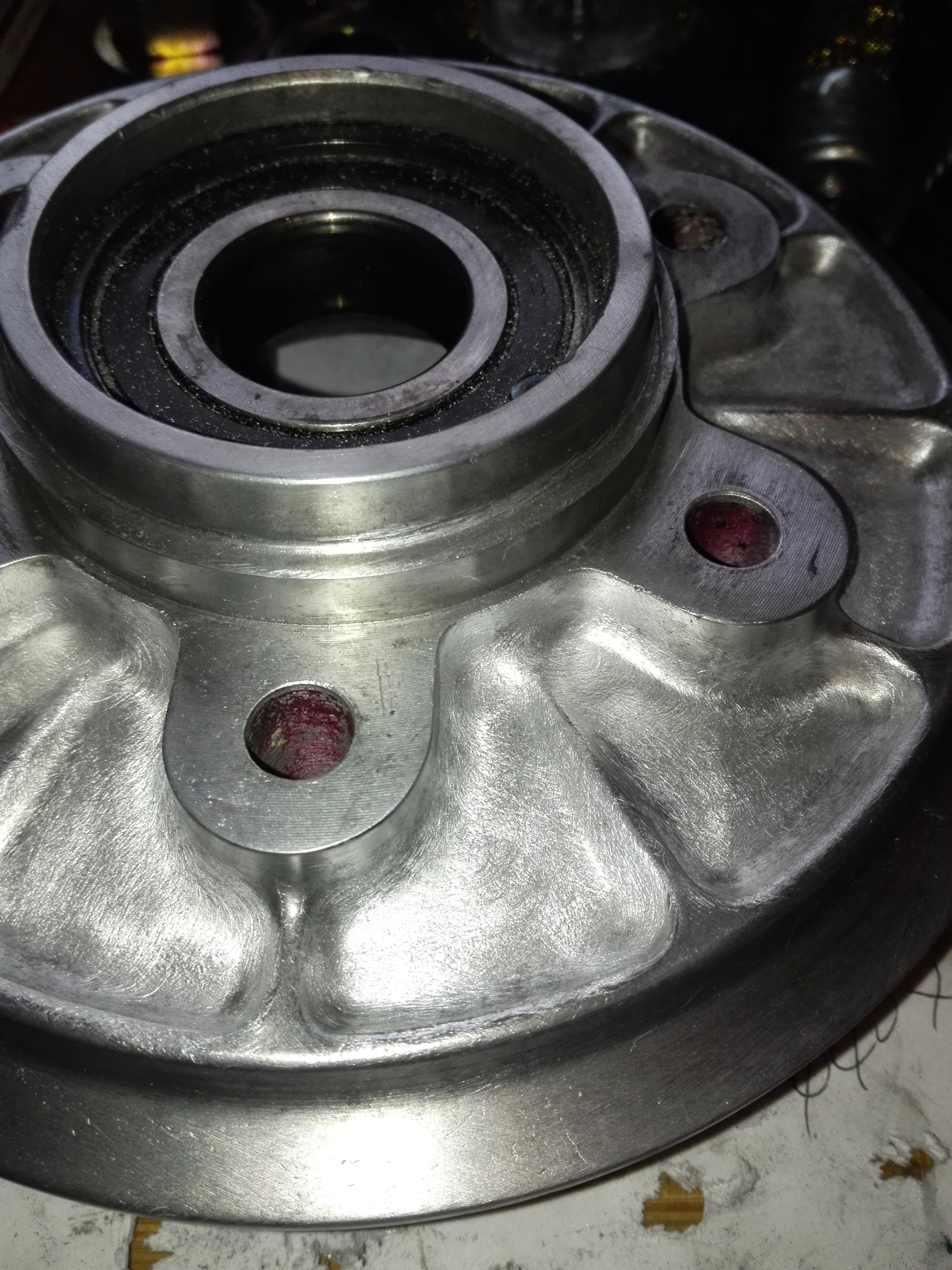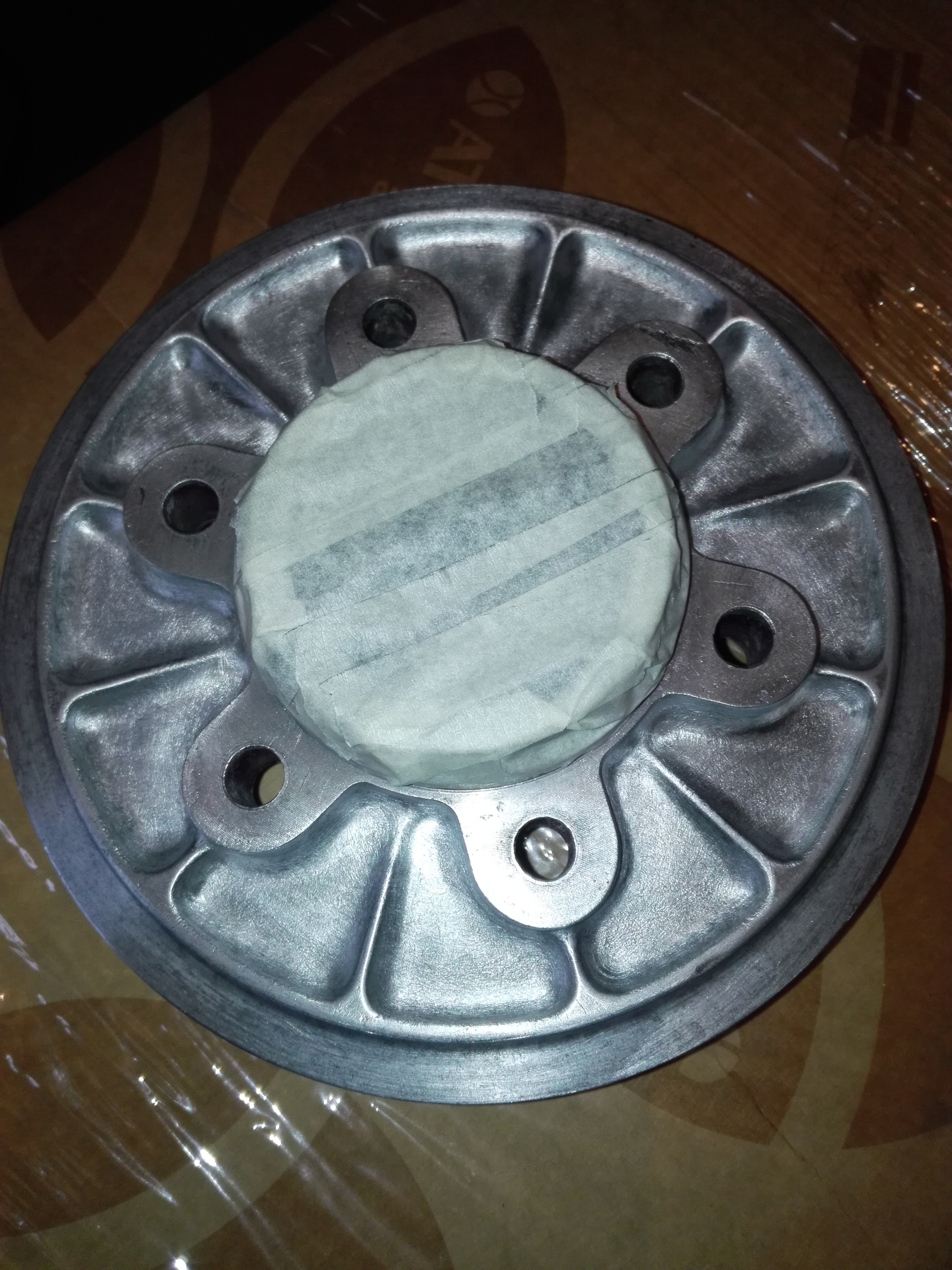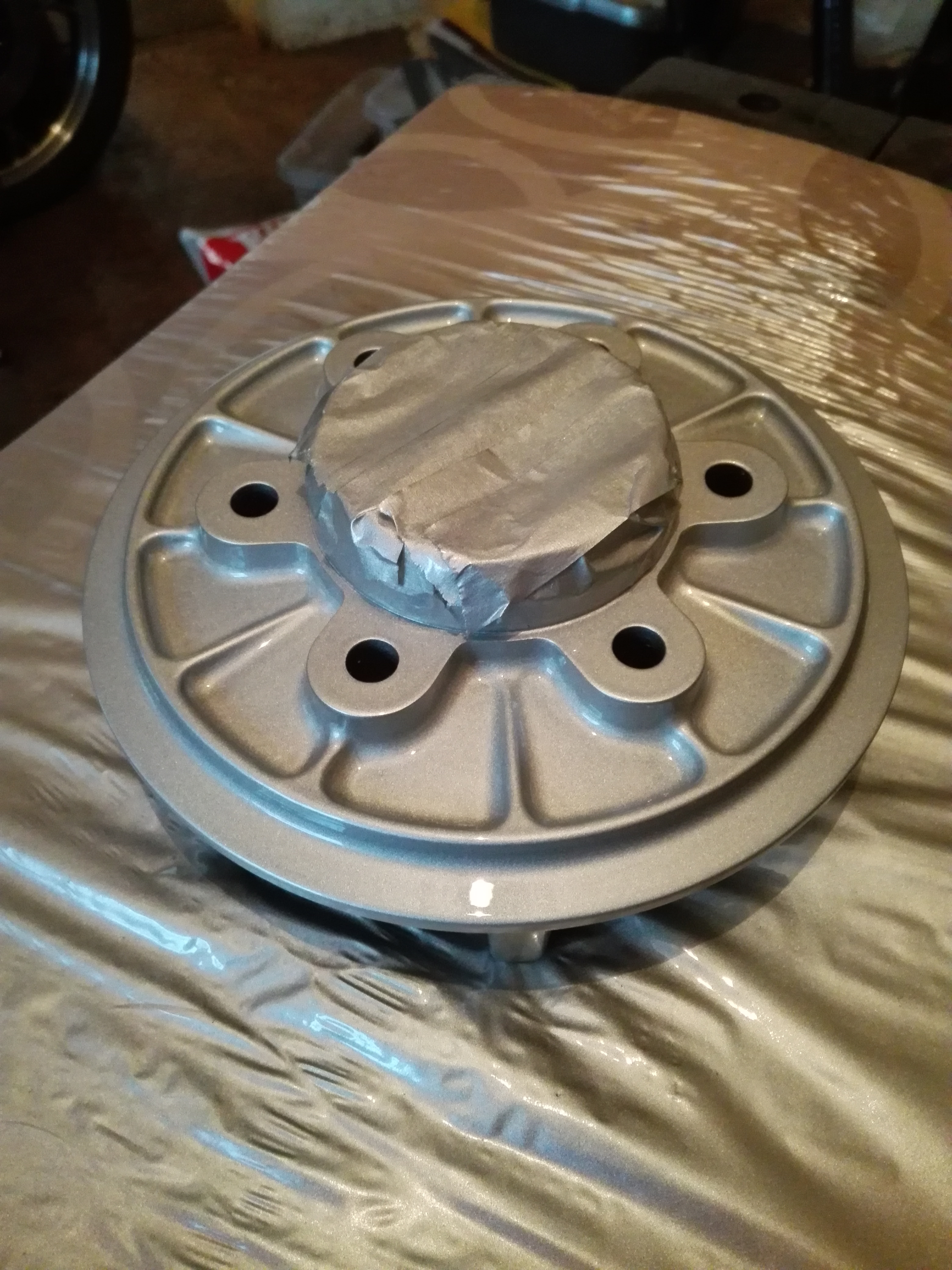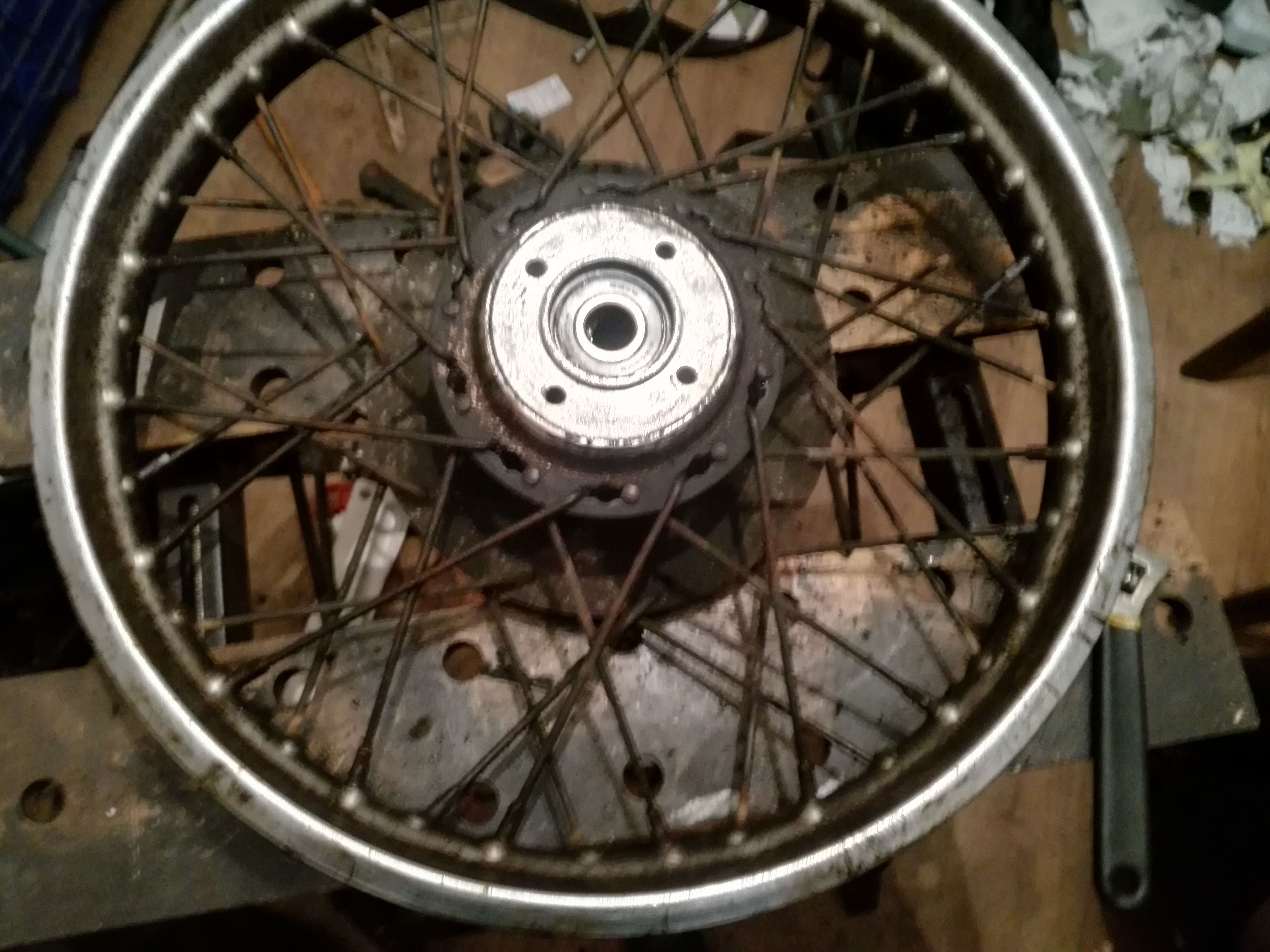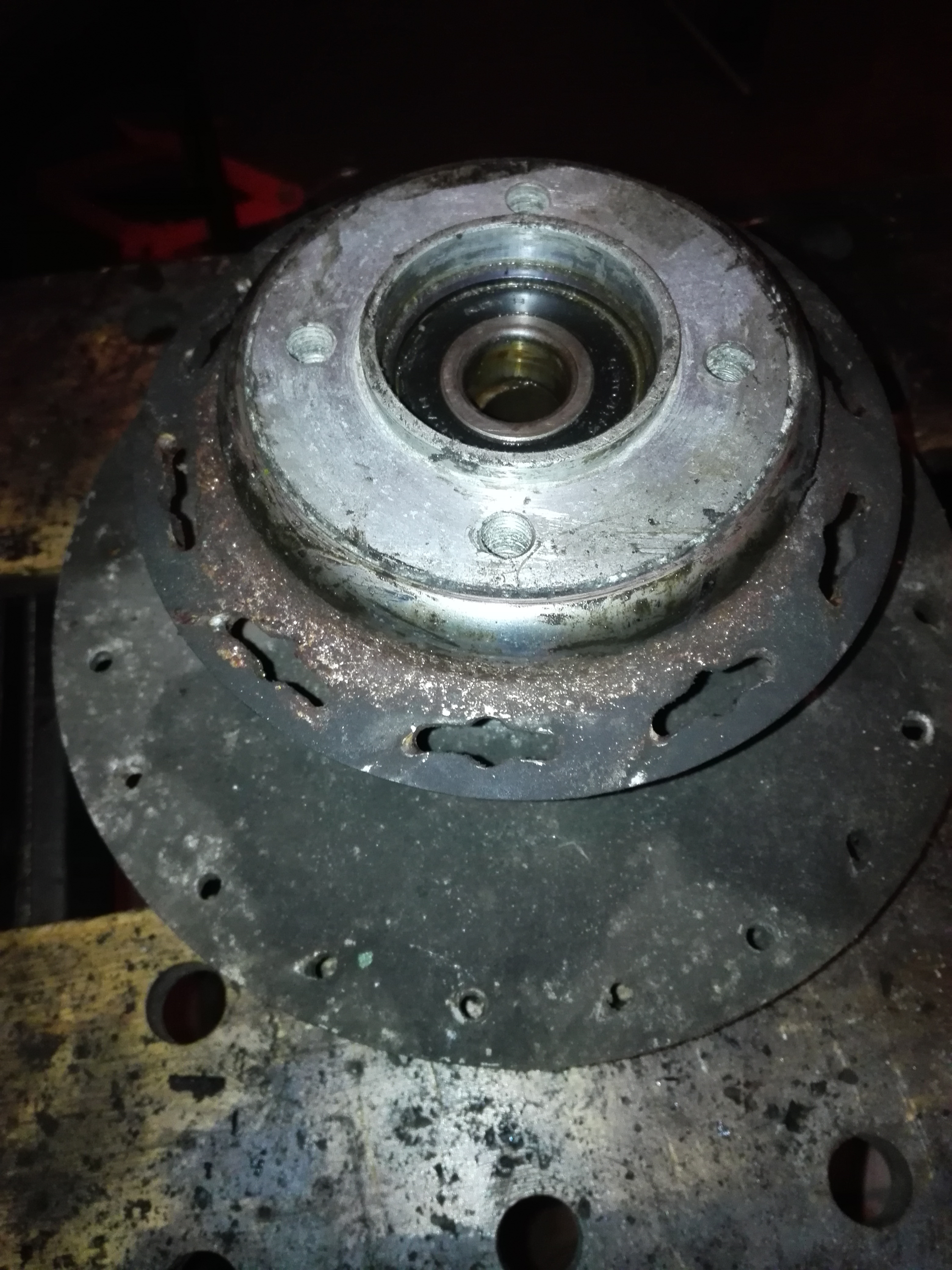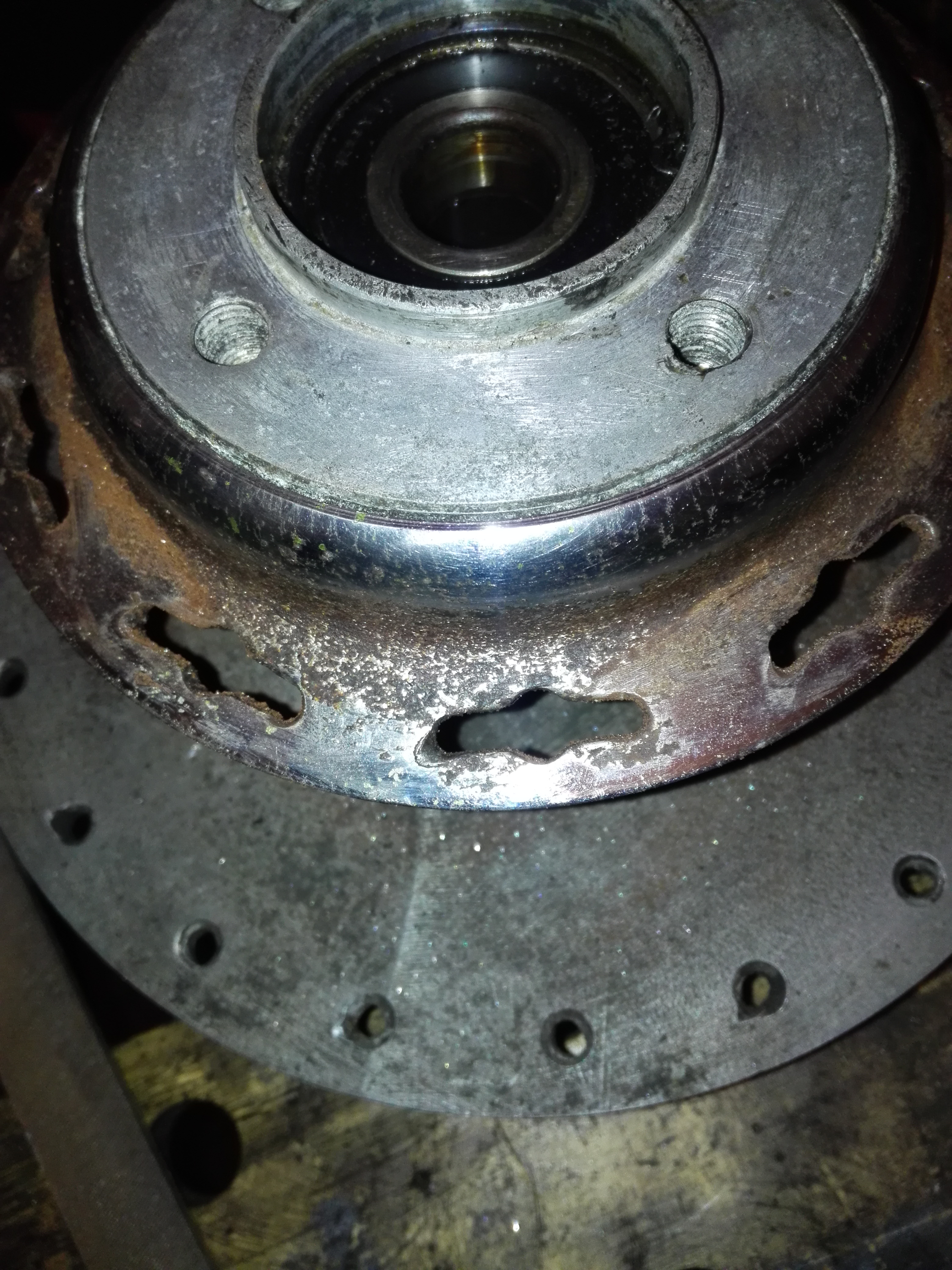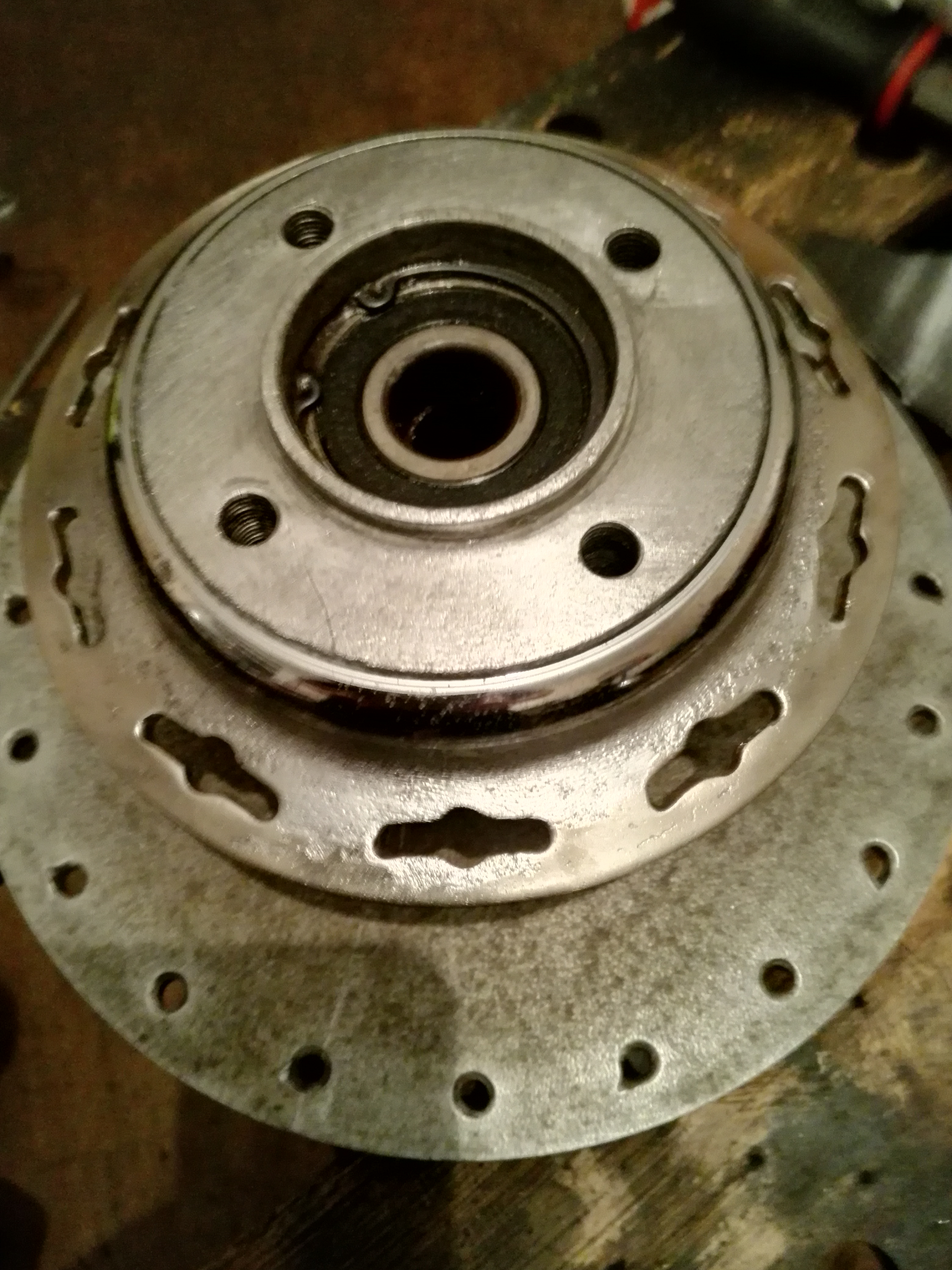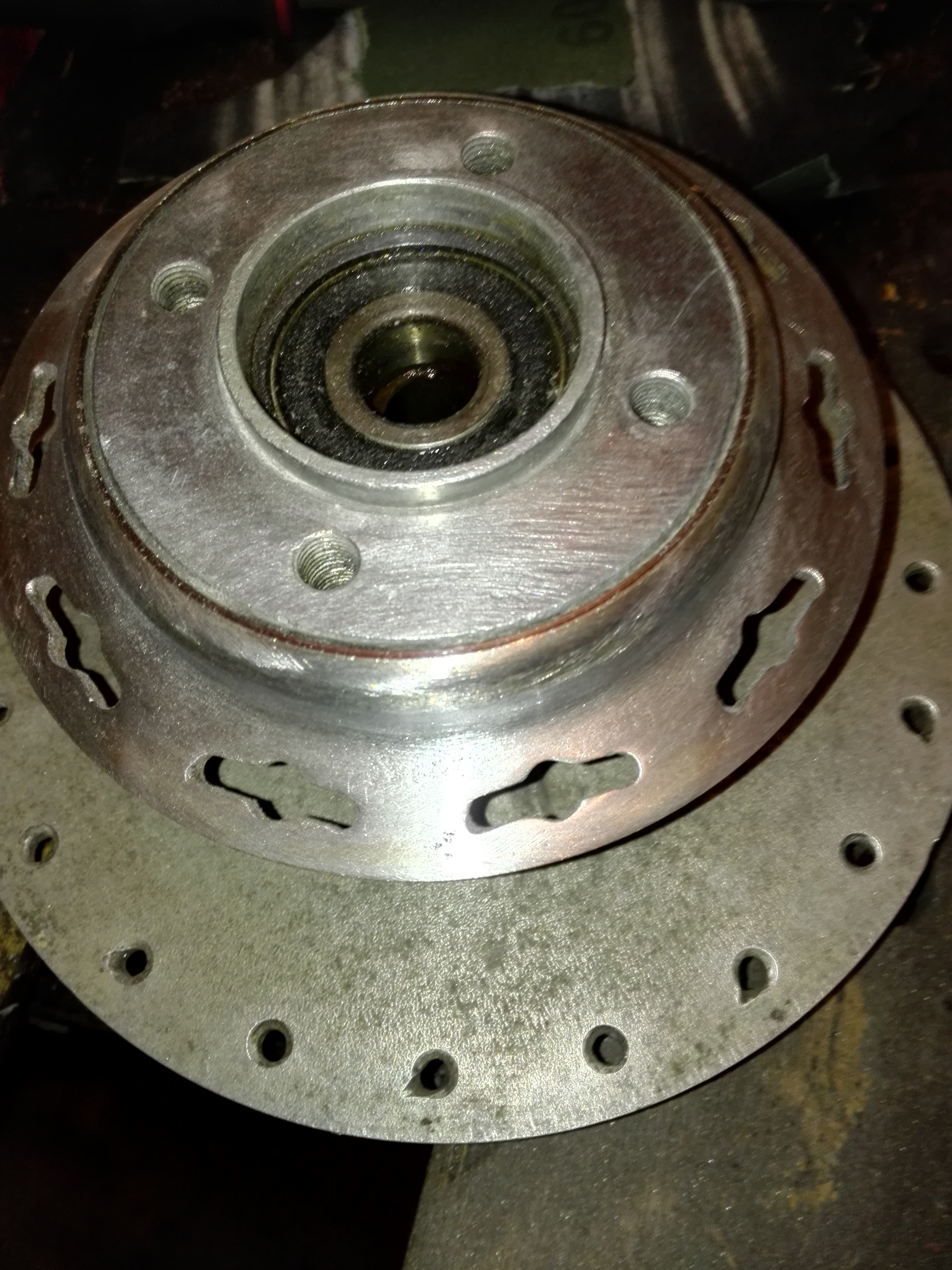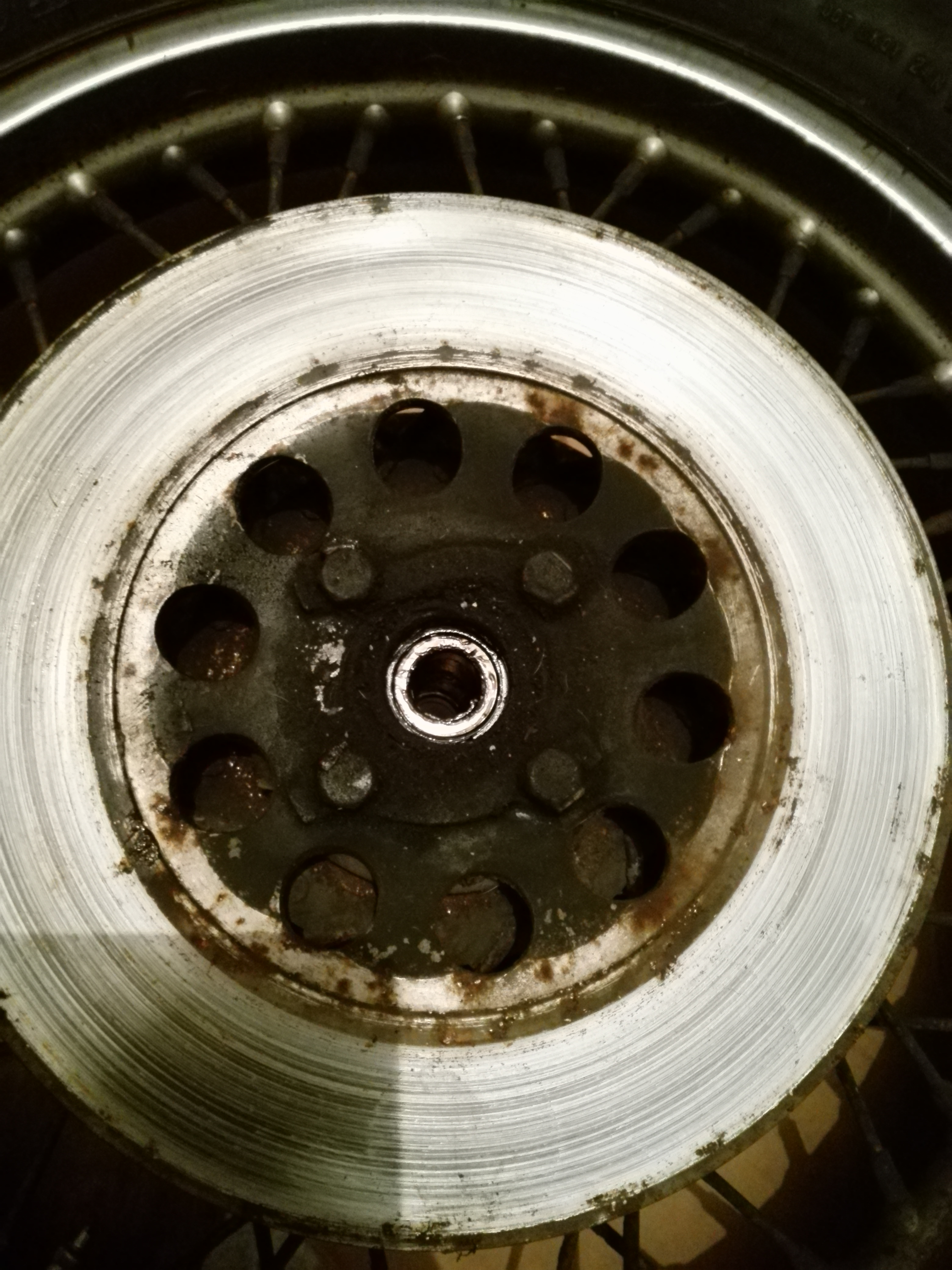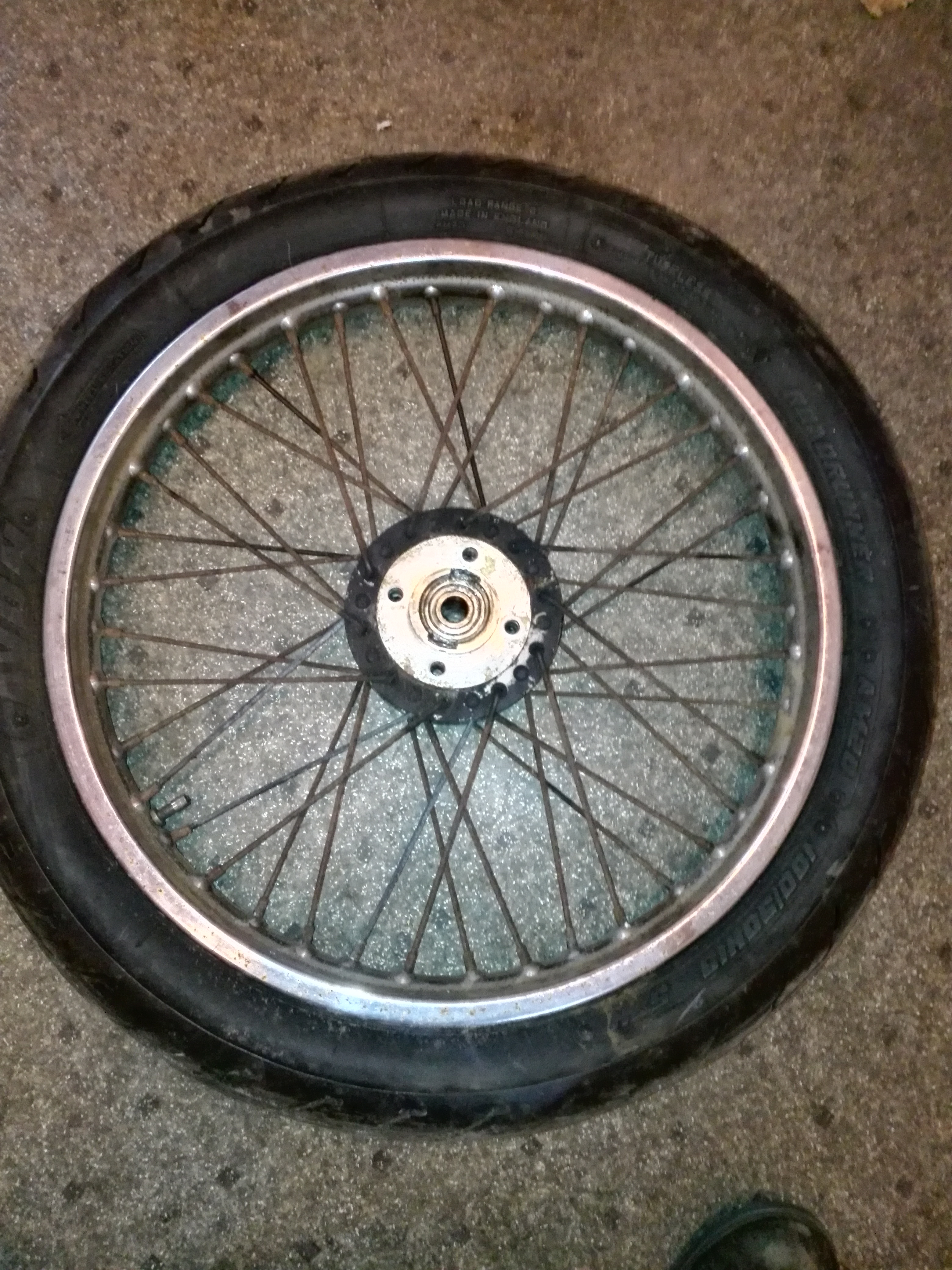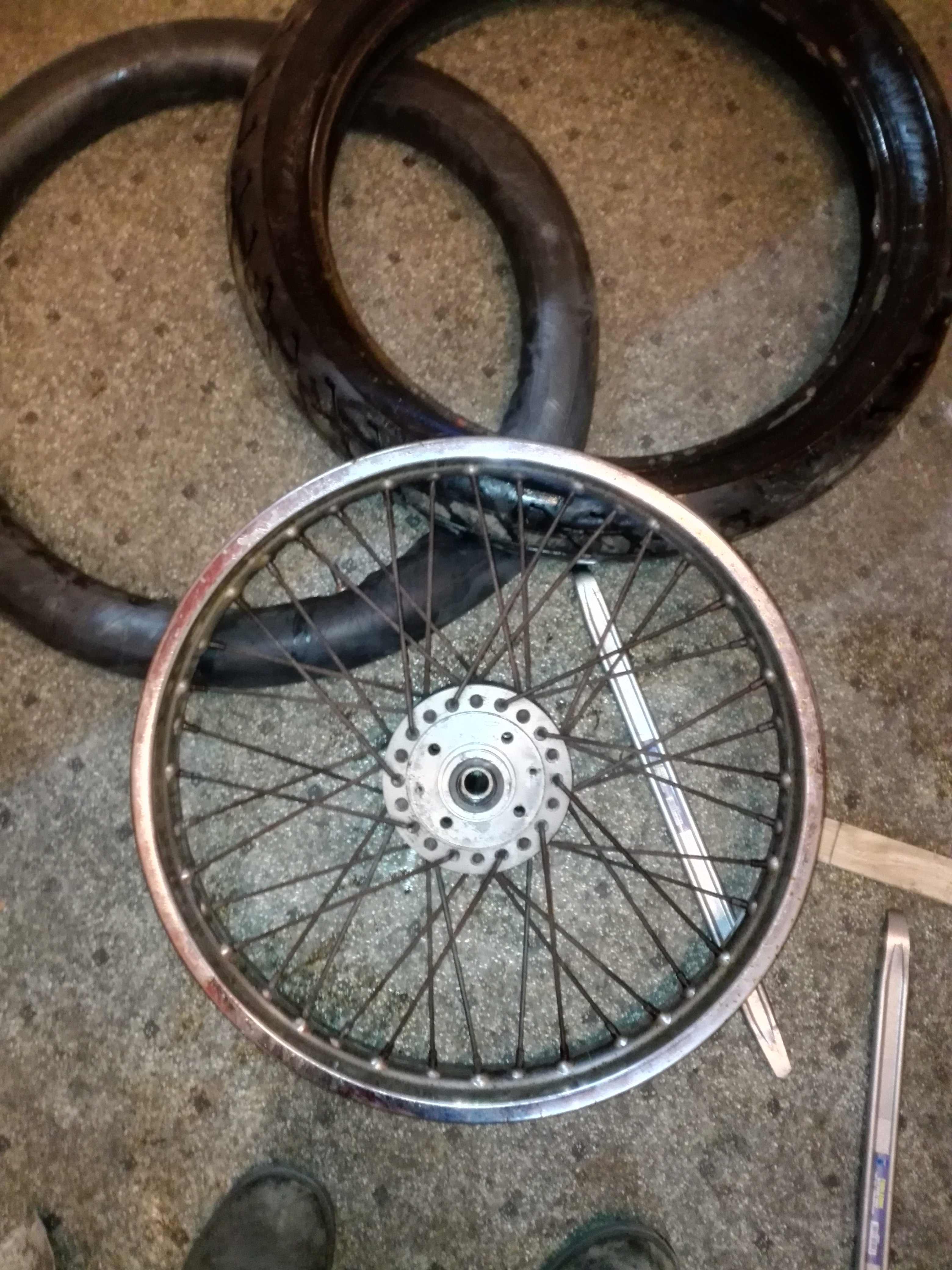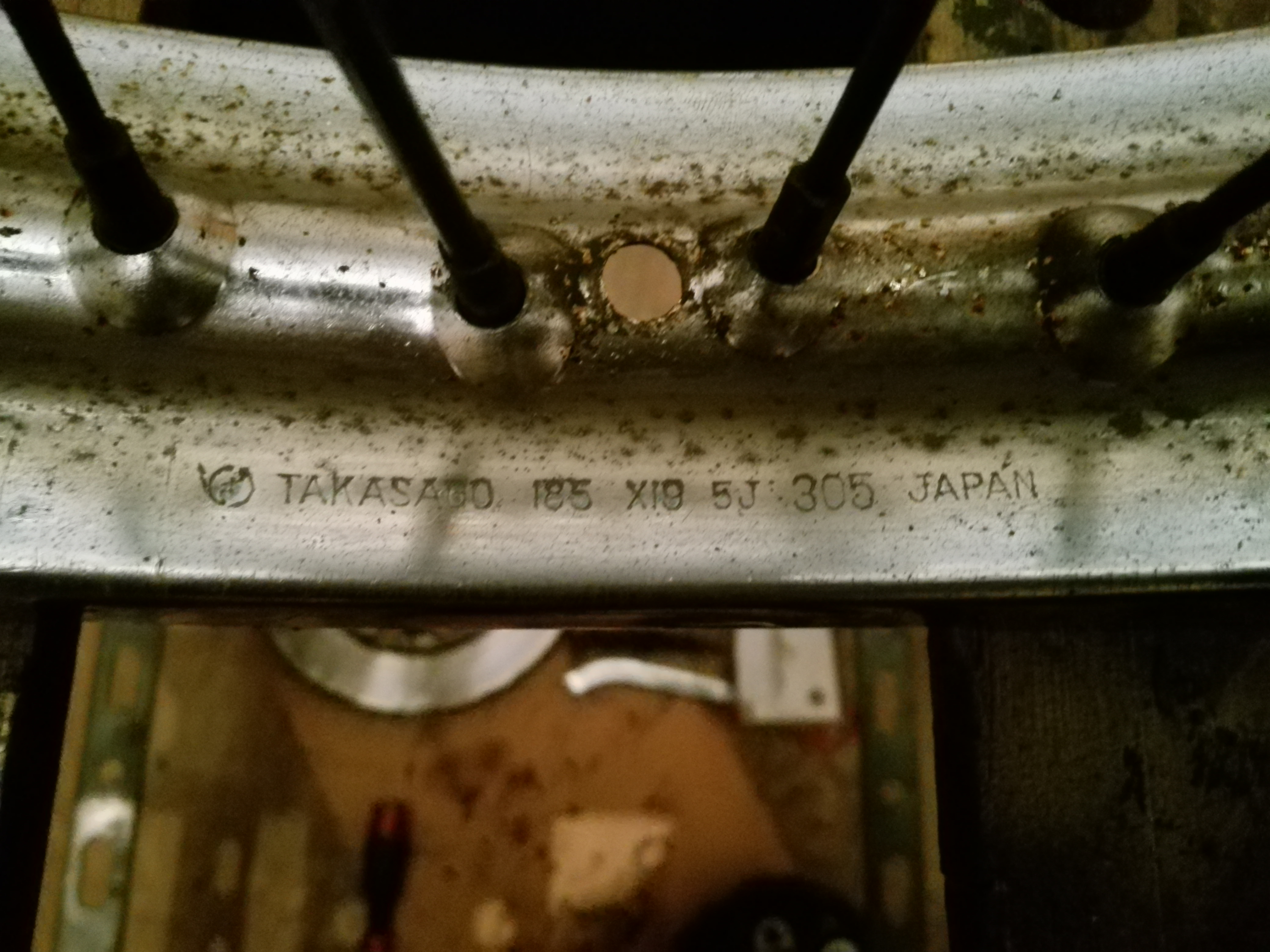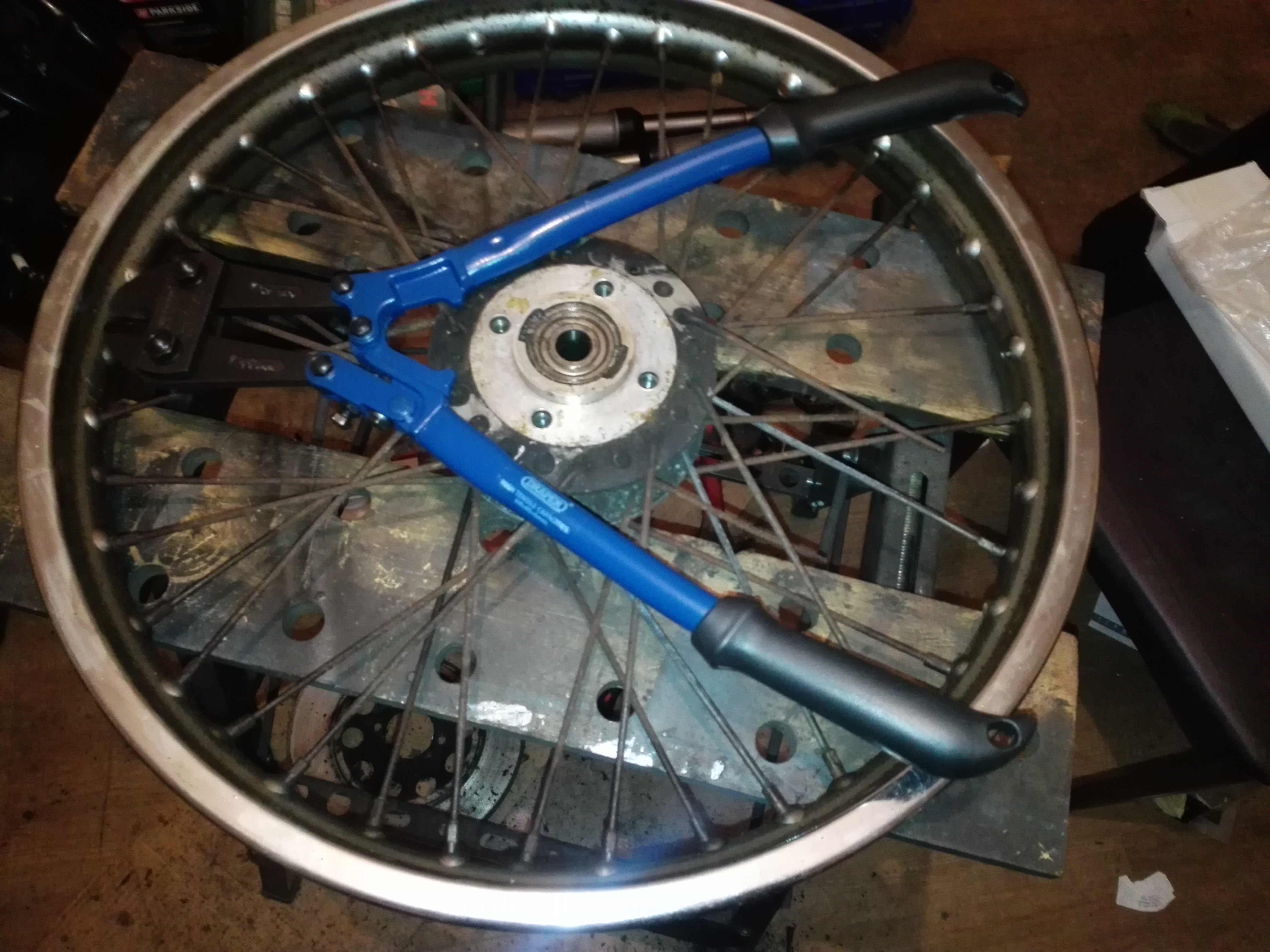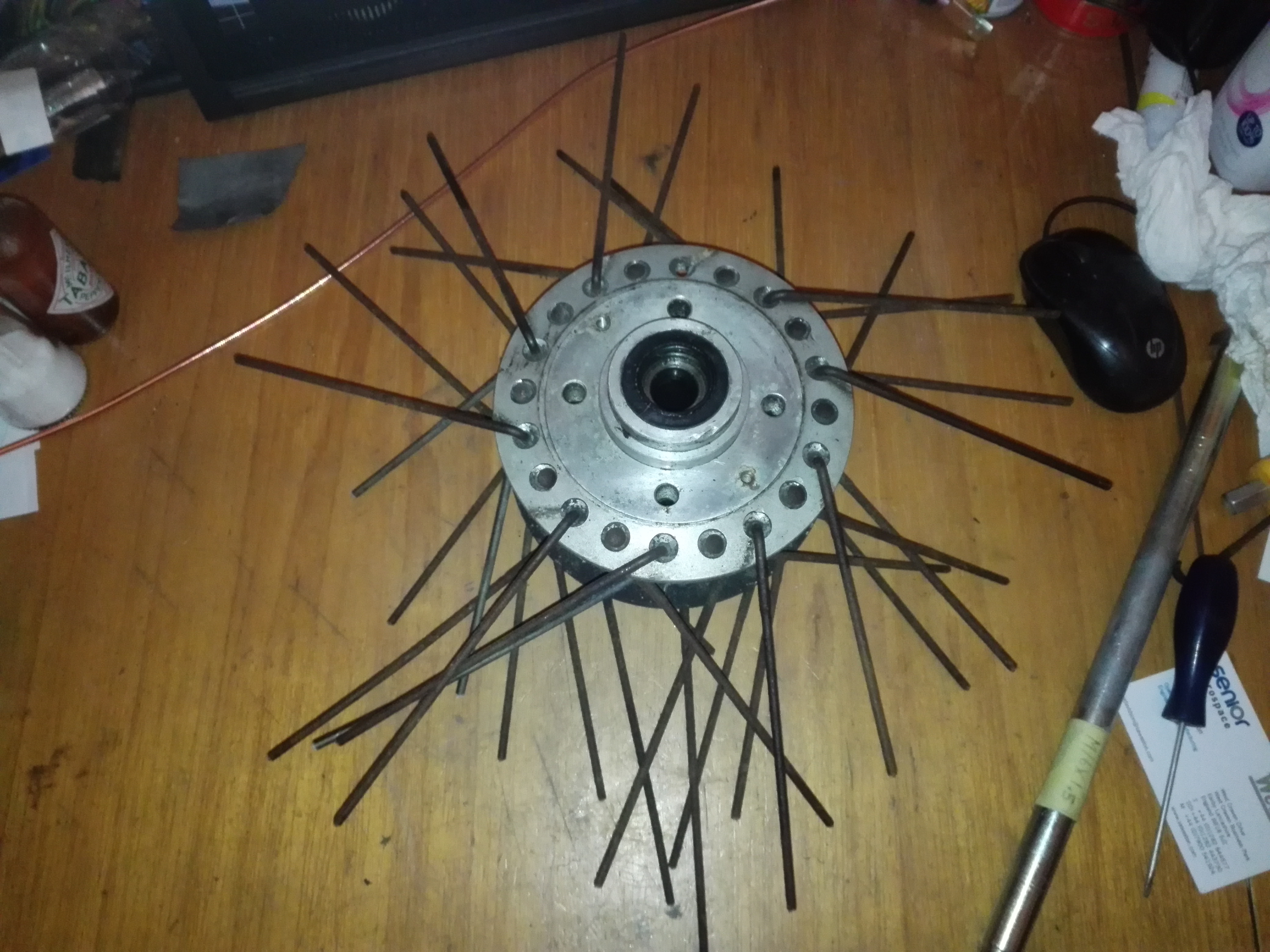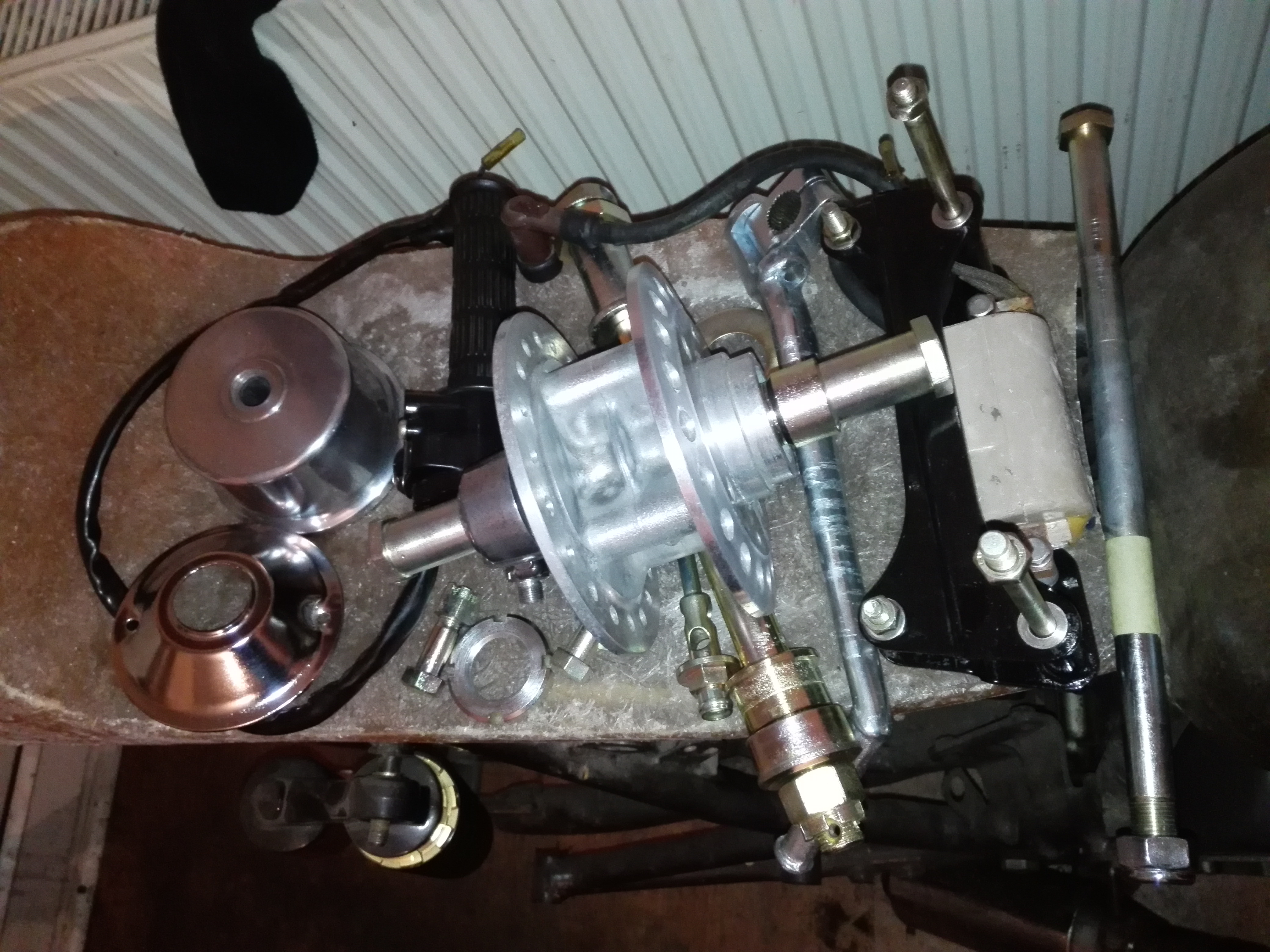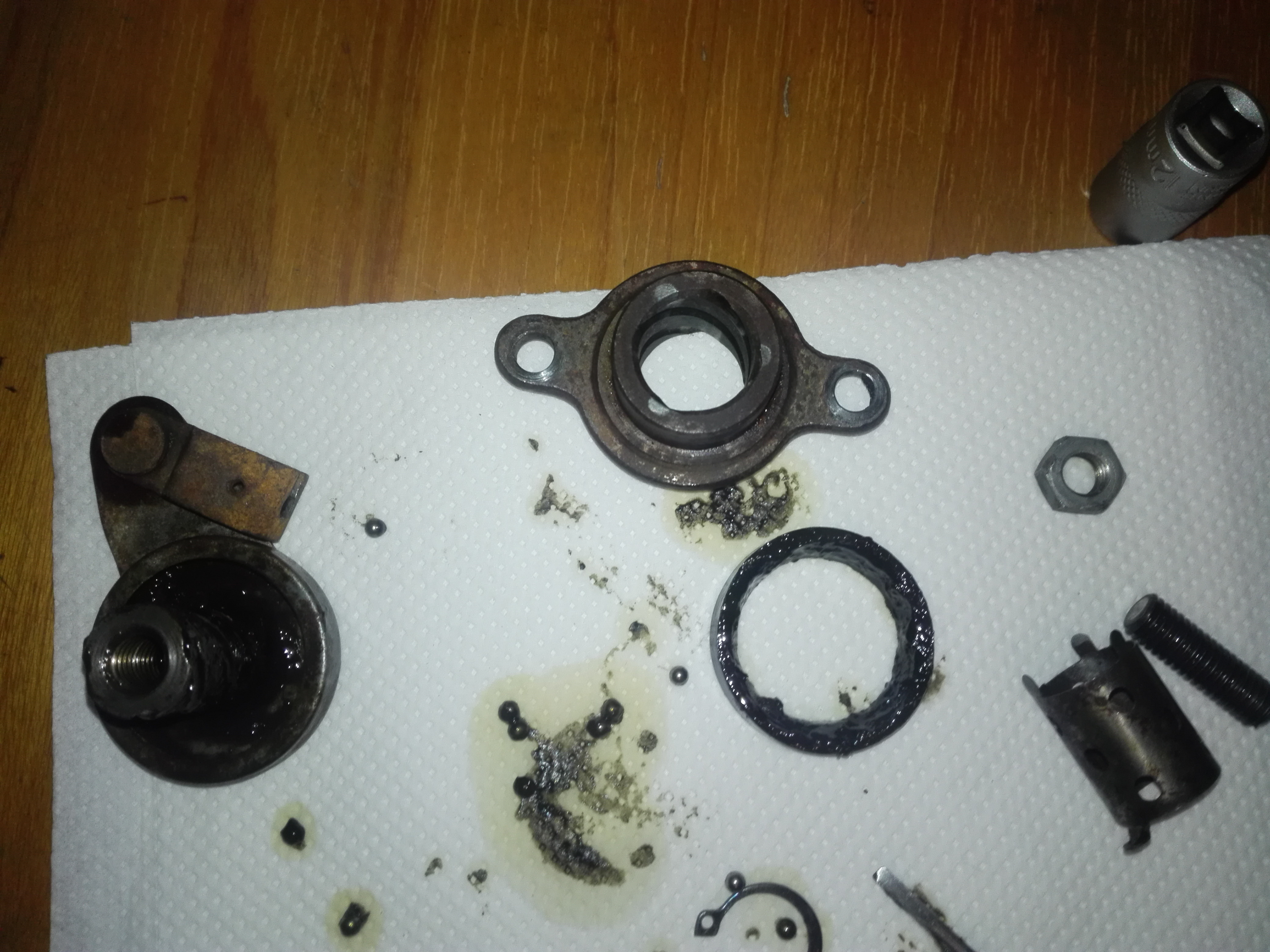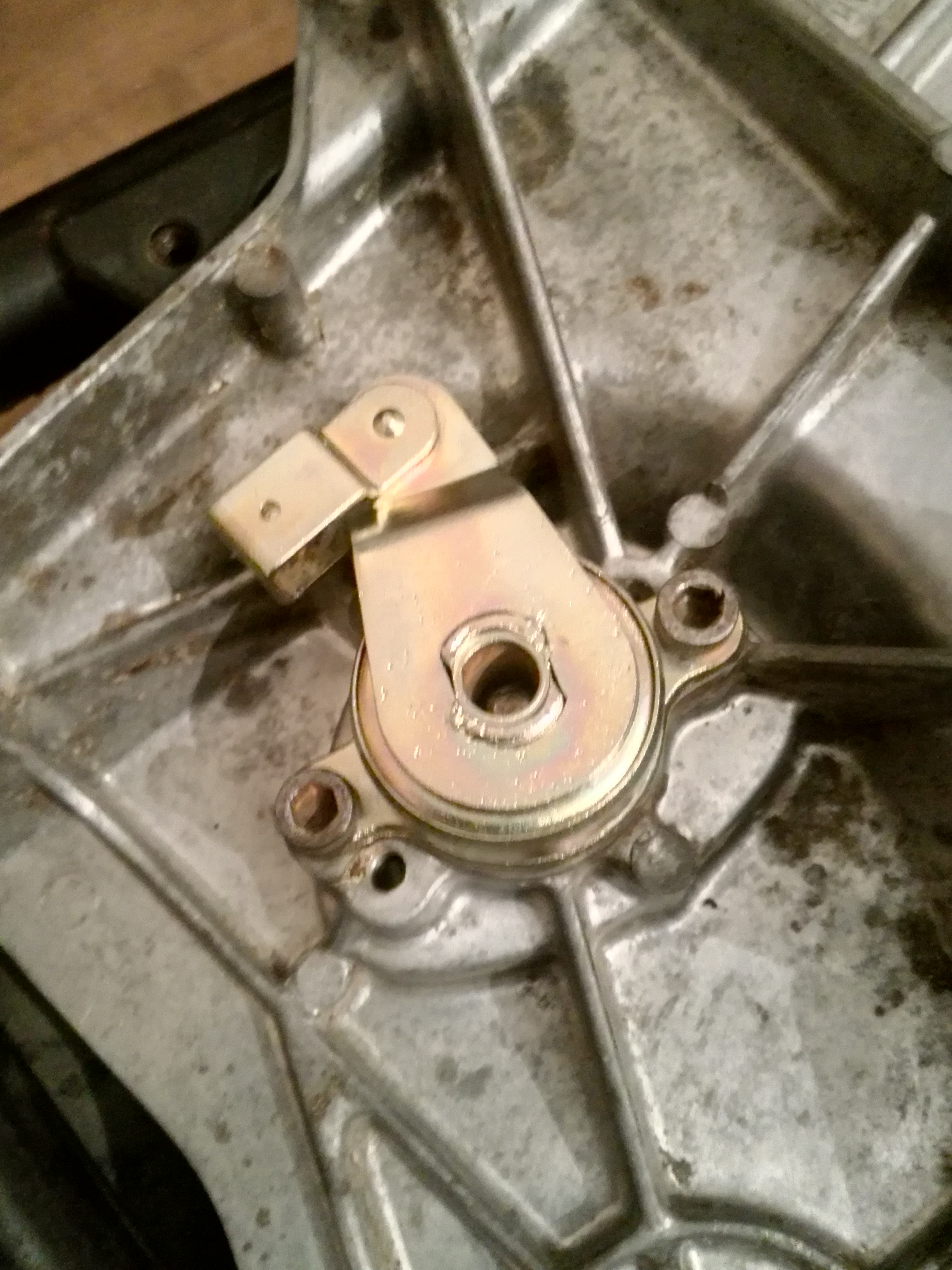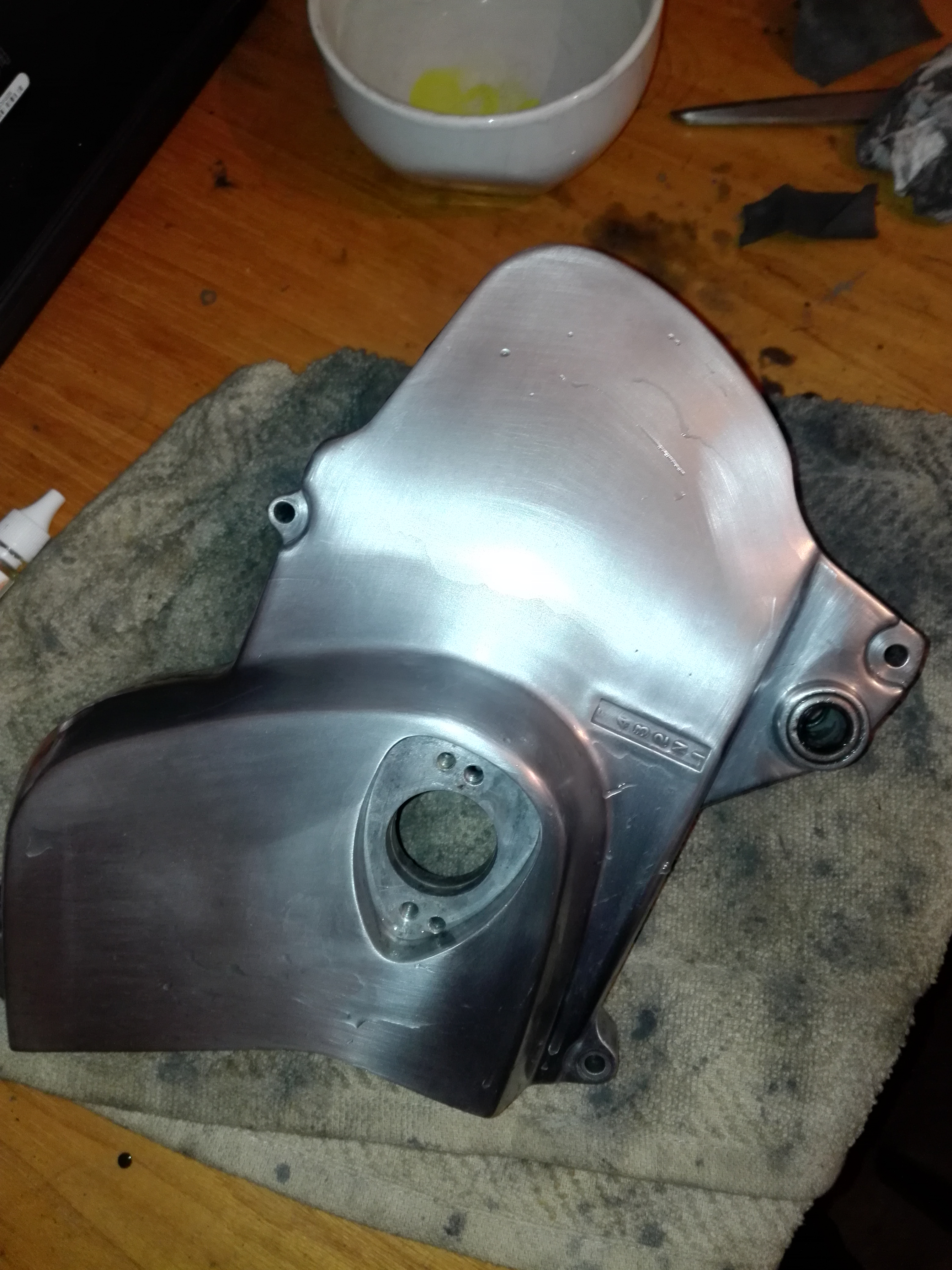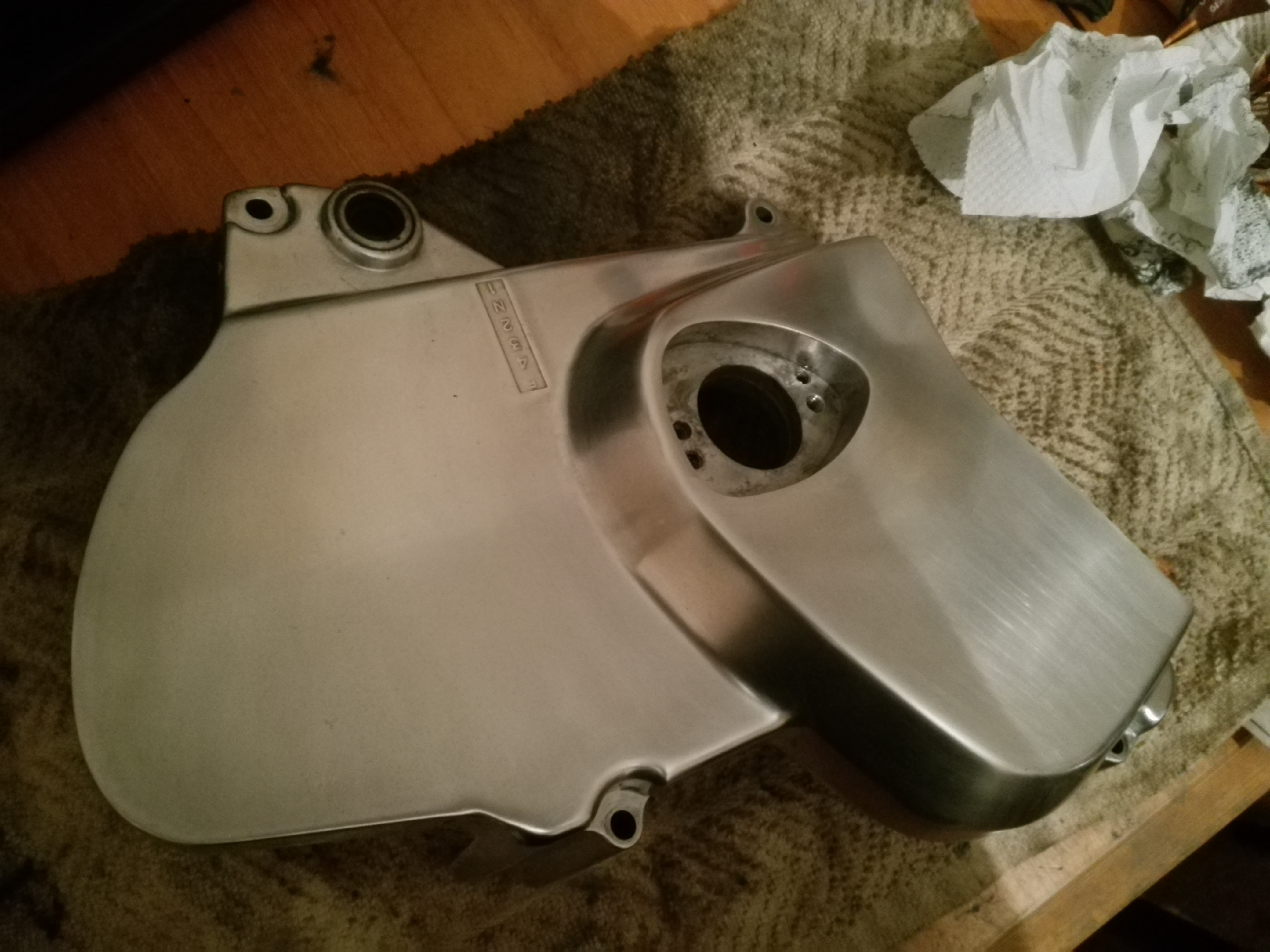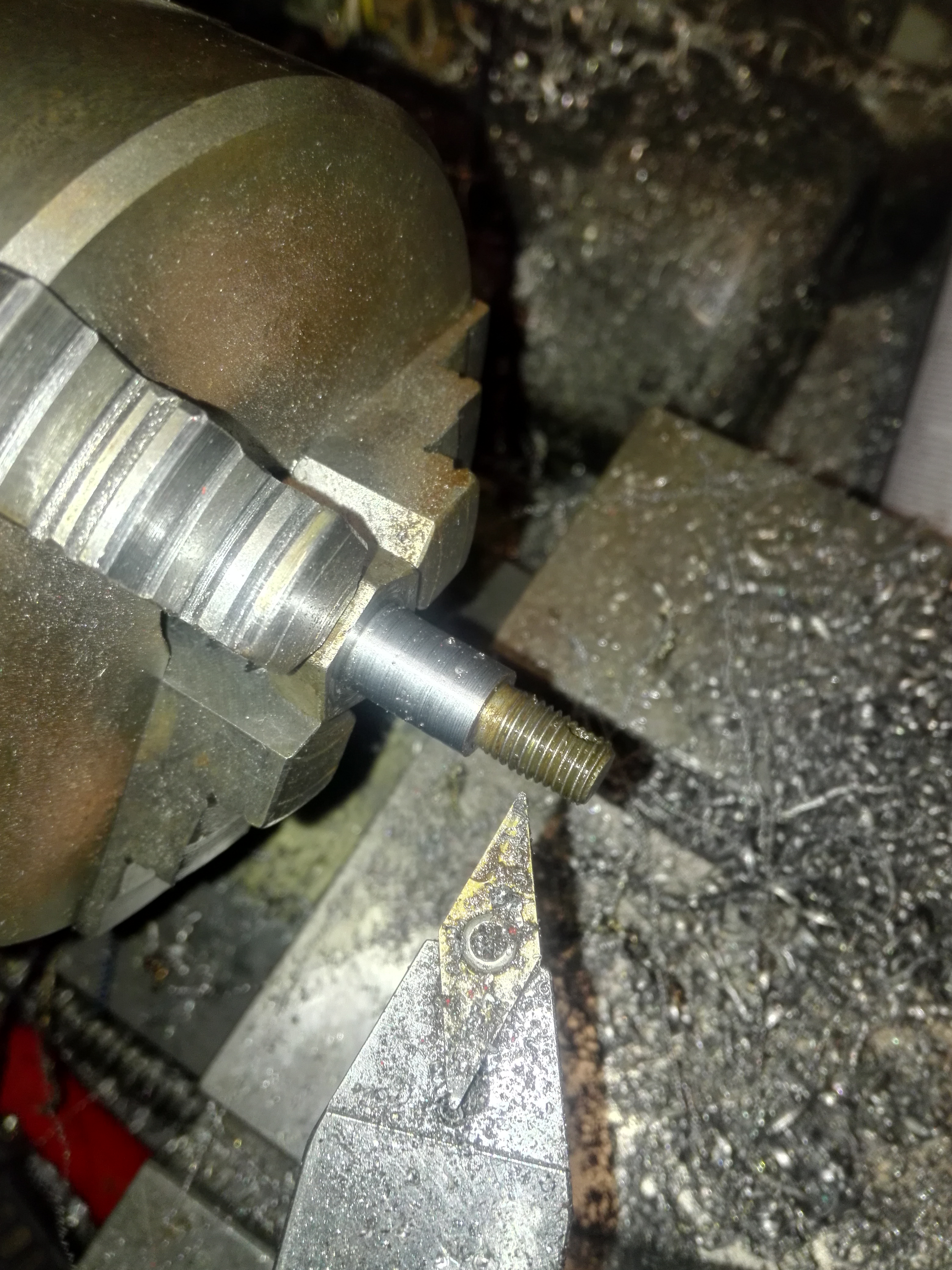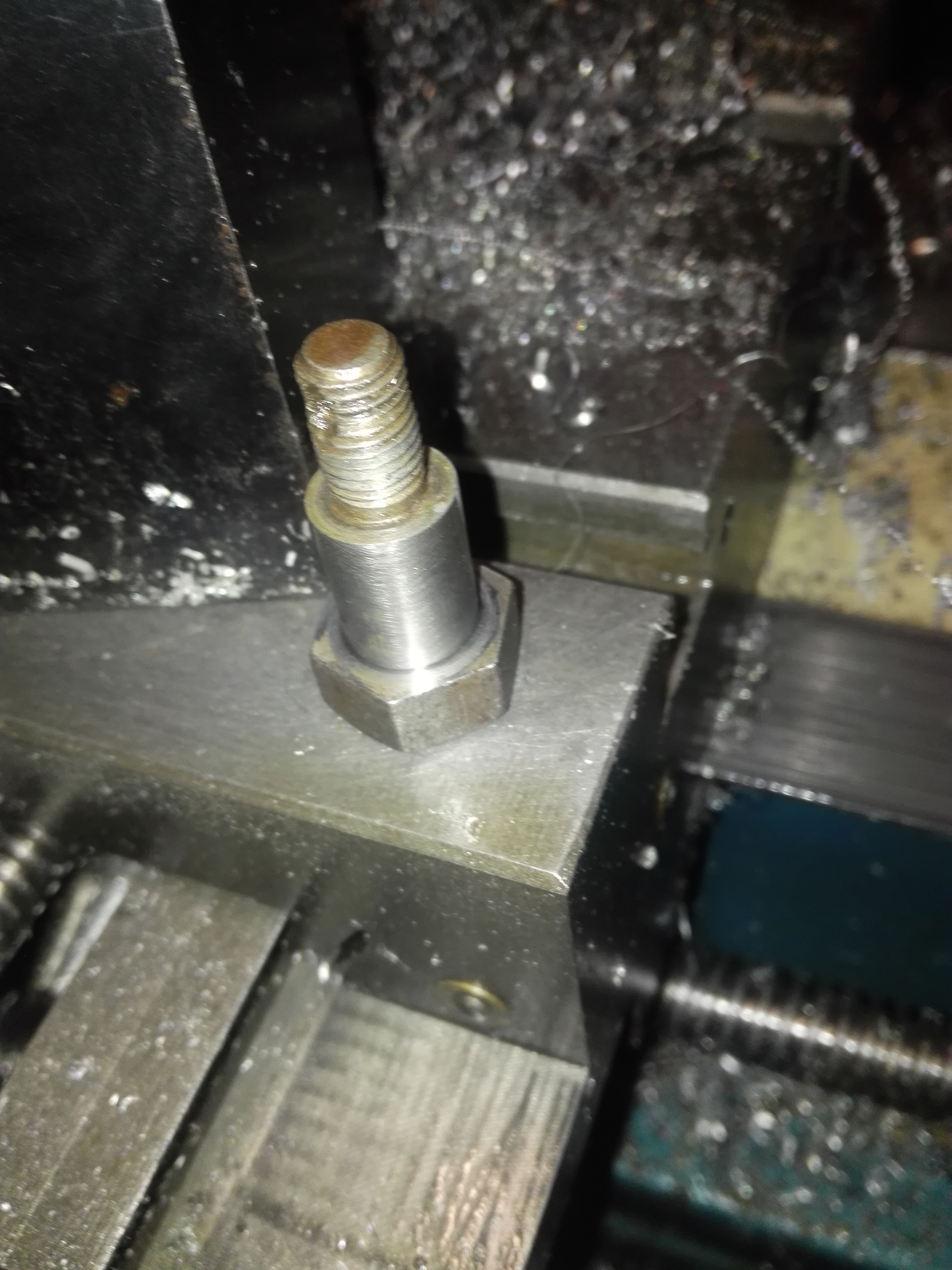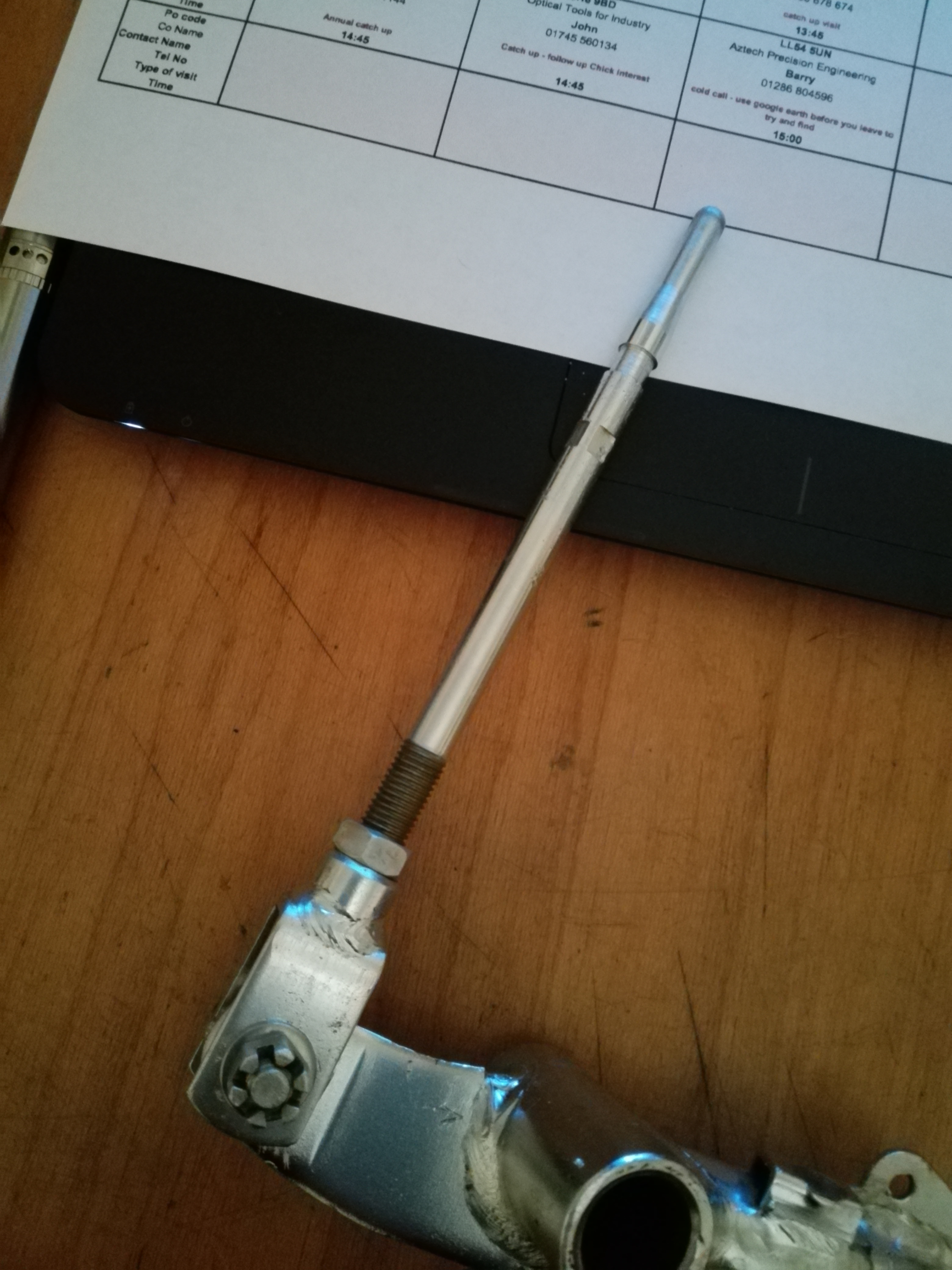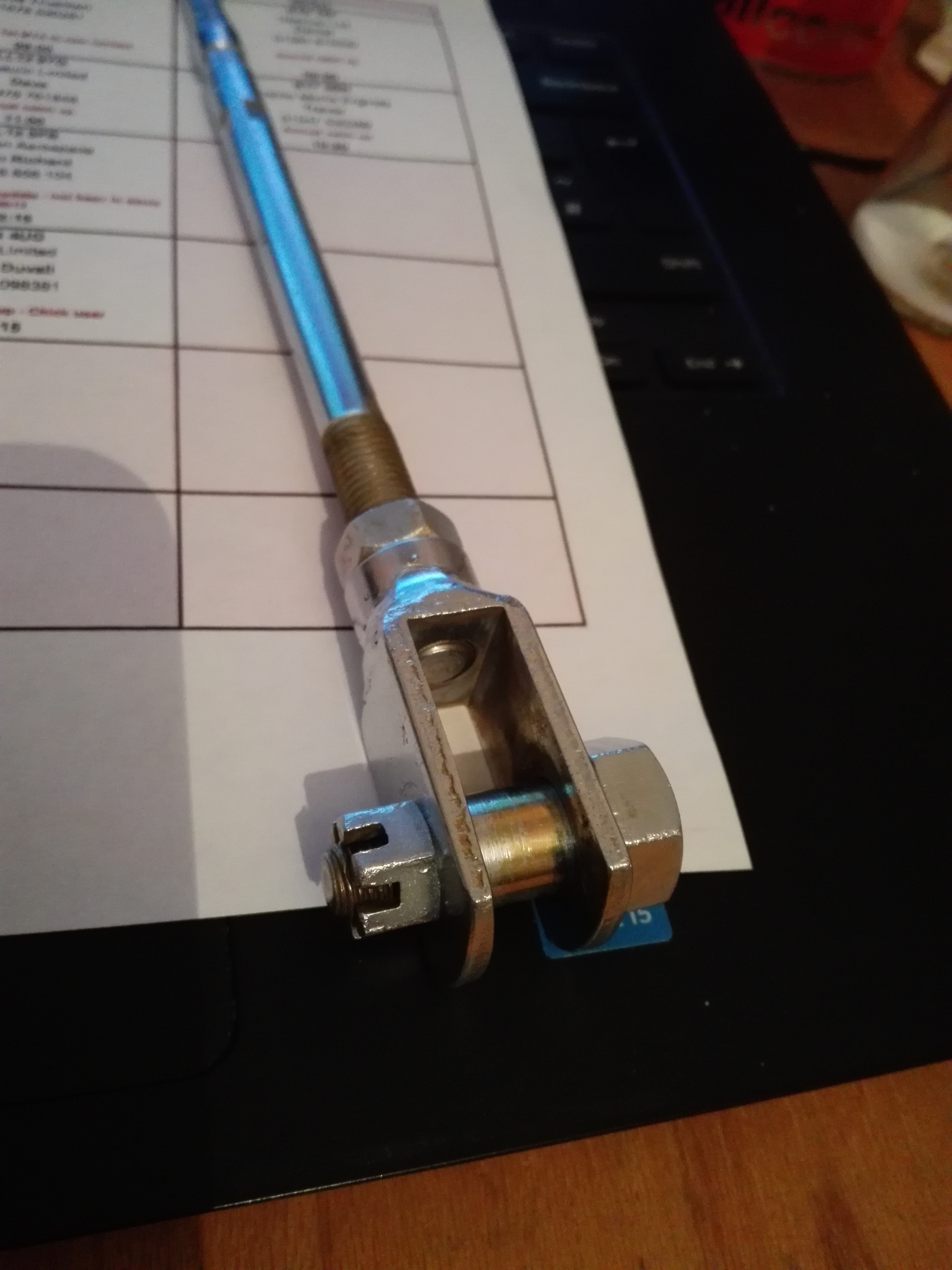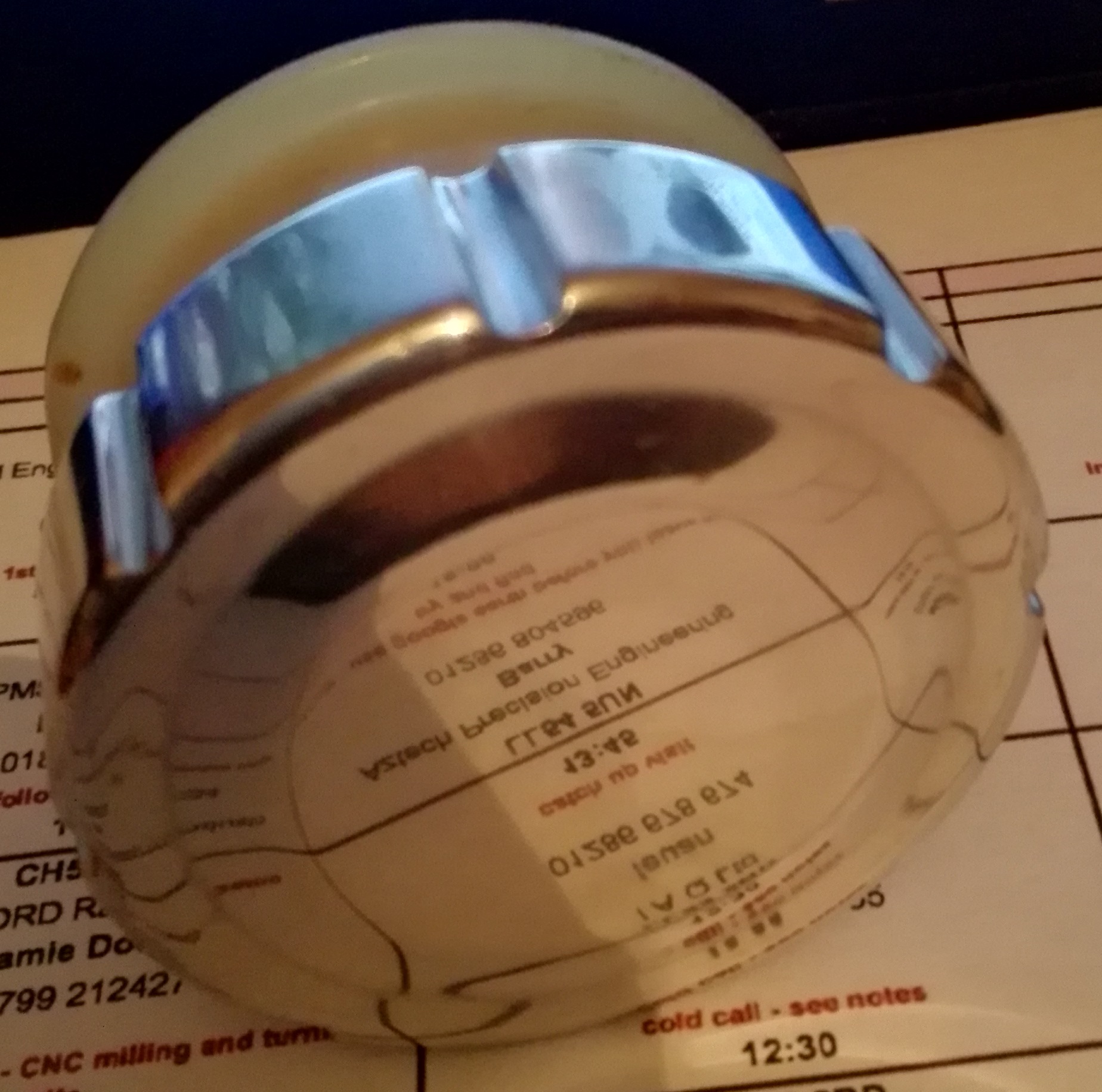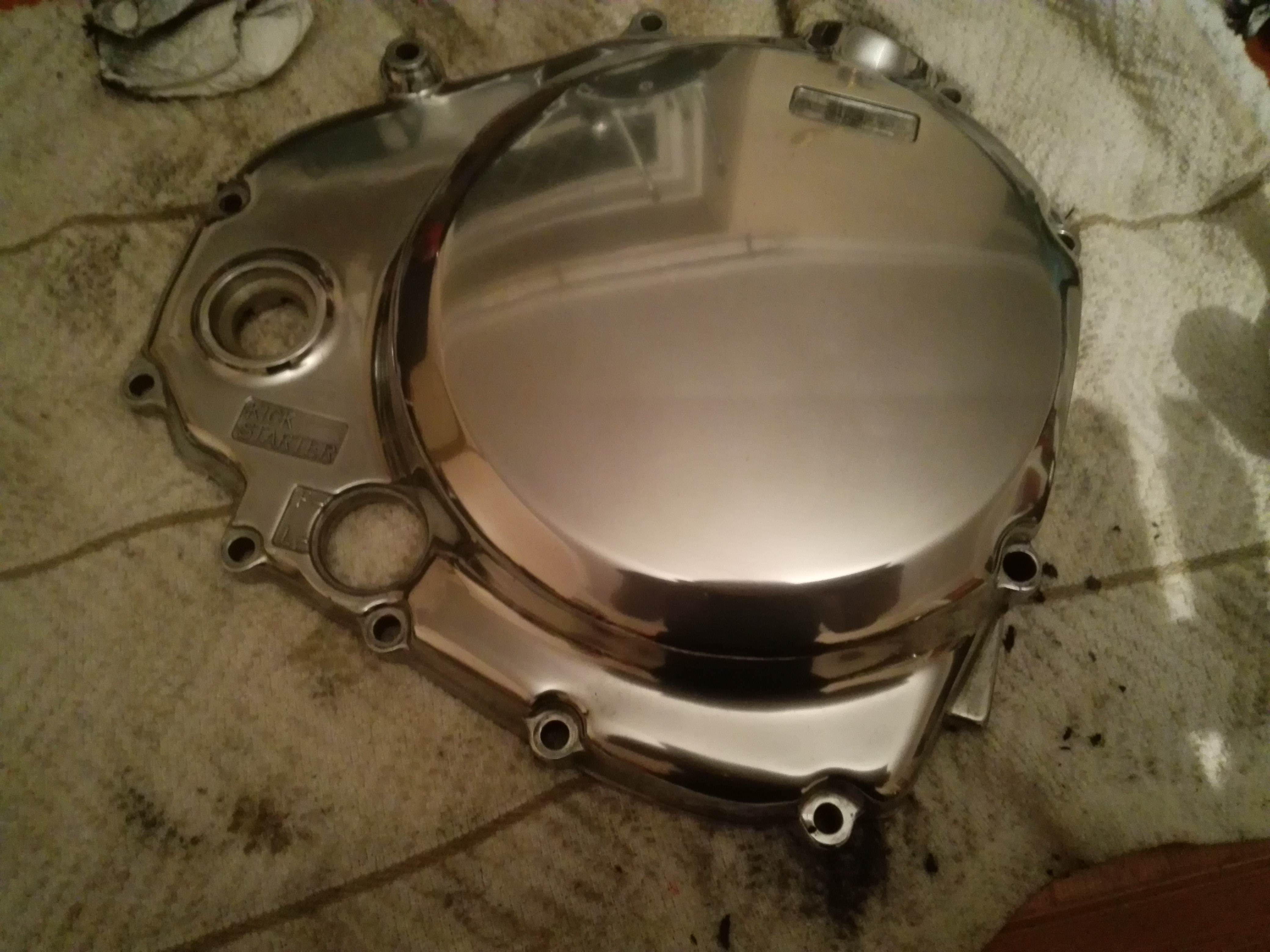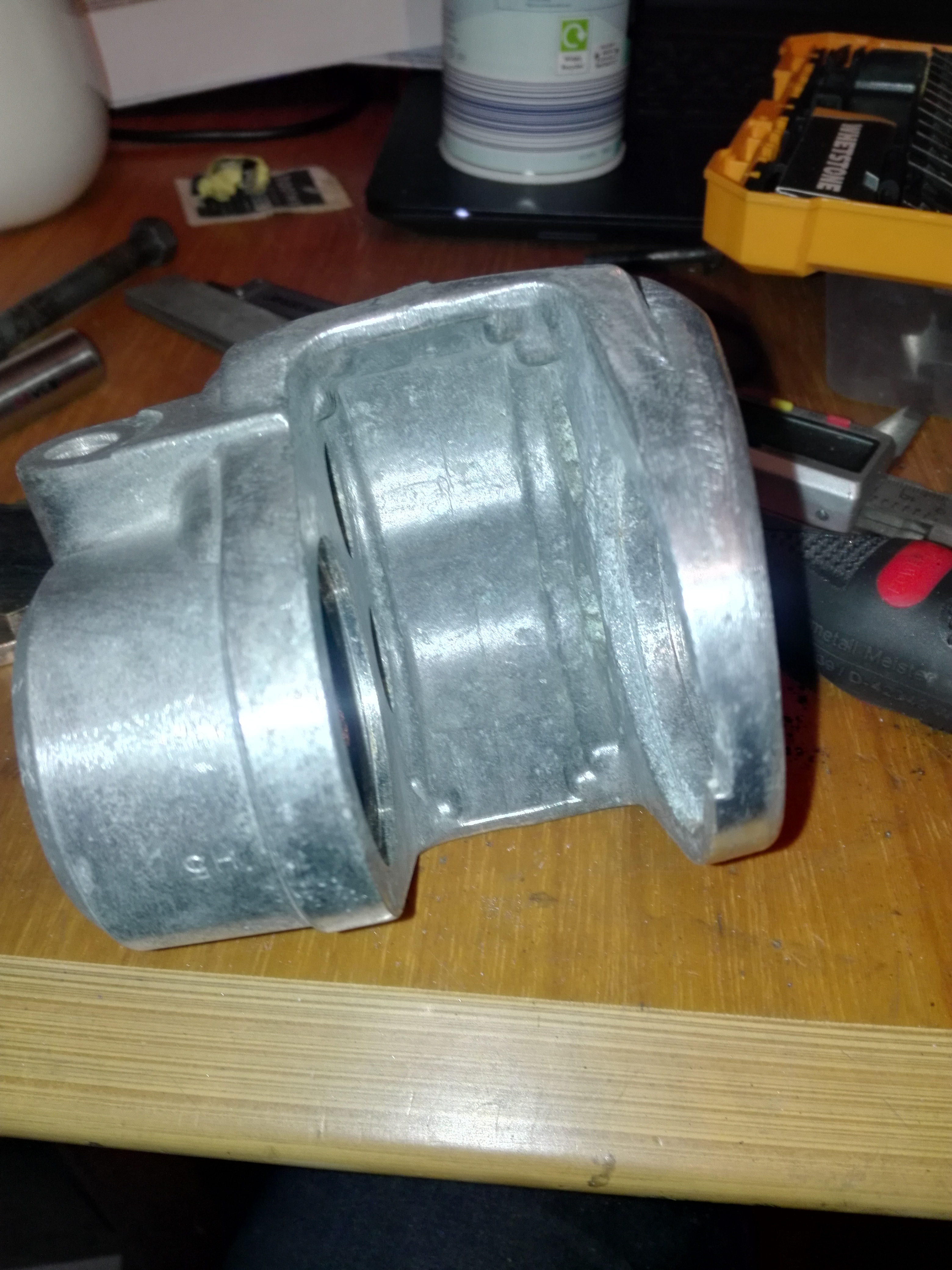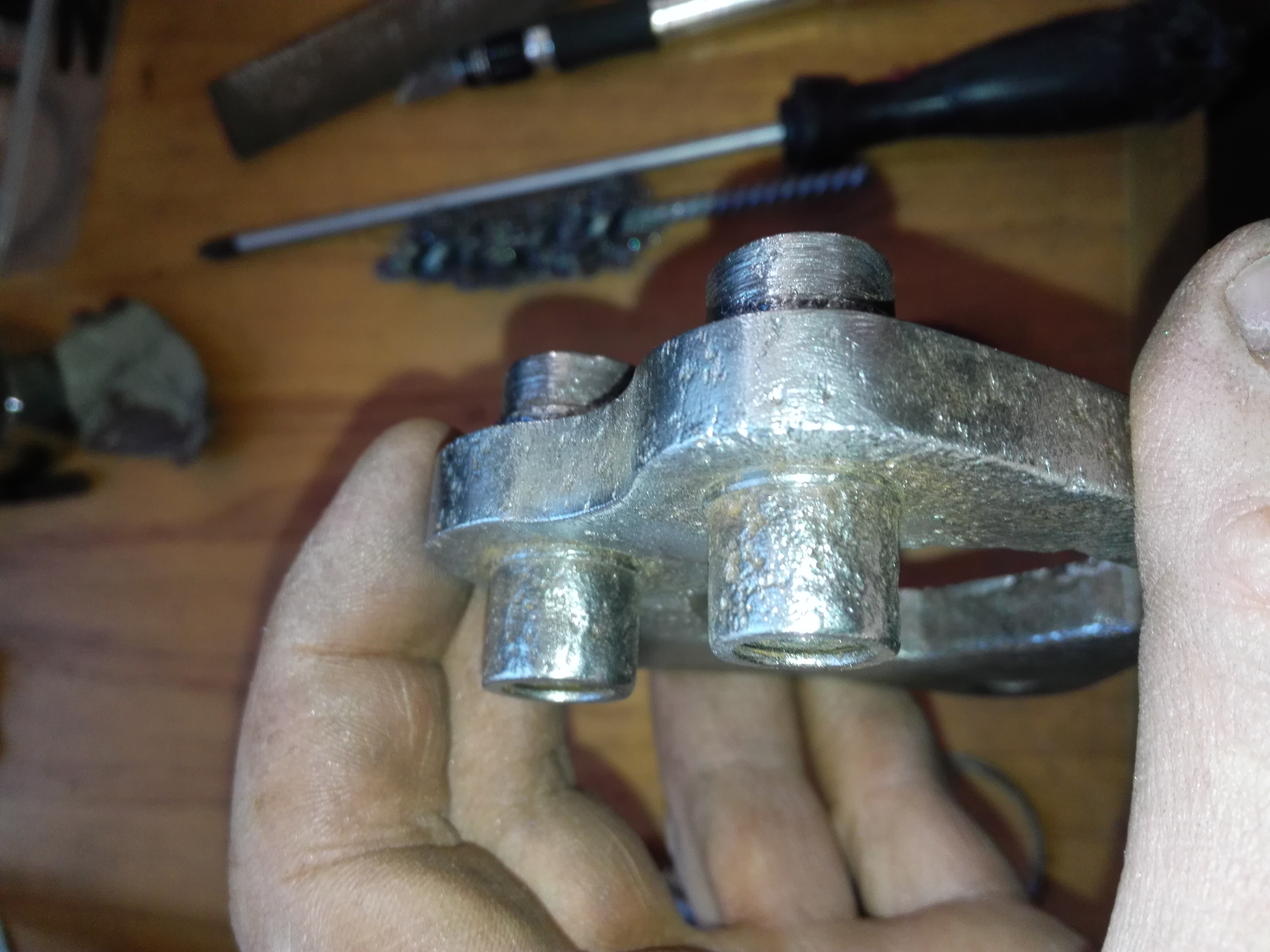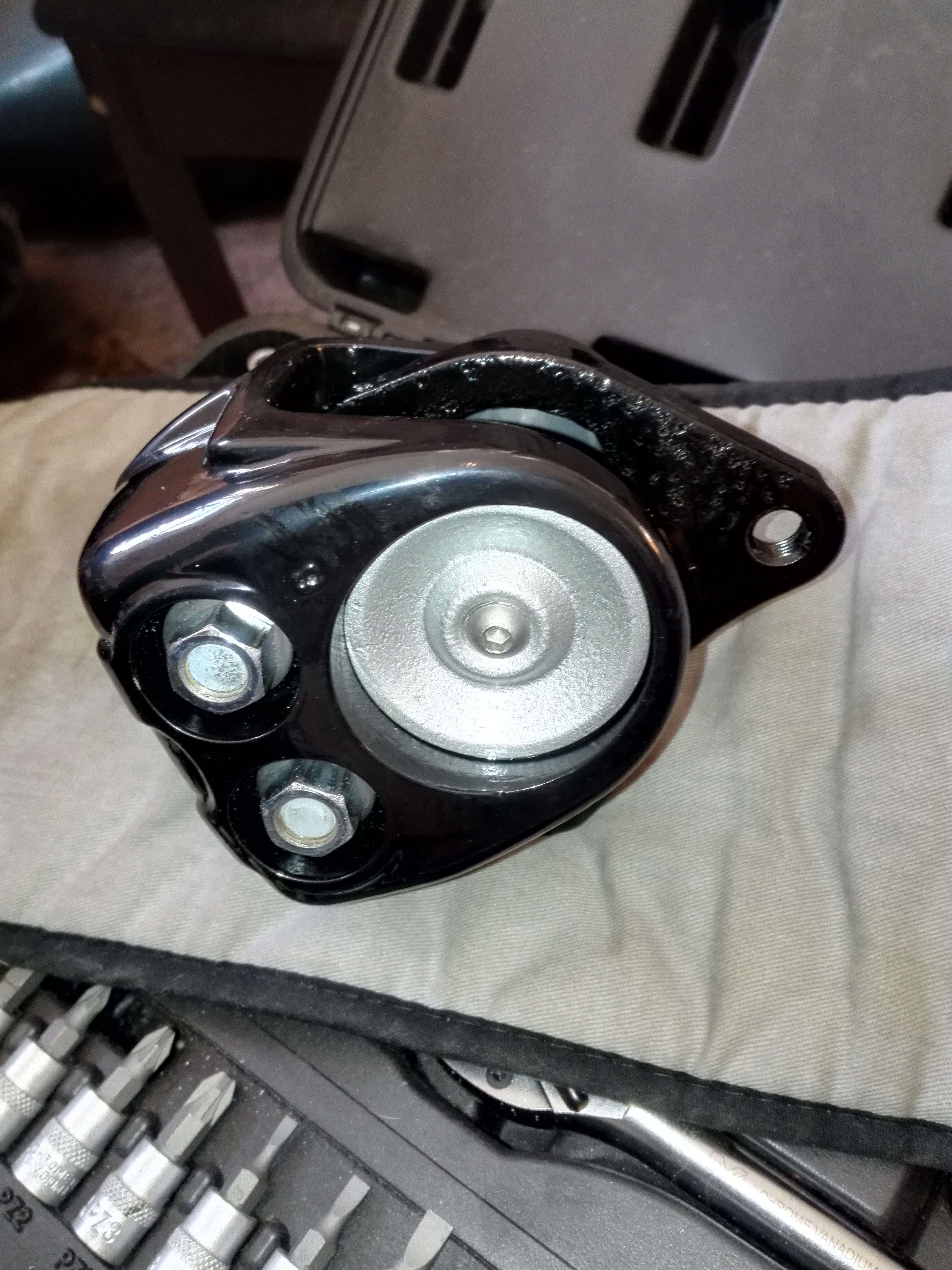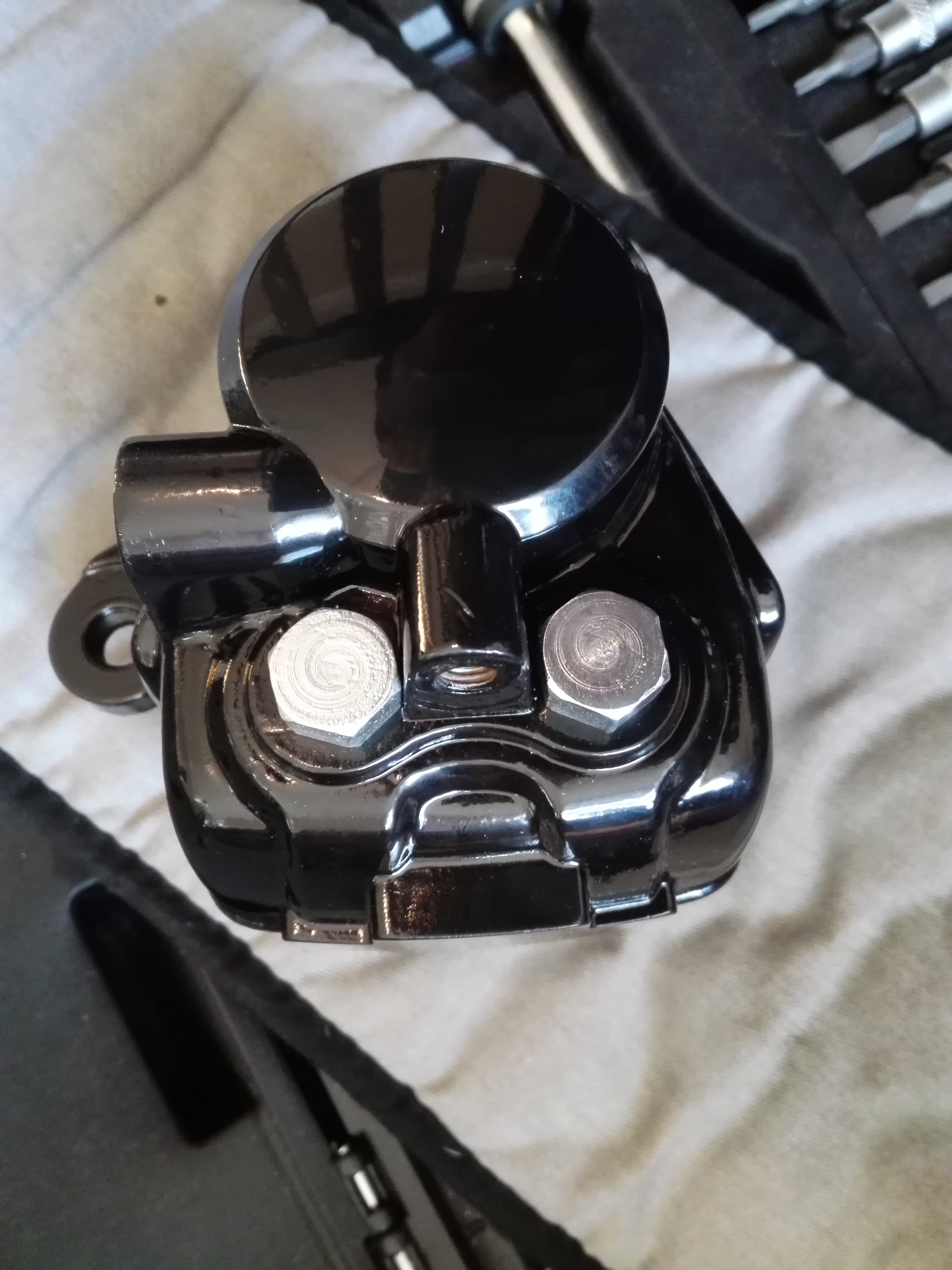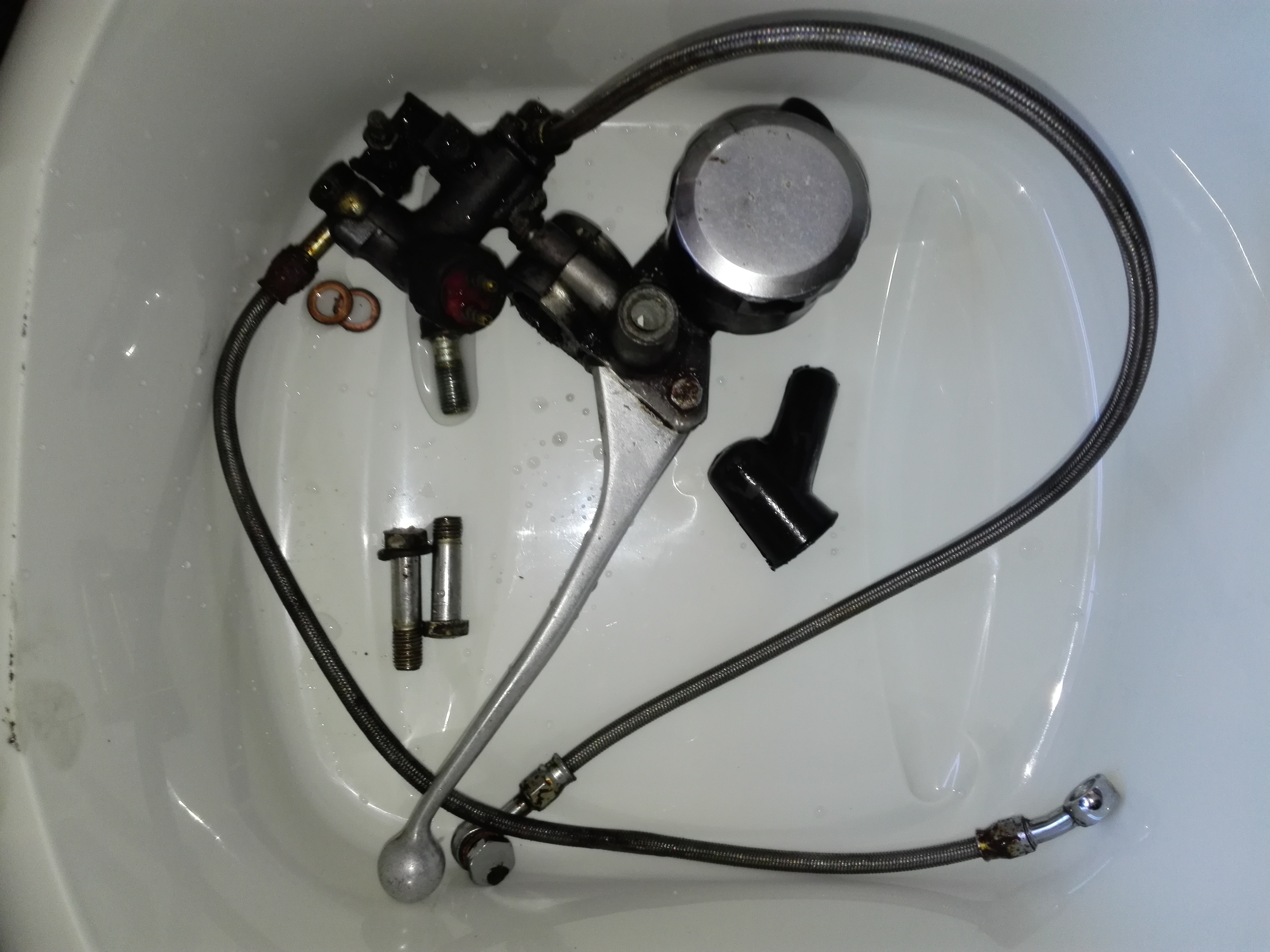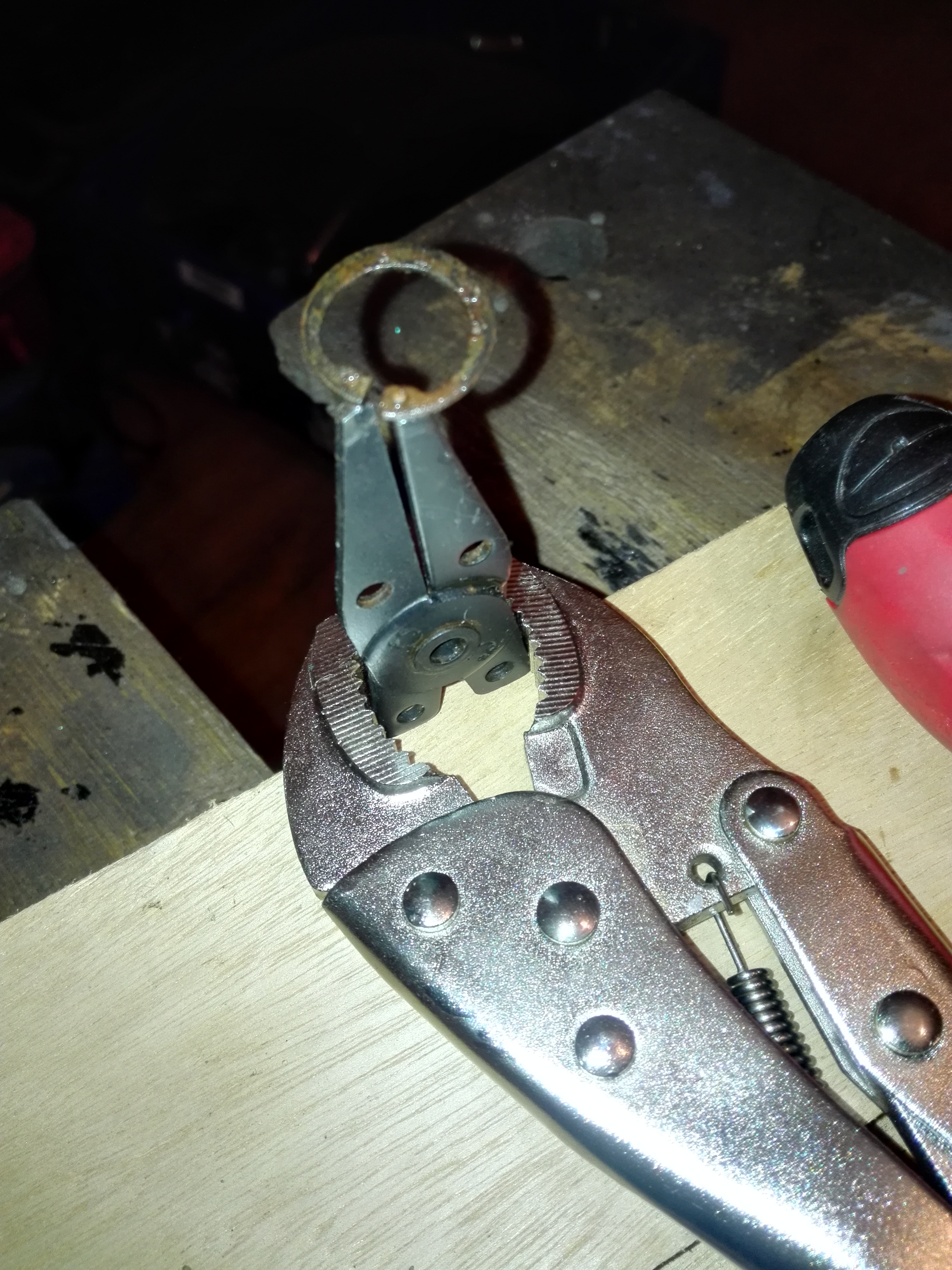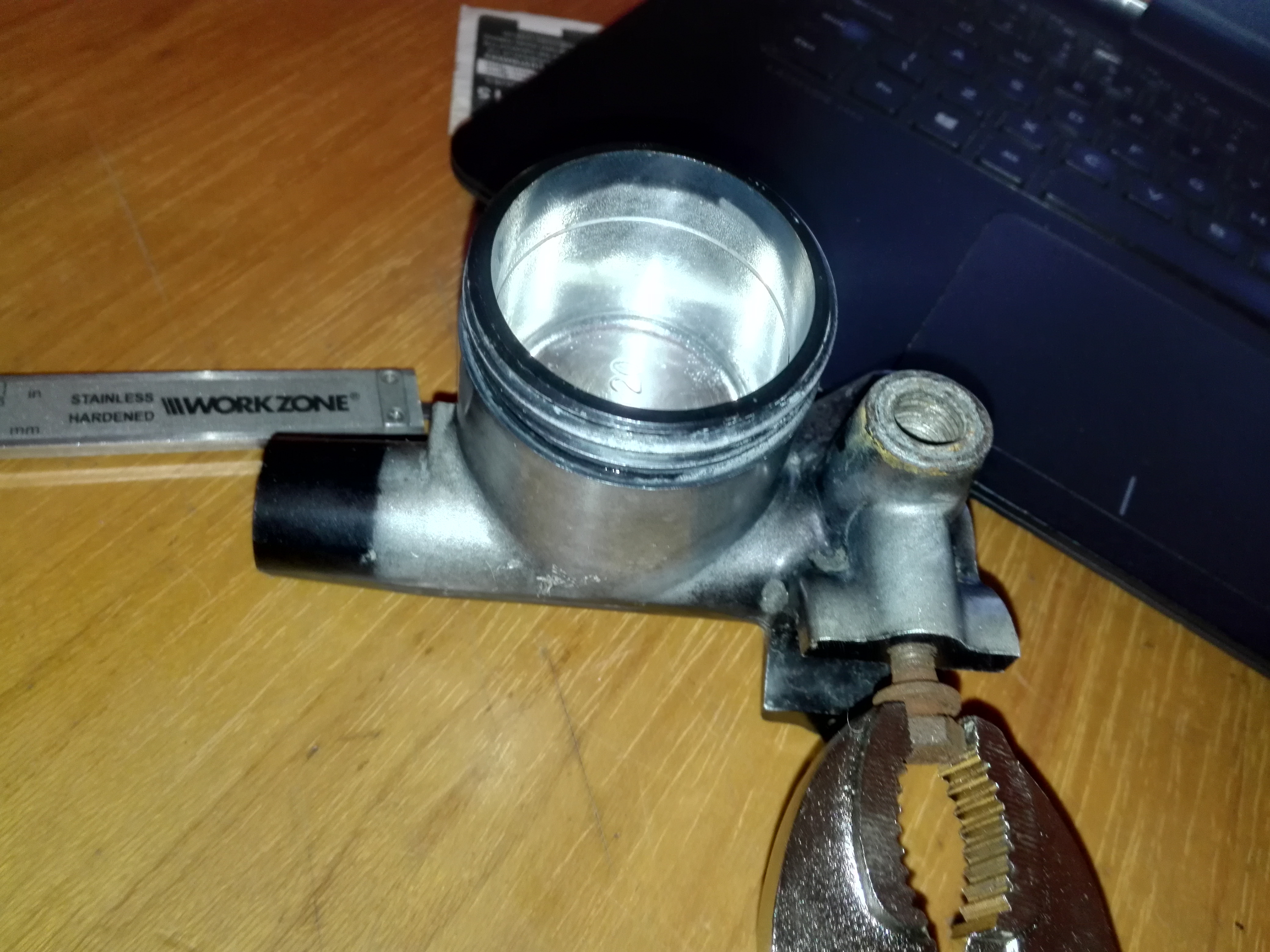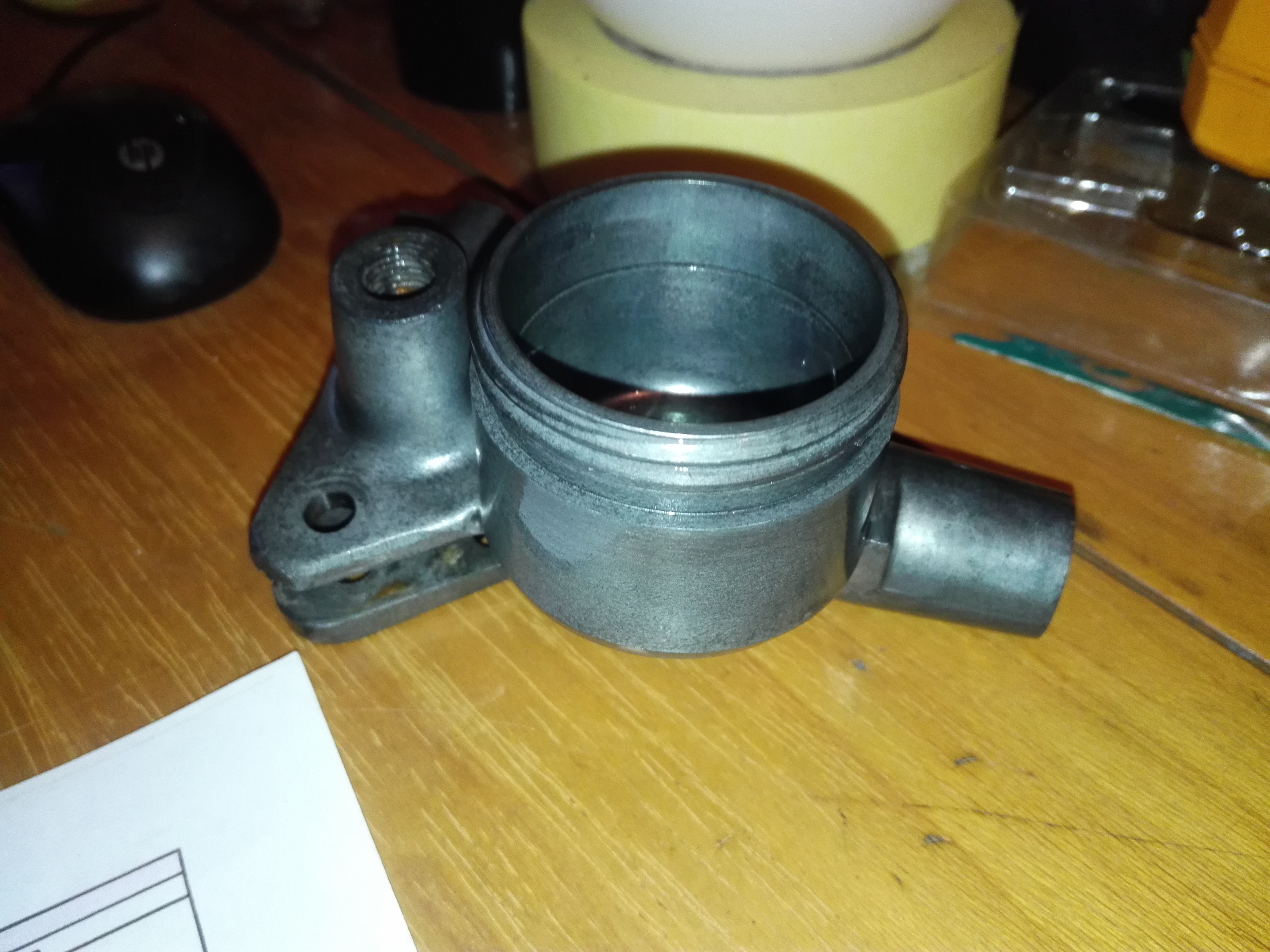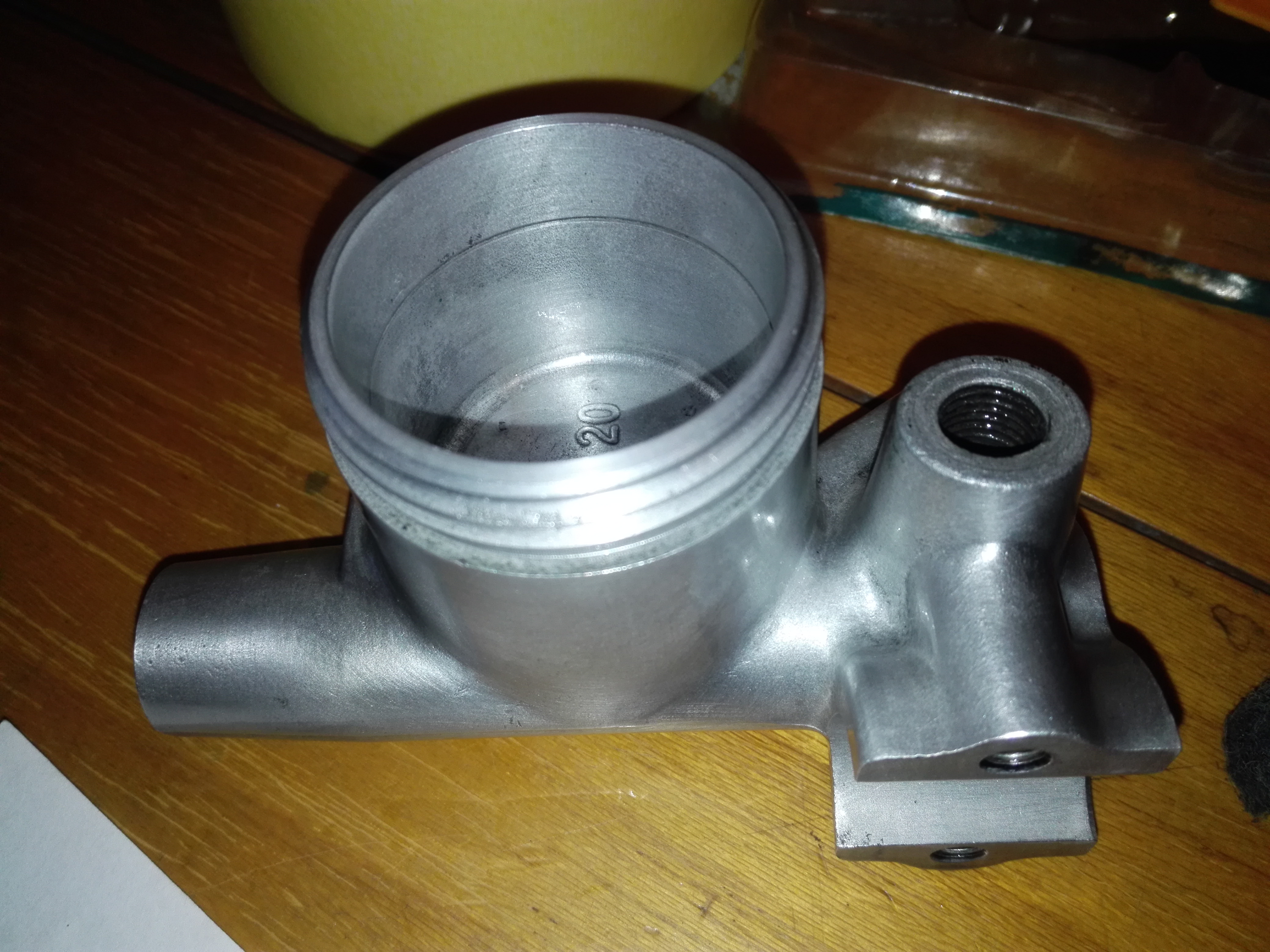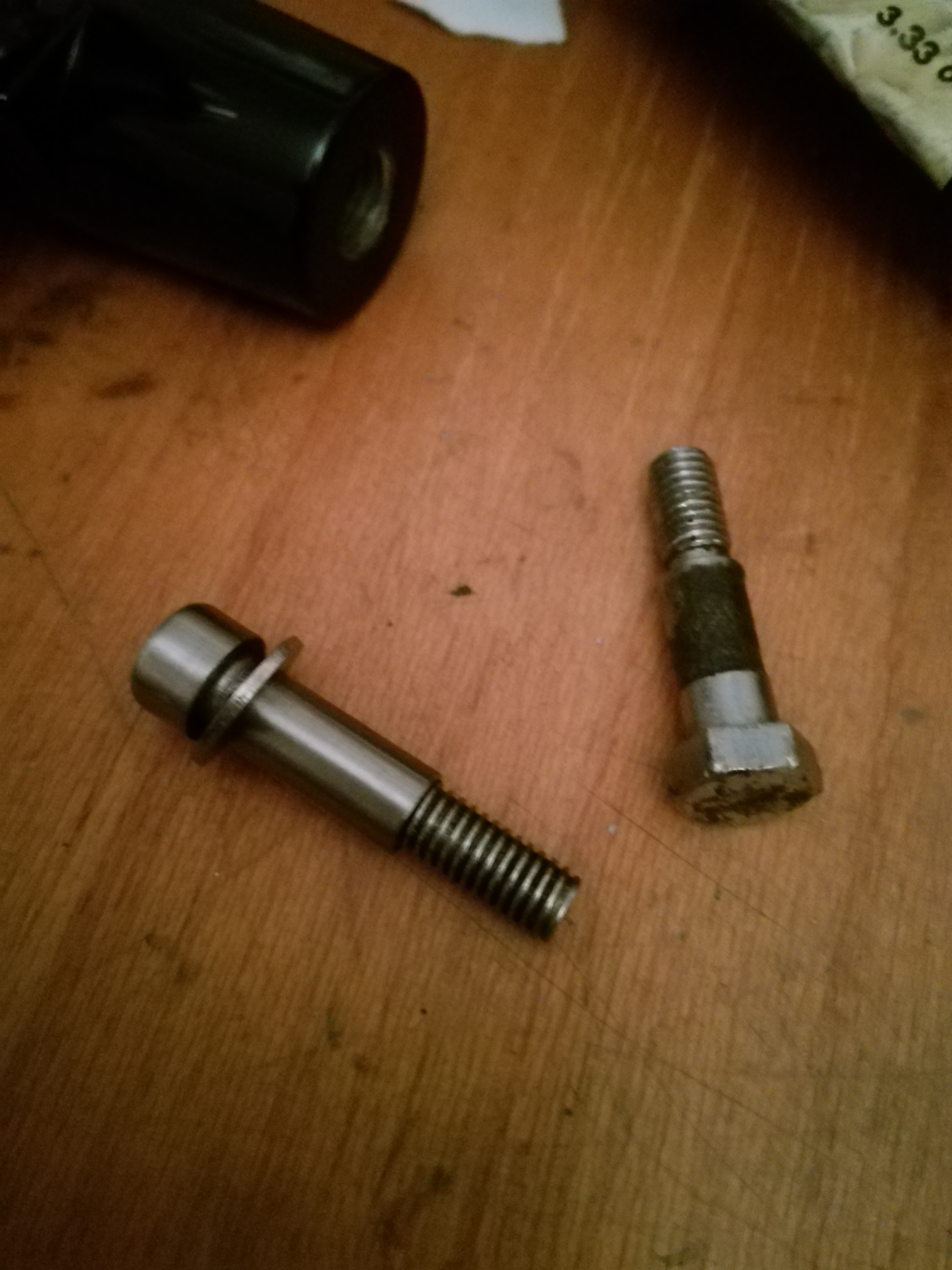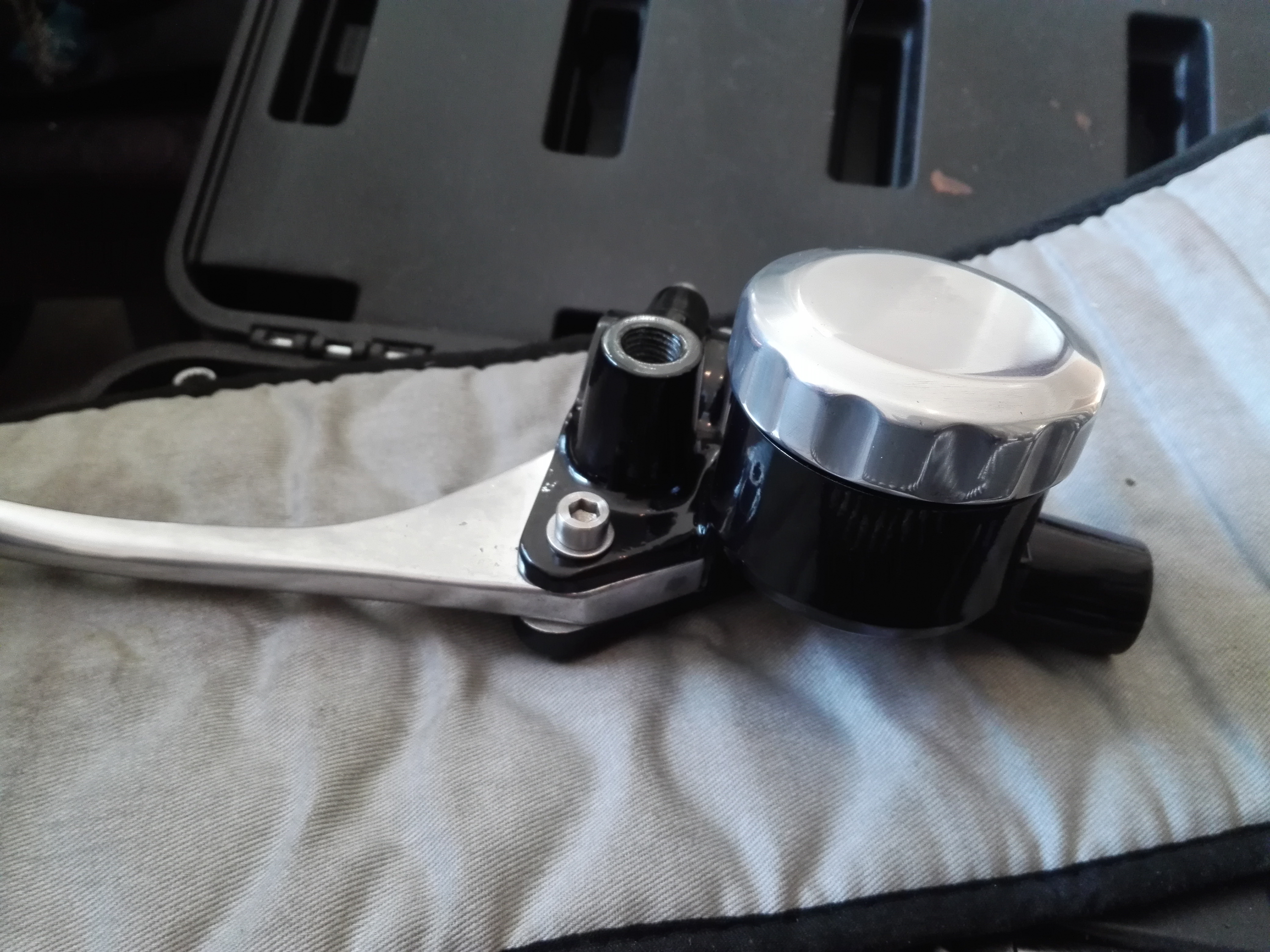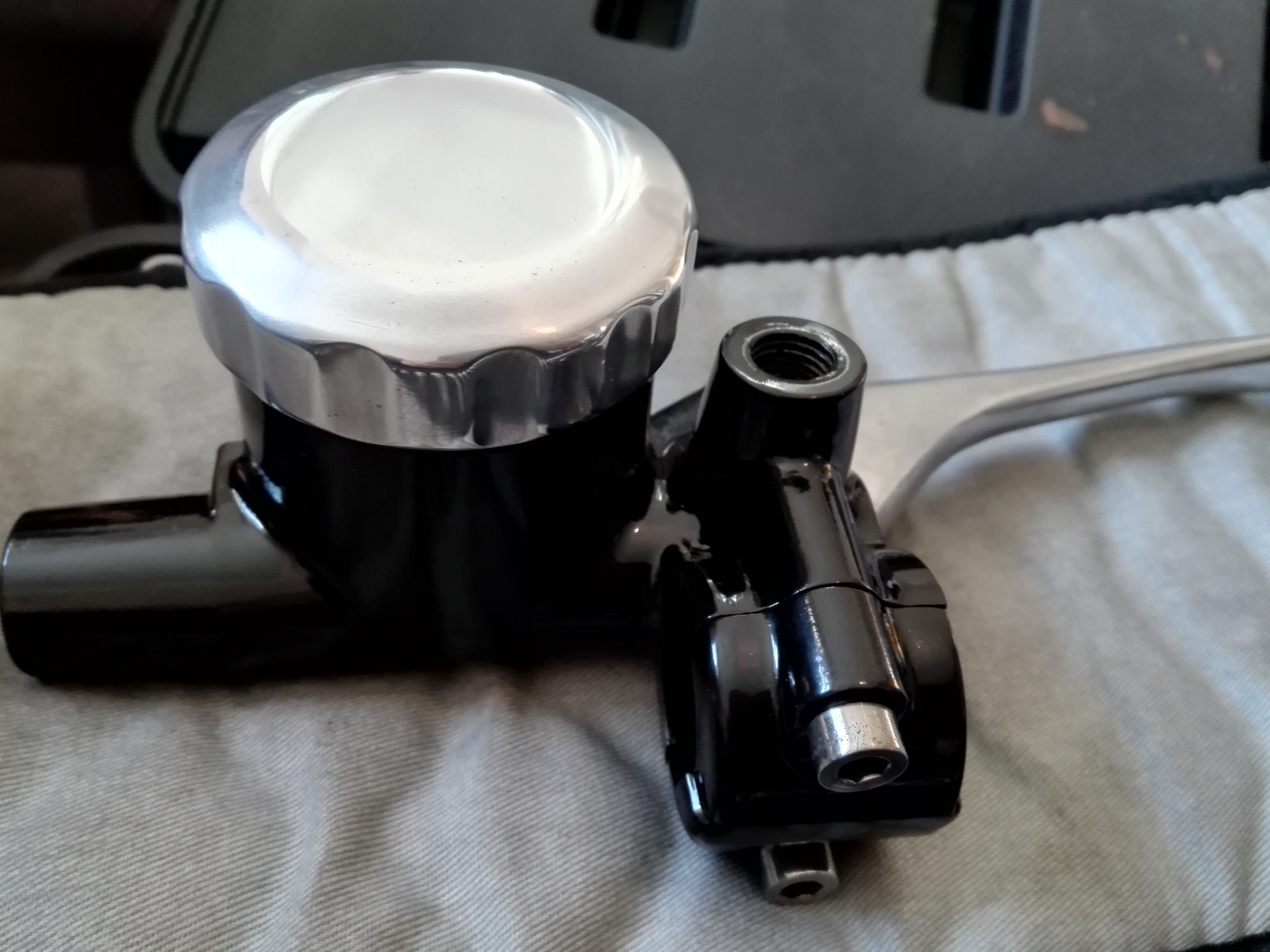Forum Replies Created
-
AuthorPosts
-
23rd December 2018 at 12:12 am #24565
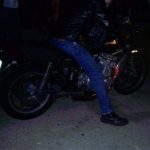 Ownthesky2010Participant
Ownthesky2010ParticipantI’m trying to keep up the momentum but the season seems to get in the way a bit. Still, I am getting bits and pieces done. I turned my attention to the brake discs and started on the rear one.
There is a bit of a ridge as expected and I decided to clean it up a bit. If you object to taking a file to a brake disc then look away now. Files may be a bit crude and imprecise but they have been part of precision engineering for ages. Don’t try this at home unless you are very confident. The first step is a wire brush to clean the centre and then it get covered in marker pen so I can see what I’m doing.
As you can see, I’m not taking anything off in the area where the pads have been in contact
Here you can see how much metal is being removed
And that’s the first stage done.
Next it gets a fresh coat of marker
And then another filing operation but in the opposite direction to help remove the deep scratches and flatten it all.
Then I coated it in marker again as I wanted to try a draw filing operation in the direction of rotation as a final smoothing process.
In process
And done. As you can see I haven’t touched the area where the pads have been in contact.
After cleaning
And after a bit of sanding to clean it all up.
Its quite flat
The back doesn’t look great either. Its a bit trickier with the raised centre.
First it gets wire brushed
Then more marker pen
I have to do the back at a weird angle but its working.
Op 1 complete
Second filing op complete. I cant draw file this side unfortunately.
After sanding.
Masked and painted
With the masking removed. I prefer to scrape paint edge.
Cleaning the edge with a knife blade
All done
And the back
Now I just need to sort out the fasteners. Here they are after a wire brushing. I’m going to drill them for wires, same as the sprocket.
This is a bit low tech. I just centre punched them by eyeball using a countersink.
Drilling slow and steady with lots of stopping for sharpening. Quite tricky to sharpen these little drills. Despite my best efforts I broke 2 drills.
Last one
All done and countersunk ready for plating
After plating
Looking good but I’m going to make some washers.
The front disc got the same treatment and this is the result
I still need to sort out the bolts for the front disc.
-
This reply was modified 5 years, 4 months ago by
 Ownthesky2010.
Ownthesky2010.
19th December 2018 at 10:19 pm #24513 Ownthesky2010Participant
Ownthesky2010ParticipantI kept all the hardware for mounting the sprocket as I planned to re-use it all but once I inspected the nuts and bolts they were clearly not in a good state. The threads were quite damaged. I thought I could at least re-use the locking tabs if I flatten them out again so I started cleaning them but I wasn’t really happy with the result.
I decided to replace the lot but I didn’t have a lot of success finding the parts so I changed my mind and decided to go with stainless steel. The original bolts have a square head and they are installed from the rear of the carrier with a nut on the outside of the sprocket. Standard stuff. They are M10 fine but I replaced them with standard M10. I had to reverse the fasteners and use a square nut at the back of the carrier and a bolt from the outside of the sprocket. The bolts I like have a large flange so I’m planning to use locking wire instead of tabs because I think it looks cool.
This photo shows the original mounting bolt and nut with the replacement stainless steel units. There is quite a lot of modification required.
First off the nuts are milled down to fit. I made them a bit bigger than the original bolt heads as they were a bit of a loose fit.
Next I started modding the bolts so they went into the lathe
First the heads were faced clean. At this point I found that the heads had quite a lot of runout. Not good.
Then I drilled the core out of the heads with an 8mm drill and finished with a 10mm end mill to create a flat bottomed hole. This is mainly to make it easier to drill the holes for the locking wire.
Next they went into the rotary table in the miller for the holes. I was only doing spot drilling to locate the holes to be hand drilled as the holes are quite small and I didn’t want to break any drills. There was so much run-out in the bolt heads that I had to do this manually. If I had programmed this operation the depth would have been allover the place. As it went, most of the holes were quite far off the center.
The bolts are now spot drilled ready to be drilled through.
And then all drilled through with their nuts, ready to fit. I gave them a once over with the scotch brite wheel but I didn’t polish them.
I polished the center of the sprocket carrier and fitted a new seal and then installed the sprocket. Looking good so far. The bearing feels fine so I see no reason to change it.
A view from the back showing the new nuts.
They are a little taller than the original hardware but I’m hoping they will just compress the rubber dampers a bit more.
And finally wired up. I haven’t done much bolt wiring before but I’m happy with the result. Compare this with the way it looked before 🙂
19th December 2018 at 9:43 pm #24512 Ownthesky2010Participant
Ownthesky2010ParticipantNext up is the sprocket and carrier.
The sprocket looked like it would still be ok but would need a lot of cleaning. There was a lot of rock-hard chain lube on everything. This stuff had to be chipped off with a blade.
Its really thick
Lots of chipping later and its ready for wire brushing
I started the wire brushing on the teeth to check the condition. Hardly worn at all. This sprocket should still be good.
After a lot of wire brushing its all clean. I had planned to plate it but it wont fit in the tank so I will paint it instead.
All painted, fresh from the oven and looking spiffy 🙂
Now to tackle the sprocket carrier.
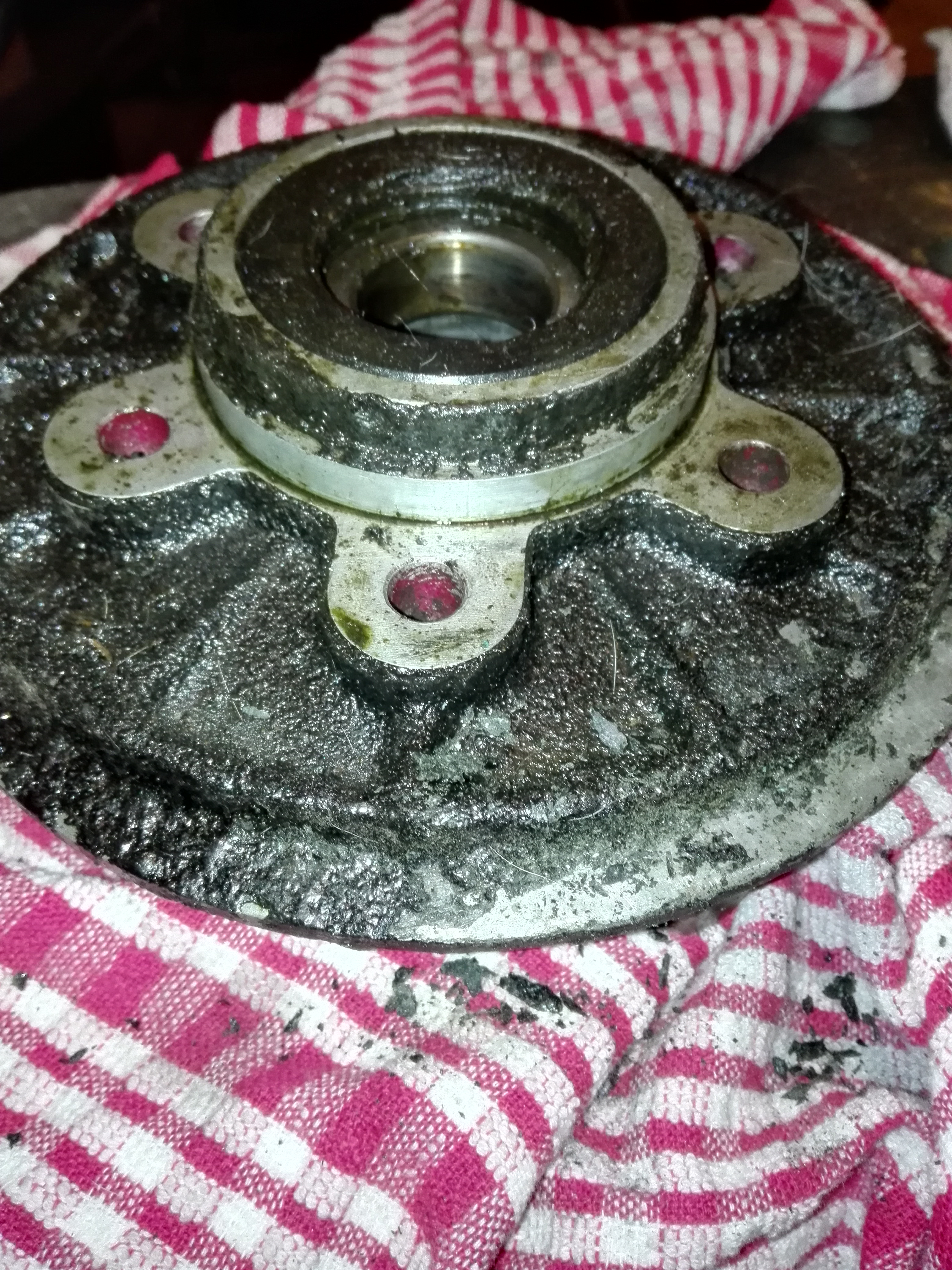
I treated it to the same scraping and chipping as the sprocket.
That’s the easy part done. The only way I could shift the stuff in all the recesses was with a small screwdriver and a lot of patience.
It took ages to get it like this. I followed up with some steel wool and scotch brite. There is still too much oxide to paint this so I decided to just wire brush instead.
After wire brushing its ready for paint. I also did a bit of sanding to the outer rim. The scratches aren’t too deep for paint to fill.
Masked and ready. I masked up the whole area above the sprocket and I plan to just polish that part after painting.
After a couple of coats of paint
And with the masking removed. Look pretty good I think.
19th December 2018 at 9:17 pm #24509 Ownthesky2010Participant
Ownthesky2010ParticipantNext the rear wheel gets the same treatment. I managed to remove almost all the spokes but I still broke 2 of them. I have resigned myself to replacing them all now. The rear rim is also completely shot and will be replaced.
Once the spokes were removed and the hub could be inspected I found a problem. The sprocket side of the hub is cast aluminium but the disc side has an outer ring of steel that’s chrome plated. This is going to be a bugger to repair.
After a bit of cleaning its clear the chrome on the ring is bad. I’m going to have to strip the chrome off to paint this. I’m not sure how yet but tried a few ideas. Its obviously going to he much harder to sort out on the inside but that’s something to worry about later.
First I tried a bit of sanding with coarse paper to remove the flakes
Then a stainless steel rotary wire brush to dig out the rust. This left deep craters.
Then a flapwheel on a drill to smooth it all out. Not bad. There is still a bit of nickel left on it but most is down to the steel. I will try something similar on the inside and then the whole thing will be sandblasted before painting along with the front hub. I haven’t ordered the rims yet so there is no rush.
19th December 2018 at 9:03 pm #24508 Ownthesky2010Participant
Ownthesky2010ParticipantNext up I started on the front wheel. As with everything on this bike it was covered in a thick patina. Many of the parts have been preserved by this but unfortunately the wheels both have a lot of corrosion. The rims are probably dead but I might be able to re-use the spokes.
First off the disc is removed
Next the tire comes off, an absolute pig of a job.
I tried cleaning the rim a bit and its definitely too far gone. The corrosion is worse on the inside.
Don’t forget to take some measurements before stripping the rim.
I did my best to unscrew the spokes but they were all seized solid so I ended up buying a pair of bolt cutters to remove them. Pity as it can cost up to £80 for a set of spokes.
Here is the hub after cutting the spokes.
I attacked it with a wire brush and scotchbrite wheel but there is no way I will get it clean enough like that so I’m going to sandblast it and then paint it silver. It will look pretty good with new spokes and a new rim. I also plated the axle bolt and spacers while I was at it and then did the rear axle bolt and swingarm bolt too. I cant fit the long bolts in the plating tank so I just plate the ends as can be seen in this photo. This plating kit is coming in very handy.
19th December 2018 at 8:47 pm #24492 Ownthesky2010Participant
Ownthesky2010ParticipantBack again after a bit of a break. Work hasn’t stopped but it has slowed down a bit as other priorities take over. Also, I have been working away for a few weeks which makes it difficult to find the time to work on this. I have managed to get a few bits and pieces done.
While I had the sprocket cover in my hand I decided to sort a few bits out so it got a good clean in solvent.
I stripped the clutch actuator and plated the parts and then reassembled with new grease. The balls and seal looked ok. There is a bit of wear to the screw but its smooth enough.
I took a file and some sandpaper to the outside but I wont polish it until later. It should come up nice and shiny.
18th November 2018 at 6:25 pm #24417 Ownthesky2010Participant
Ownthesky2010ParticipantIts been a couple of busy weeks and I haven’t had a lot of time for this project but I have decided its time for the rest of the bike to get stripped down.
I have taken the wiring harness off to repair it and done a few small bits and pieces but I want to try and start the motor before stripping the bike down so I can get some idea of its condition. If it runs ok with no knocking or smoking then I shouldn’t need to take it apart. I made up some temporary wiring for the ignition system and oil light and put the carbs pack on. I cleaned the points but I didn’t even look at the ignition timing or check carb float heights or balance. Here is a short video of the result.
I am going to take the rest apart now and start prepping the frame for powdercoating.
More to follow.
30th October 2018 at 8:17 pm #24371 Ownthesky2010Participant
Ownthesky2010ParticipantNext I decided to tackle the rear shocks. These are Marzocchi Strada shocks that were often fitted as standard equipment on Italian bikes of the era. They were sometimes fitted as upgrades so I decided to keep them and do them up. They are rebuildable if the chrome on the shaft is still good but the kit costs £300 and a new set of RFY shocks would cost £65 so I will just replace them if they are in bad condition. I decided to do them one at a time so I can still wheel the bike around as required.
This is as it came off the bike.
It got a good clean and I knocked up a few bits to make a spring compressor.
Next I used a 32mm spanner to remove the nut and get all the guts out. The shaft was ok but the main seal was quite hard. I tried to match up a seal but they use a rotary seal instead of a linear one so I just purchased a pair of seals with the same dimensions. The lip is a bit lower but I think it will work. At this point I tried to remove the cap from the gas cylinder part and it was seized solid. I was using and adjustable pin spanner for an angle grinder which wasn’t working so I decided to make a special socket. I drilled out the holes on the cap a little bigger to repair the damage to them and added another 2 holes to increase the drive surface area.
Here are a few photos of the process of turning an old bolt head into a special socket.
I did the hex in my milling machine and then drilled it for the pins. I had planned to just use super glue to hold in the pins but I decided to leave them loose so I could use the socket as a drill jig to add the extra holes in the other shock.
The hex is 19mm
Here it is with its holes
And with the pins mounted. I machined the pins to a slight dovetail so they bite in under pressure and wont slip out. I managed to mess super glue allover the place but it will all just clean off.
Here it is in use.
The cap was very tight so I used a long bar and a lot of force but eventually it gave up and came loose. You can see the modified cap in this picture. This modification worked very well.
The bladder turned out to be free of leaks and in good condition. Hopefully the other one is the same.
Next the bodies were stripped and painted with more Aldi paint. All the photos I have seen of these are red so that’s what I used. Its not an exact paint match but looks pretty good. The springs were sanded and repainted black and the aluminium parts given a scotch brite treatment. I didn’t strip all the paint off the springs as I know it can be difficult to get the paint even on the inside of the coils and I didn’t want to put it on so thick it would take weeks to dry. I also didn’t like the way the preload adjuster wobbled around on the body and it looked like the spring would be rubbing the body too so I decided to make a spacer to align them. You can see it in the following picture. It adds 4mm to the height so it will result in slightly higher preload but I will assemble these on their lowest setting and see how it goes.
Here is a better picture of the spacer
Next the whole thing was reassembled with new oil and the new main seal. Then the spring compressor was used with a bit of masking tape as protection. You can also see the fresh plating on the drain screw.
And here is the end result. I’m quite happy with it. I still haven’t decided on a colour for this bike. The V5 says green but it should be red which would match these shocks well 🙂
More to follow
30th October 2018 at 7:34 pm #24370 Ownthesky2010Participant
Ownthesky2010ParticipantI decided to finish the brake parts next. I couldn’t get the rear caliper off without forcing the piston back in so I will wait until I take the back wheel off for that but I finished off the other bits of the brakes. First the front splitter
I bought a scotch brite wheel for my drill and used that after an alkaline soak and this is the result.
Then light assembly with new stainless banjo bolts and a freshly plated bracket. I also re-plated the sensor but didn’t take any photos.
Next I did the same to the rear master cylinder. This got new main and cup seals matched up from ebay and a bit of reassembly. I didn’t spend the big bucks on the official rebuild kit as there were other kits that used the same 5/8″ seals. Turned out great I think.
Rear shocks next
30th October 2018 at 7:20 pm #24369 Ownthesky2010Participant
Ownthesky2010ParticipantThe next thing I decided to tackle is my plating kit. I got it off ebay and it works but I have had a few issues with weird rough patches in the zinc plating and yellow chromate that just rubs off.
I resolved the chromate issue as it turned out I’m dipping it for too long so I just dip for 3 seconds now and repeat for a darker yellow if desired.
The issues with the finish of the zinc I put down to current control so I decided to do a few upgrades.
This is the zinc anode arrangement as it came with the kit
I ordered some thick copper wire to build a rack to hold the anodes with some croc clips for easy removal.
Much easier and now I can just plate what I need as I go along as it takes seconds to set the tank up.
The kit came with a very crude variable resister to limit the current and I have been using it with a 12v battery charger.
I replaced it with a cheap but very useful power supply and now the kit if working very well. I just take the lids off the various buckets, mount the rack and anodes and I’m ready to go.
Now that it was all set up correctly I decided to do some of the carb parts I had been putting off. They came out quite good. Especially the choke lever.
I had also been mulling over a solution for some of the chromed bits. The brake pedal is in excellent condition except for a scrape on one side. I have read that zinc wont stick to chrome so I theorized that I could plate zinc over the damaged area and then clear chromate and it should only stick where the chrome was missing.
This is the damaged area
The rest of the pedal looks good
I filed and sanded the dodgy parts and prepared them to plate
Then after plating and chromate this is the result. The zinc seems to have stuck to the chrome too. I’m guessing it will rub or flake off at some point but it should stay stuck on the damaged parts. Who knows.
I tried the same trick on the kickstart mount and it had the same effect. This part was missing a lot of chrome but it looks acceptable now. We will see how long it lasts.
The kickstart lever got the same treatment after a lot of wire brushing. I dont have any pics after plating but I have left it outside in the weather to see what happens. I will leave it for a few weeks.
30th October 2018 at 6:39 pm #24324 Ownthesky2010Participant
Ownthesky2010ParticipantThanks Tango
I haven’t worked on a bike for many years so please feel free to tell me when I’m doing something stupid 🙂
I’m pretty much making this up as I go along
11th October 2018 at 9:12 pm #23912 Ownthesky2010Participant
Ownthesky2010ParticipantClocks next. This is as they came off. Quite rusty but definitely usable. They can be tricky to get apart and a lot of patience is required. They cant really be repainted while they are still together.
The rev counter in all its bits. It was seized solid so I had to tear it right down.
Rusted solid but with a bit of wd40 and a lot of waggling its fine now, woohoo.
There was a dent on the outside and it transferred to the inner sleeve. You can see it at about 2 o-clock. I just bashed it out with a screwdriver handle and cleaned it.
Despite its age the clock face still looks nice.
Lots of stripping and cleaning on the shells
Many coats of paint later
One of the trickiest parts is getting it back together. First careful bending with a hammer and screwdriver
Then crimped flat with vice grips with masking tape as protection. There are probably better ways of doing it but this worked acceptably well.
I’m happy with the end result
On to the mounting bracket.
I decided to blast this as its just too complex. I don’t have a cabinet or even a decent compressor so I use this as a last resort. On some jobs its the only way.
I will paint this black and make new rubber pads from mouse mat. I did the same thing to fix my orbital sander and it worked well. The clocks are looking ok I think. I need to get some plastic restorer and to finish all the mounting parts. This is just loosely put together.
11th October 2018 at 8:50 pm #23911 Ownthesky2010Participant
Ownthesky2010ParticipantOn to the rear MS next. I really struggled to get the reservoir off and in the end I carefully levered it off using brute force and a kitchen knife. It turns out it just screws off. Luckily the threads are still usable.
I didn’t like the state of the clevis bolt so I decided to repair it
I machined the rusted area down
Turned a sleeve with a press fit
Pressed on and now looks good
I checked the fit and its spot on. I prefer to repair rather than replace if I can
After zinc plating but the chromate just rubbed off. I have done a bit of reading and I know where I’m going wrong so I will have another go at the weekend.
You can see here that the chromate only stuck in a few patches.
I stripped the anodizing off the lid but there was quite a lot of damage so I machined it flat in the center. Unfortunately this removed the lettering but after polishing it looks ok. I just sand down to 1200 grit and then use Autosol or as my girlfriend calls it, Anusol :):):) I used to use a lot of fine paper down to 2500 grit but I find that just creates work and 1200 is good enough.
This is a GS550 clutch cover I did the same way. To me its just the right amount of shiny. You can still tell its aluminium. Incidentally, I had to rebuild one of the mounting lugs with some of that low temp aluminium repair rod. I will need to do the same on the kwak on one of the mudguard mounts on a fork leg as its broken off. It worked well on this cover but I did get a blow hole. Its the lowest lug in this picture.
11th October 2018 at 8:26 pm #23908 Ownthesky2010Participant
Ownthesky2010ParticipantFront caliper next. It looks worse than it actually is. They can be difficult to get apart so its best to loosen all the nuts and bolts while its still on the bike. The bleed nipple was very difficult but a lot of patience paid off.
I used compressed air to get the piston out and the front is very rusty but the rest is ok so I can probably re-use it.
Stripped and ready for paint
I wire brushed the daylights out of the mount after a good acid soak. The threads and the bores are the important parts and they are ok so I will just paint it. Most of it is invisible anyway.
Painted but no seals in it yet. Waiting for them to arrive. I re-coated the bolts and nuts in Blue chromate but I’m not convinced it worked properly. I think I will re-do it with the yellow chromate. I will use new stainless banjos and nipples when they arrive.
You may have noticed my cat teacup. My girlfriend got it for me as I like cats and tea. It takes 2 teabags to get a full shot in it :):)
11th October 2018 at 8:10 pm #23907 Ownthesky2010Participant
Ownthesky2010ParticipantFront Brakes stripped off and ready for refurb. I think I will replace the hoses as the chromed fittings are rusty. First need to do something about the master cylinder. These are usually anodized rather than painted. Its easy to tell as the top half is sun-bleached and the bottom is still black. Easy to remove with a strong alkaline but it will attack the aluminium too so you have to watch it.
I had to get creative to remove the circlip. Amazingly this worked.
Ready to go into the alkaline, you can clearly see where the rubber cap protected the finish from the sun.
After a good dunking
A bit of scotchbrite to smooth everything over.
While i was at it I did the lid too. My plan is to polish the lid and lever and paint the body black.
Trying something different by creating a new shoulder bolt from a stainless cap screw with a washer and sleeve. If it works I will loctite it all together.
End result looks ok I think
-
This reply was modified 5 years, 4 months ago by
-
AuthorPosts

